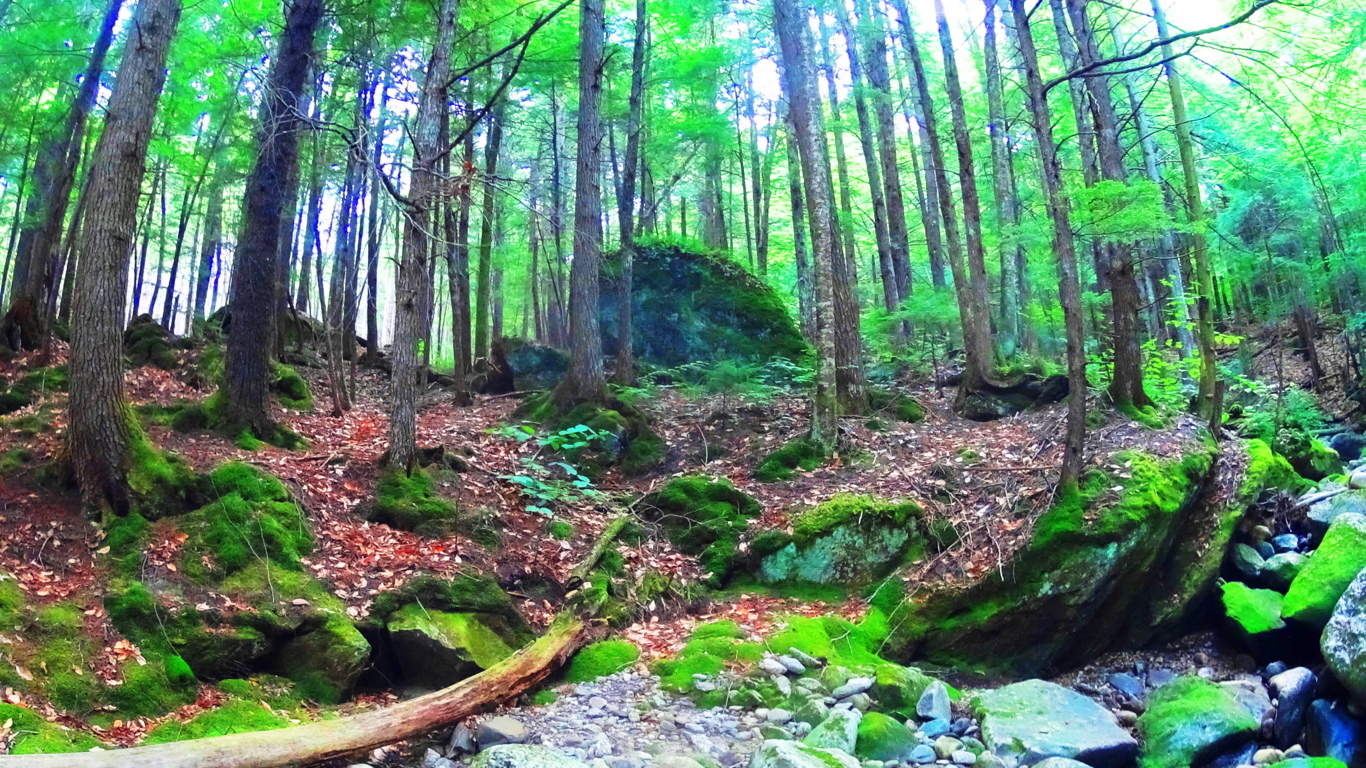Ashburnham State Forest Reserve
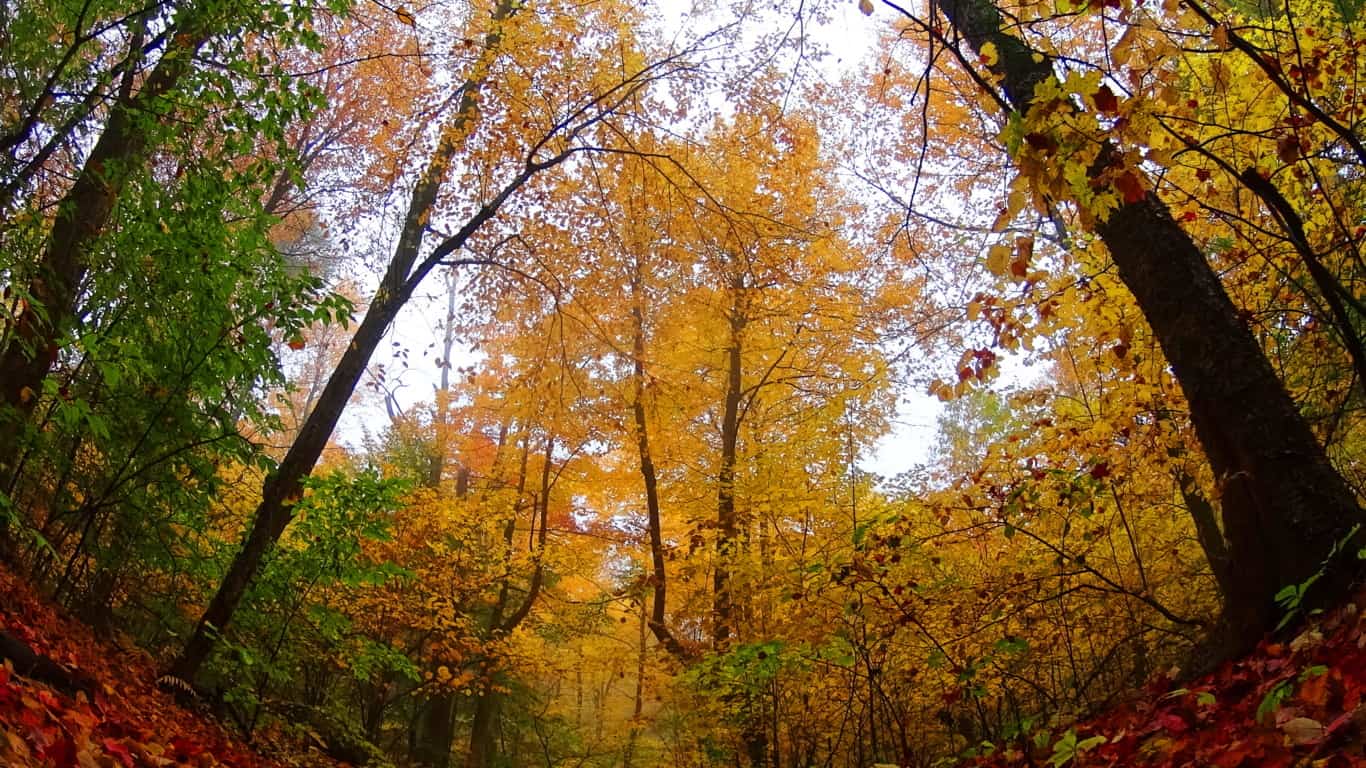
Location: Ashburnham, Massachusetts/USA
Note: The natural beauty of trails in New England, particularly in Fall, is such a blessing for those seeking a break from the suburban inundation that is the trademark of world wide modernism. That’s a mouthful of fancy words for those just seeking a peaceful, compelling, and pleasant space to hike, which Ashuburnham’ definitely is. The paths here are wide and welcoming, with golden leaves literally lining the forest floor. Mingled into these golden pathways are collages of foliage, rusty-red and green with pillar size Pines, Ash, Elms, Birches, Oaks, and Maples arching over the pathways. There are several trails in Ashburnham’, most of them running north to south towards Mount Watatic Reserve about 7 miles away. The Lincoln Pond Trail is the main route through Ashburnham’ which is gladly featured in this article. This is the ideal place to keep in mind that in so many stories forests are places of enchantment. From Grimm’s fairytales to Shakespeare’s magical midsummer backdrops, historically in literary works forests have been places where extraordinary things have occurred. Places like Ashburnham’ are a superfine example of how the most delightful and unassuming woods can hold subtle secrets within, secrets that are somewhat hard to explain and bordering on the magical dimensions so many stories try to relate. Native American stories are also part of this landscape, which have unfortunately been lost to history. It should be recognized that Native stories were deeply connected to specific spots. Elevations were considered “places of power”, and various landmarks had histories behind them that often imparted a moral memory for future generations. All these things are literally stirring in a place like Ashburnham’. Simply put, there’s a lot more going on in the forests of the world than just wood, water, soil and stone; if you go deep enough, often enough, you will see.
The southern entrance of Lincoln Pond Trail is a quiet country road with no visible street sign. It is just off the intersection of Hastings and Stowell roads, and is a bit hard to find, so bring your navigation device. This short country-road leads to the small car-park area, just beyond a farmhouse and picturesque barn at the end of the lane. 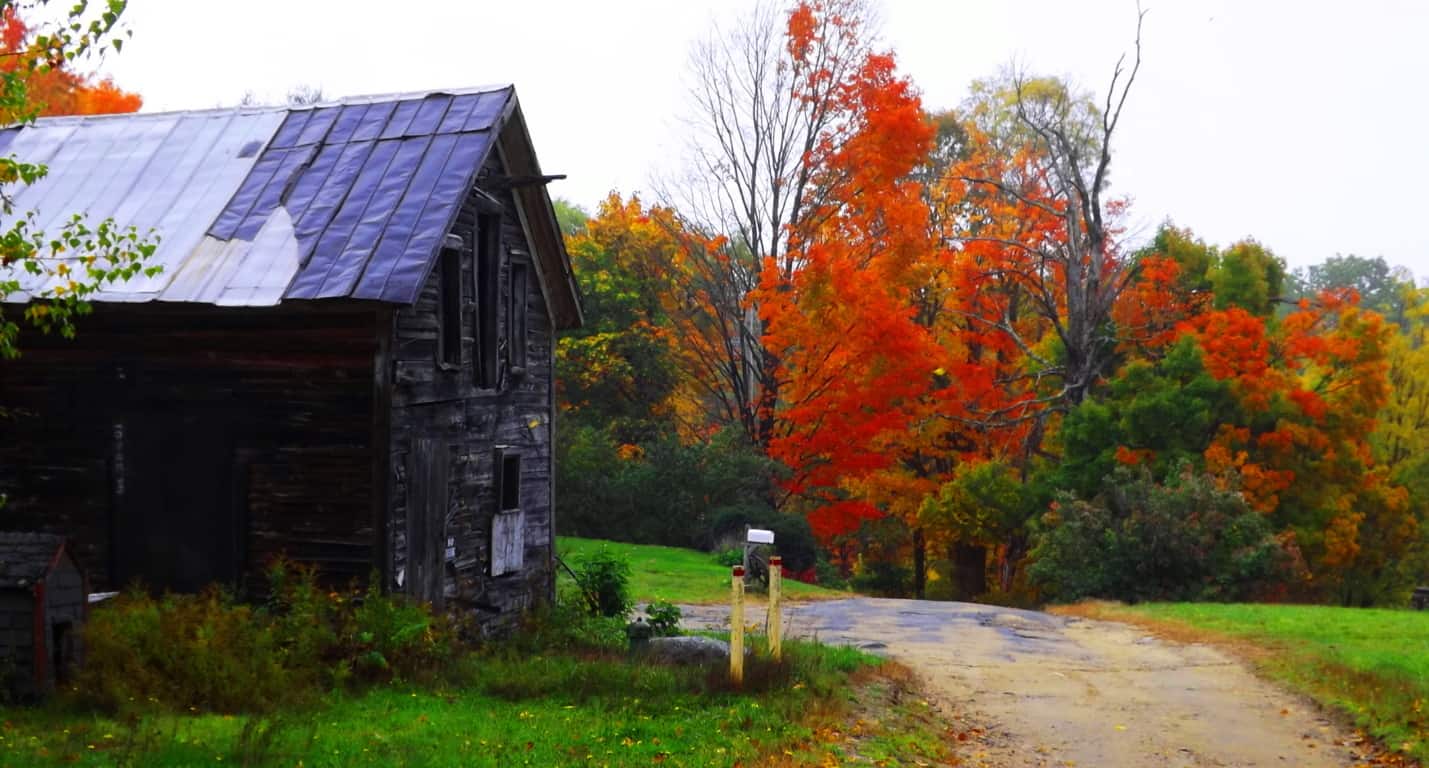 As soon as you begin striding into the entry path there is a feeling of watchfulness. This feeling is far from fictional; ‘watchfulness’ is the unforced moment when you realize that you are not necessarily observing the forest, but rather, the forest is actually observing you. It can take years for some people to pinpoint this moment, while others acknowledge it within a few short hikes. It is a lucky feeling to achieve if you can. The misty entrance at Lincoln Pond Trail is the embodiment of “the old-growth ‘gateway'”, where the possibility of this feeling emerges in each bending branch and whistling breeze. With a swift mist moving through the deep multicolored forest, you might begin to grasp that hiking is anything but primitive “walking”, it is a Godsend treatment for your sensory.
As soon as you begin striding into the entry path there is a feeling of watchfulness. This feeling is far from fictional; ‘watchfulness’ is the unforced moment when you realize that you are not necessarily observing the forest, but rather, the forest is actually observing you. It can take years for some people to pinpoint this moment, while others acknowledge it within a few short hikes. It is a lucky feeling to achieve if you can. The misty entrance at Lincoln Pond Trail is the embodiment of “the old-growth ‘gateway'”, where the possibility of this feeling emerges in each bending branch and whistling breeze. With a swift mist moving through the deep multicolored forest, you might begin to grasp that hiking is anything but primitive “walking”, it is a Godsend treatment for your sensory. 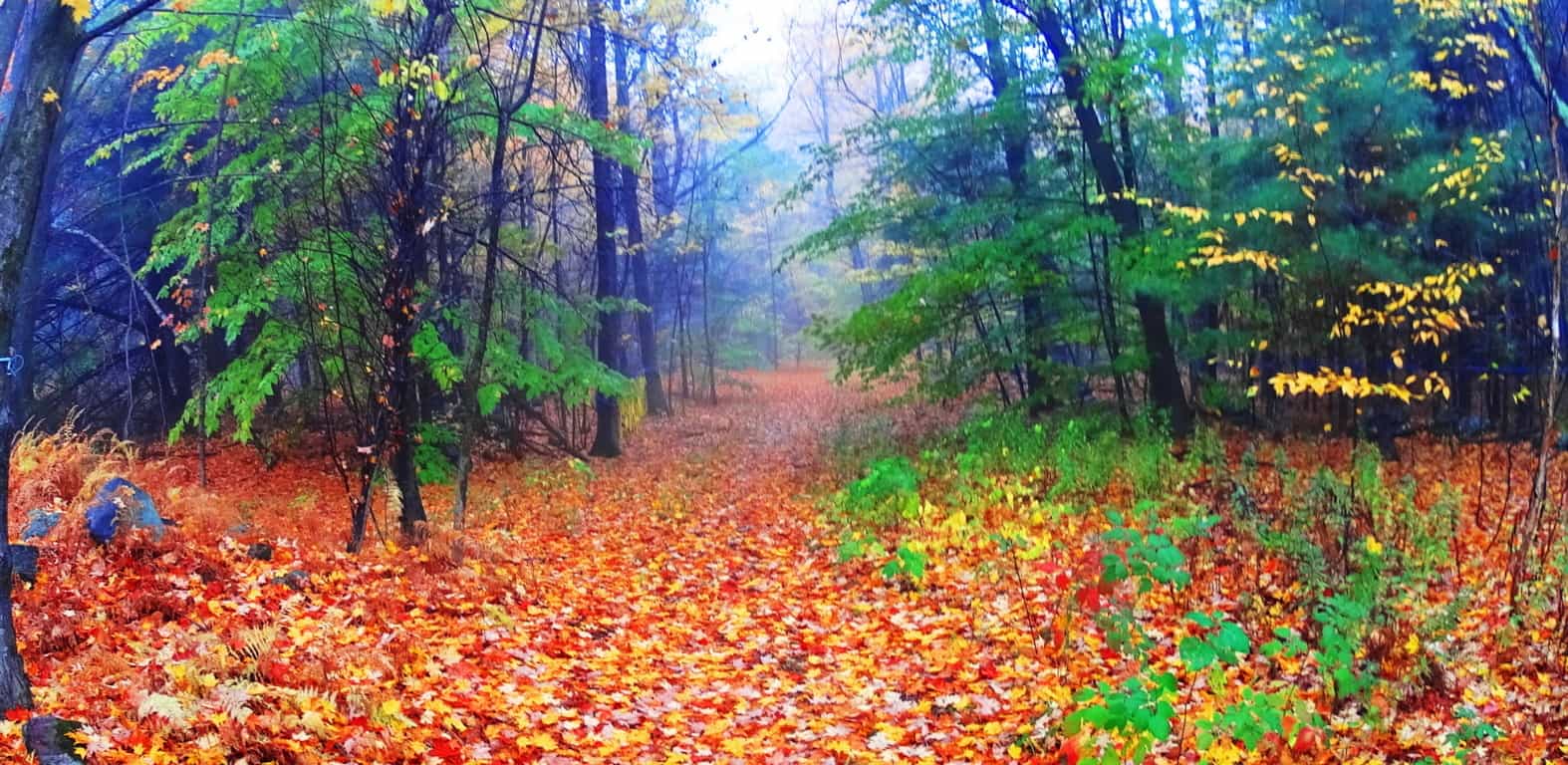
Entering Ashburnham’ in late Fall of 2016 I realized that this would be my last real hike of the year. I had now seen roughly 30 state park nature Reserves in the last 4 years, inclusive of 5 countries and 6 States, (among those various countries). Since walking into Kinnitty Forest for the first time, in the heart of Ireland 4 years ago, where my girlfriend stumbled on a seashell at the top of a mountain, my life has never been the same. I discovered that if you stroll into even the most unassuming looking woods (even in the middle if Ireland), if you look deep enough, or climb high enough, you may very well find something truly wonderful that could change your outlook on the world. 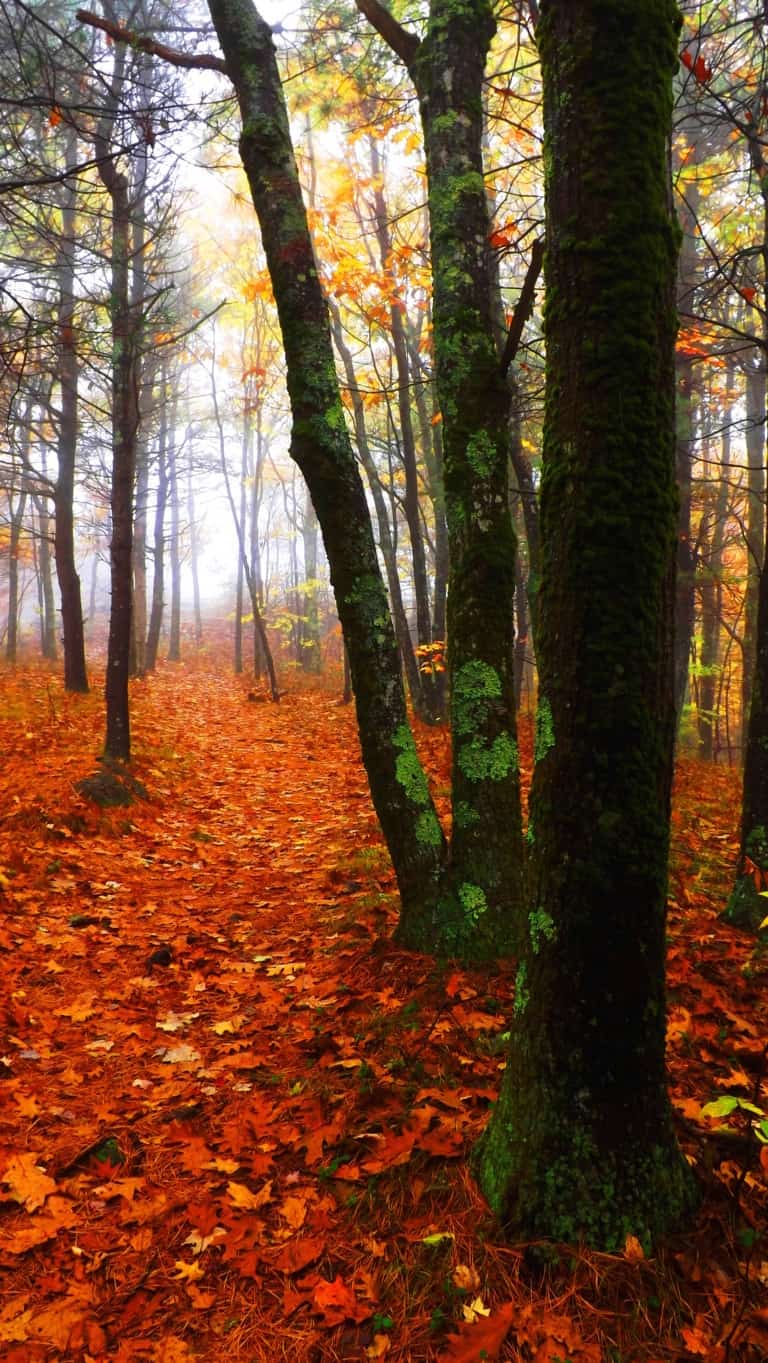 This was subject matter they didn’t teach us in schools, even at universities, which made it all the more stunning for me. Eventually, if thing s like this happen you have to ask why? Why does every region that has yet to be suburbanized, including most of the surviving forests and mountain elevations, contain megalithic stones, ‘linings’ and cairns that are practically hidden in the landscape? why is it not brought up in our text books? It has finally become clear to me. The first culture on Earth, the first layer of culture, is a Megalithic Culture; This was an ‘engineering capable’, technologically proficient, culture. The second layer is the Native period. The third layer is the Colonial period; then the fourth layer is the Industrial movement, and the fifth Postmodern. If this is correct, than in places like Ashburnham’, where there are no layers to cover up and interfere with this first layer of Megalithic Culture, the cultural stones will be discernible. The trails here should reveal stonework just beneath an ocean of golden leaves, like a visibly enlightened landscape that guards the greatest stylized historic secret on earth. It’s like hiding a sword in a stone, deep in the forest of some forgotten place, just waiting to be pulled up.
This was subject matter they didn’t teach us in schools, even at universities, which made it all the more stunning for me. Eventually, if thing s like this happen you have to ask why? Why does every region that has yet to be suburbanized, including most of the surviving forests and mountain elevations, contain megalithic stones, ‘linings’ and cairns that are practically hidden in the landscape? why is it not brought up in our text books? It has finally become clear to me. The first culture on Earth, the first layer of culture, is a Megalithic Culture; This was an ‘engineering capable’, technologically proficient, culture. The second layer is the Native period. The third layer is the Colonial period; then the fourth layer is the Industrial movement, and the fifth Postmodern. If this is correct, than in places like Ashburnham’, where there are no layers to cover up and interfere with this first layer of Megalithic Culture, the cultural stones will be discernible. The trails here should reveal stonework just beneath an ocean of golden leaves, like a visibly enlightened landscape that guards the greatest stylized historic secret on earth. It’s like hiding a sword in a stone, deep in the forest of some forgotten place, just waiting to be pulled up. 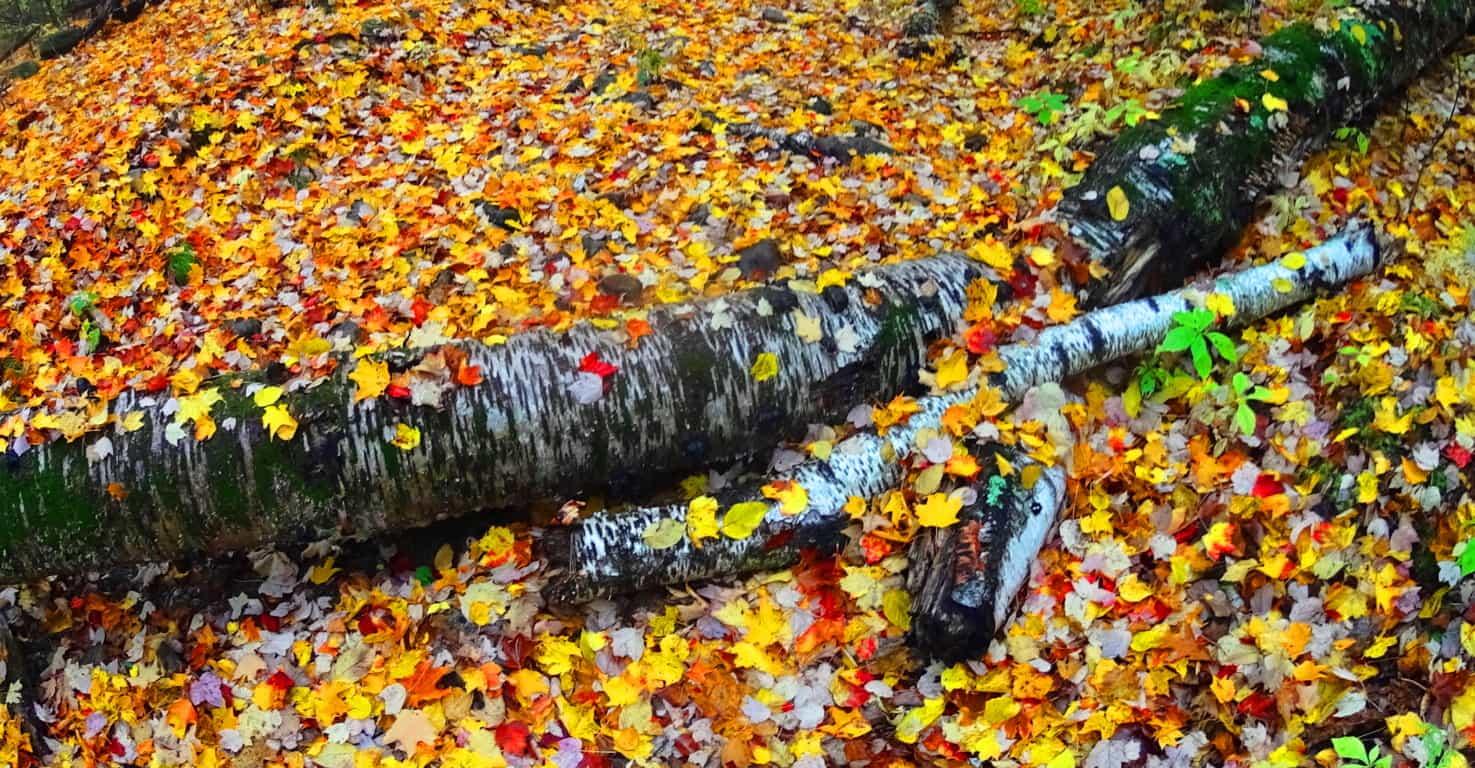
To begin, as you wander in, right away, on both sides of the trail, are beautiful stone-linings that follow the path. This is the sign of a truly ancient Reserve. Following these stones will most often lead you to something even more compelling, a rocky ledge or waterfall, which is a pattern that is also true in the fantastic Celtic Reserves to the east, across the Atlantic Ocean. 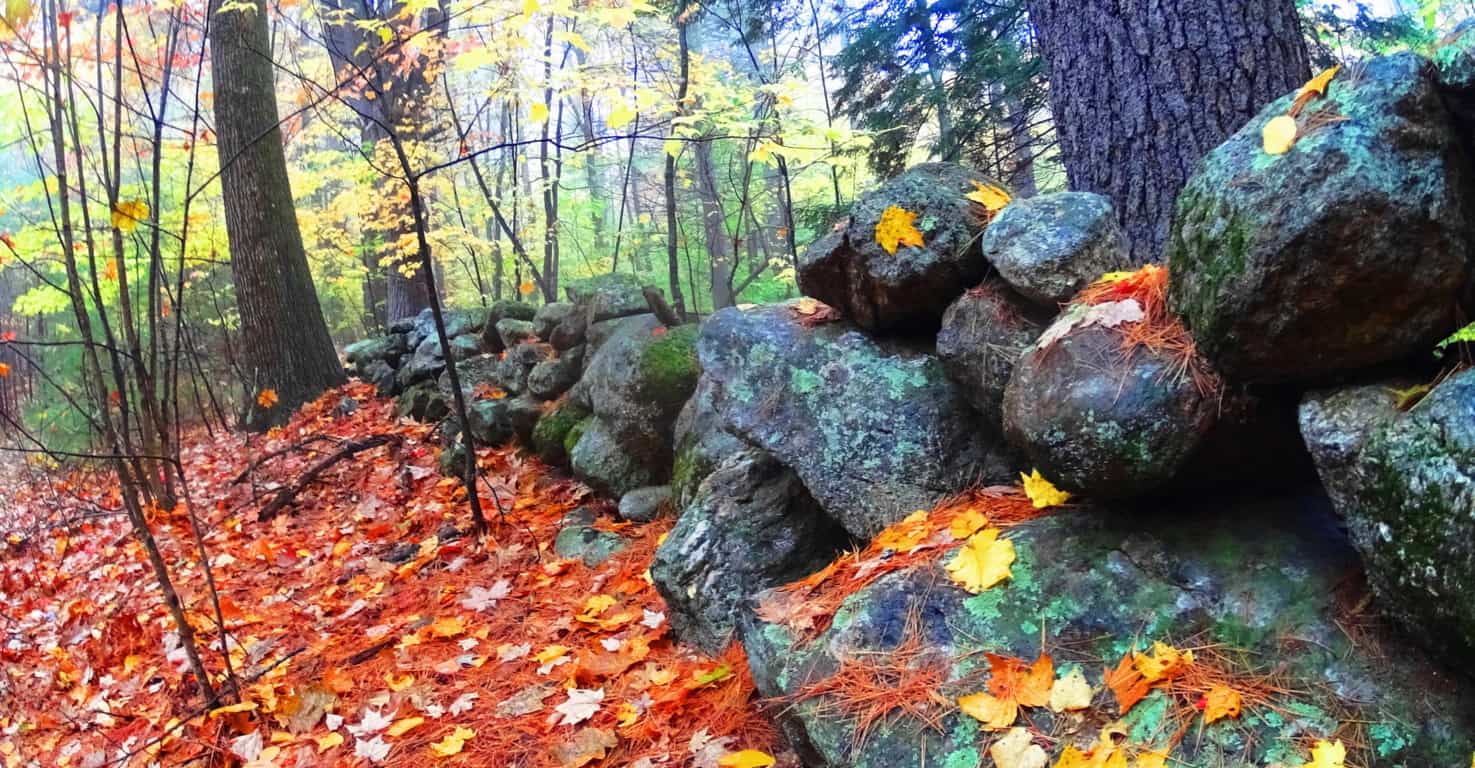 Along this main ‘artery of stone’ is a tour of fantastic expressions, along with what looks like a powerfully regenerative place, a wonderfully healthy old growth forest. Groves of baby Pines flourish here, which can be seen about a quarter mile into this trail, just off the path. It indicates an ecosphere of high quality nutrients in the earth and air. The positive benefits of these energies for people is not dramatic hokum; the effects on human beings are equally reviving, and certainly far more beneficial than say, walking on the pavements of even the “nicest cities”.
Along this main ‘artery of stone’ is a tour of fantastic expressions, along with what looks like a powerfully regenerative place, a wonderfully healthy old growth forest. Groves of baby Pines flourish here, which can be seen about a quarter mile into this trail, just off the path. It indicates an ecosphere of high quality nutrients in the earth and air. The positive benefits of these energies for people is not dramatic hokum; the effects on human beings are equally reviving, and certainly far more beneficial than say, walking on the pavements of even the “nicest cities”. 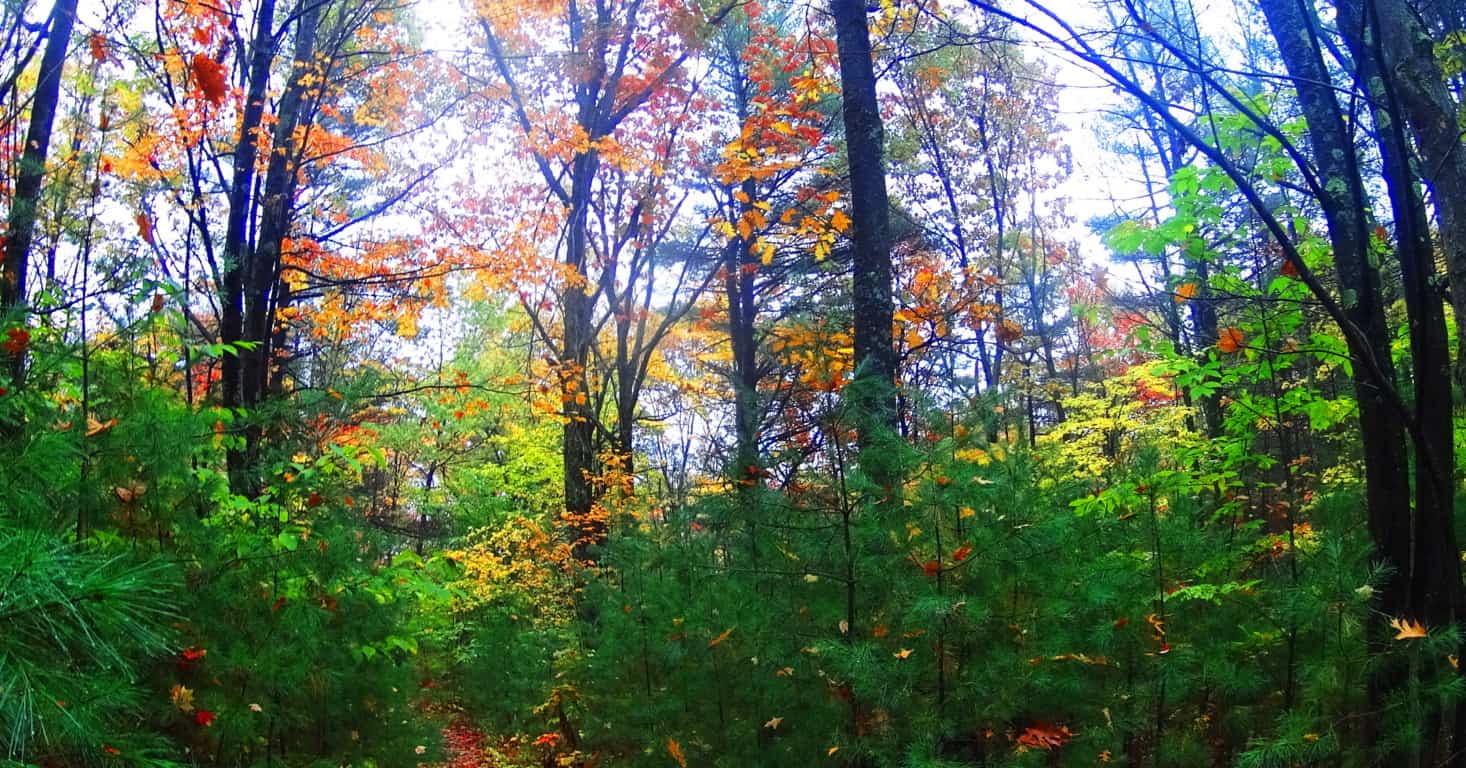
The classic stone-linings in Ashbunrham’ have another quality that makes the case for an increasingly in-depth explanation as to what their purpose(s) may have been. There are places in the ‘linings’ that are clearly and distinctly leading to specific boulders. Just like the head of a large serpent, many of the stones are capitalized with a free-standing boulder that seems to have been placed directly into this construct, intentionally. The idea that stone-linings, which run for dozens of miles through the landscape at Ashburnham’, were simply built along glacially placed boulders sitting at random just doesn’t make sense. The stone-linings create an order in the forest; they are a logical expression of control and directionality. Basing an entire network of megalithic stones on random ‘glacially placed’ boulders seems opposite to the entire point for a culture that actuated meaning int he deep woods by placing lines of massive stones. The boulders were most likely inserted into the stone-linings, just like other lessor stones, however hard that is to believe. And this still doesn’t answer the question, why? Below is an example of just such an expression. This classic stone-lining, which is partially covered by the foliage, runs straight into this massive boulder, like the head of a snake. Even the picture doesn’t do the scene the justice it compels in person.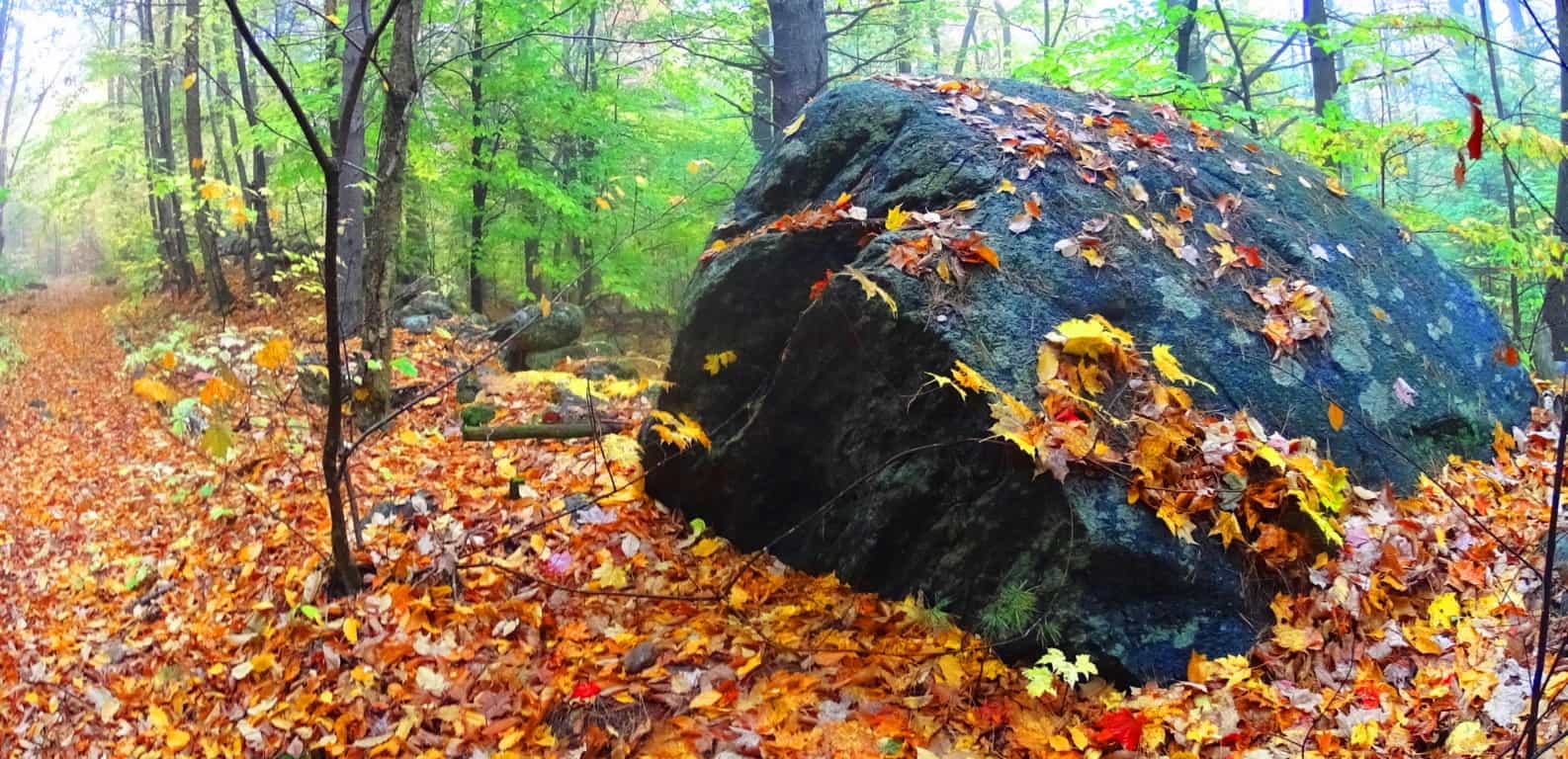
Lincoln Pond Trail is a comfortably gradual incline that twists through glades of differing densities and hues. It is entirely pleasant strolling through. Eventually the golden leaves are left behind for Maple glades, with red burning red leaves rolling at your feet by the thousands. Hiking here is like twisting through a tunnel of colors and variations. The effect of color and variation on the brain is a positively stimulating and beneficial one, refreshing the senses with a refined palate for natural beauty. 
Drifting into this rouge dimension there are other amazing changes to see. A literal matrix of stone pathways begins to emerge; these are stones of a style I had never seen before just beneath the foliage. About 40 yards deeper into the woods, parallel to the trail, is a three-foot wide, by three-foot in height, lane of inserted stones that rolls like a wave through the old-growth woods. This is thousands of stones in an obvious statement which is boldly protruding above the ground, like a tunneled highway for Beavers. It continues for perhaps 400 yards beyond this spot. The meaning of this second style of stone through this gorgeous stretch of Maple groves is an additional mystery, but it is simply an addition to an entire set of mysteries that emerge here. Continuing along the northern line of these stones, the ground slowly elevates the path into a more unique part of the forest at Ashburnham’. This mysterious network blossoms into more obvious statements. It is hard to tell if certain areas are ancient living spaces, or focal points for some kind of work place; or perhaps this is an engineering statement with a functionality yet to be deciphered? The one thing that blatantly stands out here is that there is an entire culture of stonework beneath the leaves.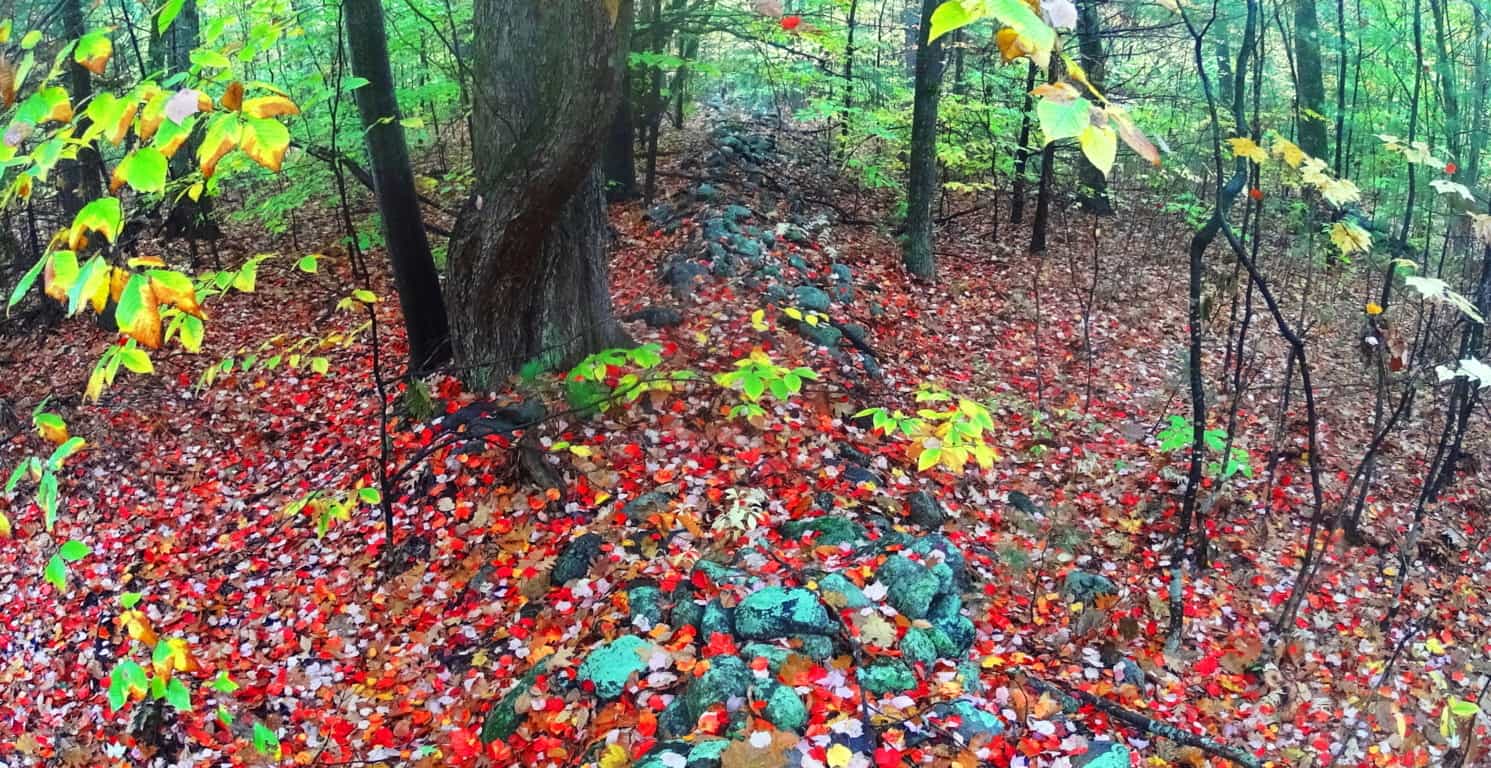 If this were a Celtic area the stones and their layout would be much more visible, as the greenery of indigenous Celtic ranges, and forests, are most often layered with minimal skins of glowing moss, but not much more. Look at the right angles of this stonework below. It is clearly defining the space with stones, but the purpose is hard to decipher. These statements run for miles through the woods. Once upon a time these stones dominated the entire landscape uninterrupted. It is conceivable that the stones were here before the forest even existed.
If this were a Celtic area the stones and their layout would be much more visible, as the greenery of indigenous Celtic ranges, and forests, are most often layered with minimal skins of glowing moss, but not much more. Look at the right angles of this stonework below. It is clearly defining the space with stones, but the purpose is hard to decipher. These statements run for miles through the woods. Once upon a time these stones dominated the entire landscape uninterrupted. It is conceivable that the stones were here before the forest even existed.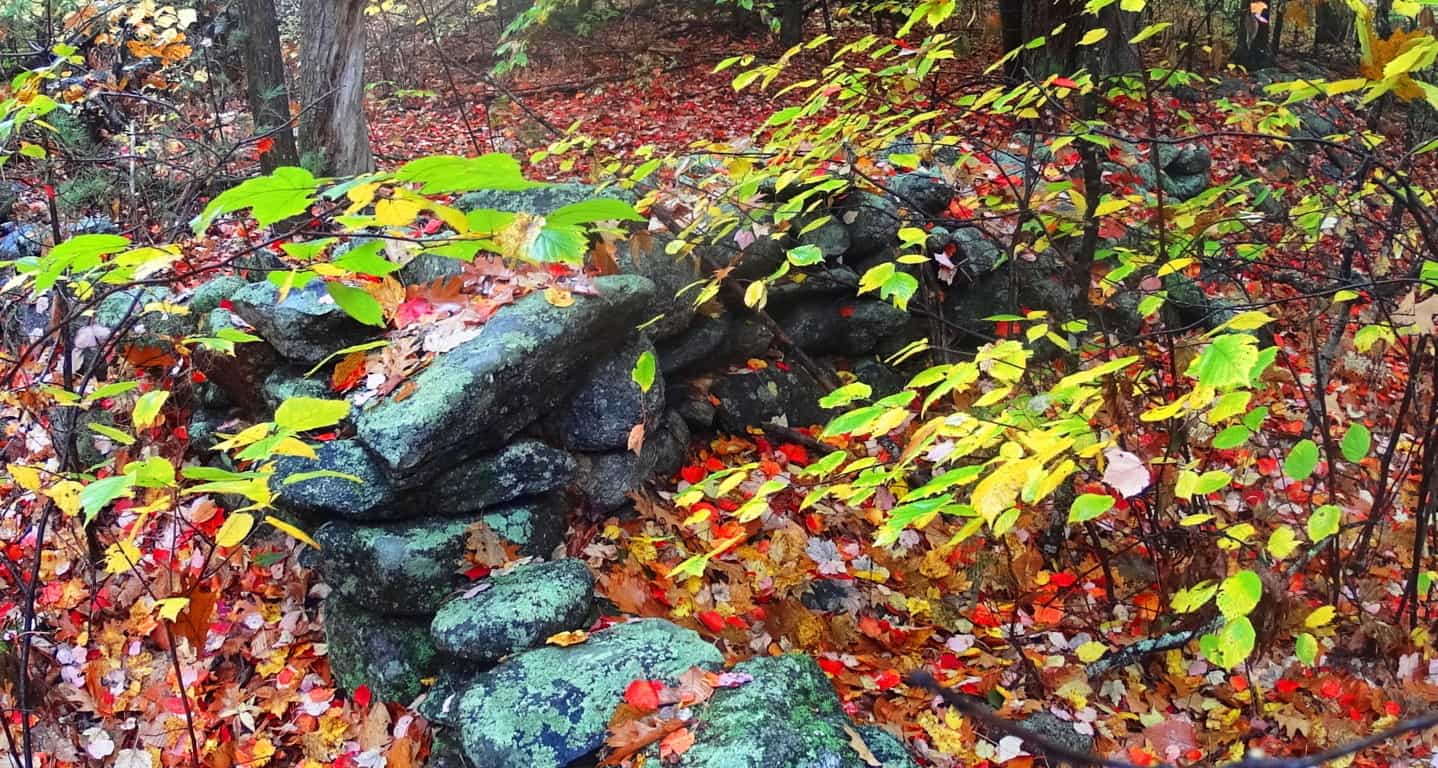
About 150 yards from this spot, off trail, is an entrenched set of stones with the look of a habitable dwelling. These dwellings can be found in crafted spaces much more distinct than here at Ashburnham’, yet to find this indicates that this place was definitely endeared and highly valued as “livable”. The stones below show a corner-section of what was once someones home, most likely in the beginning of history.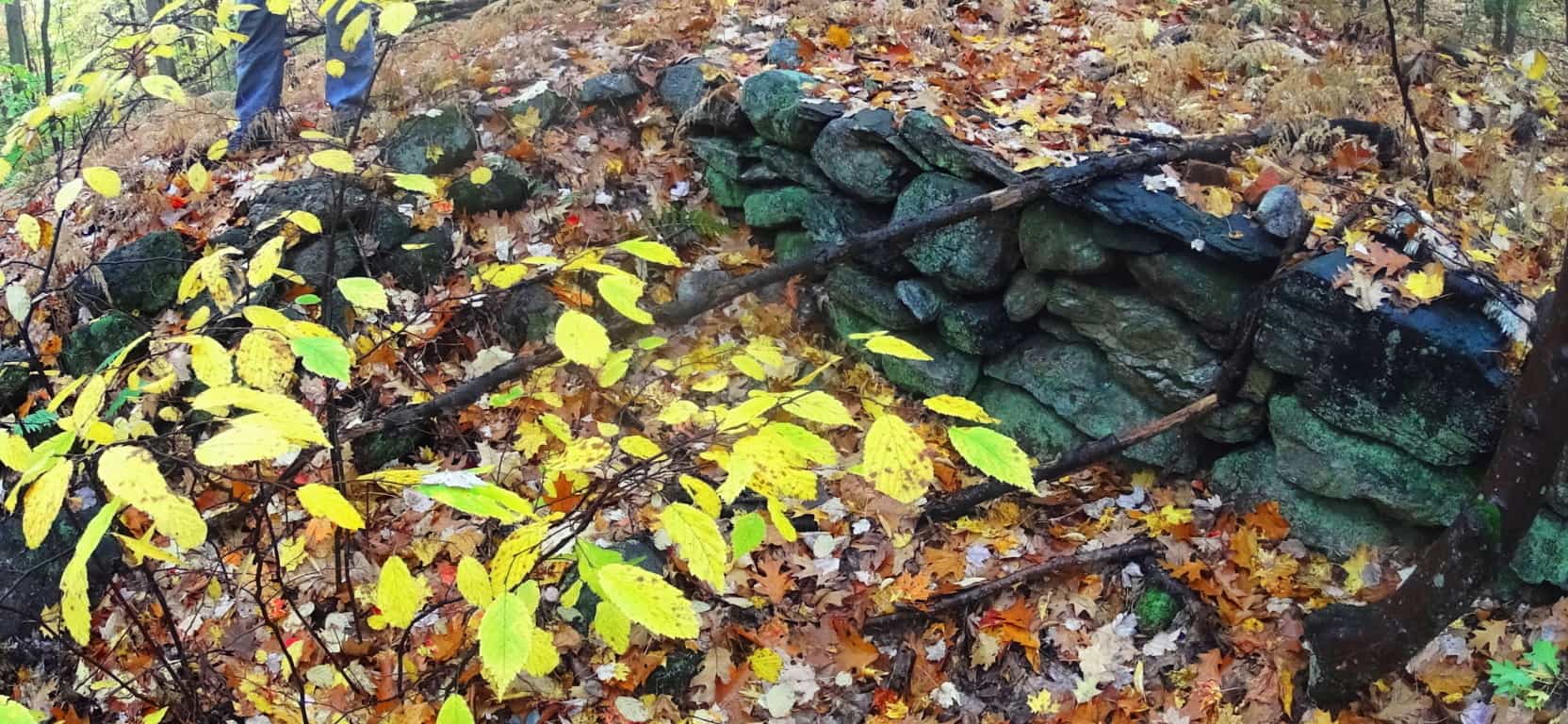
To add to the mystique of this spot, just 10 yards way is an extension of these stones that is symmetrically aligned, with a distinct quartz boulder centering the scene of entirely granite stones. The area is obviously in ruins, but there is an alignment to the overall remaining arrangement. It should be noted at this point, that none of this has anything to do with Colonial farmers.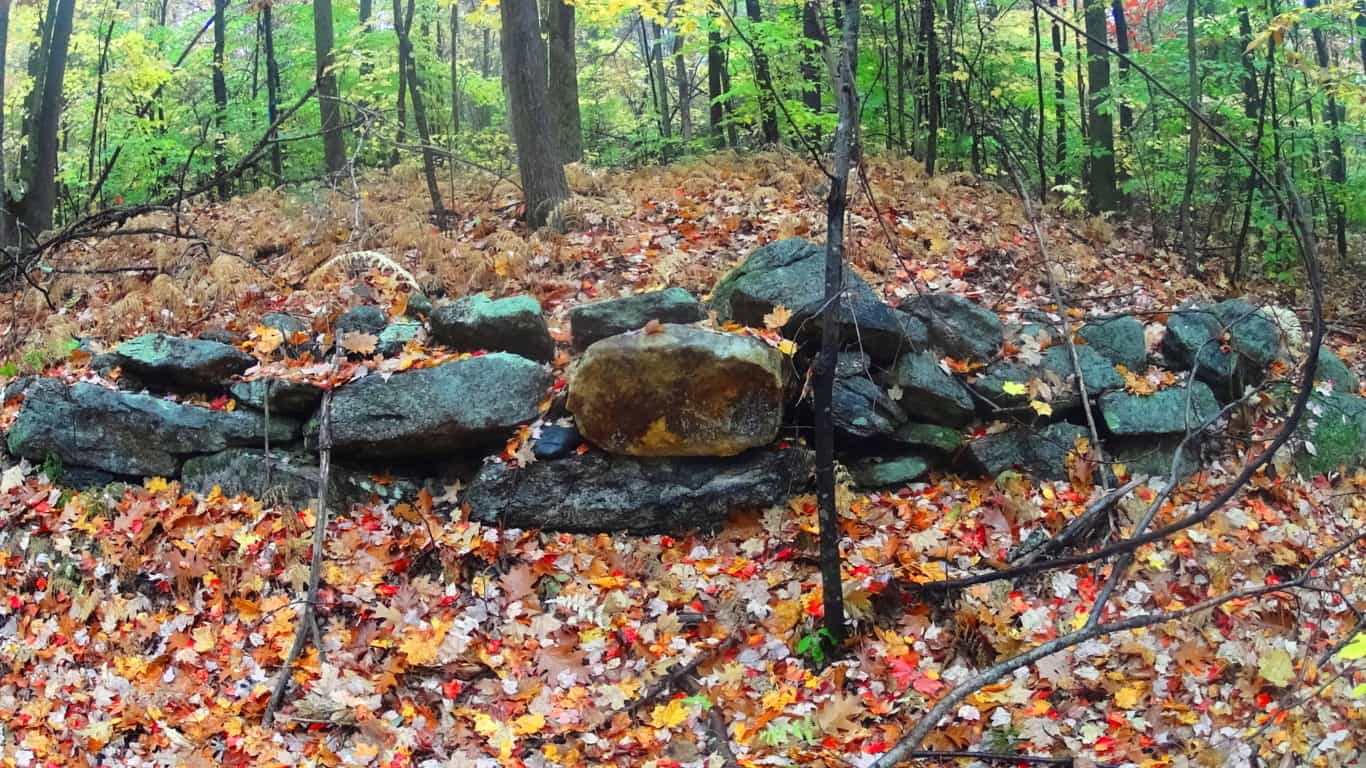 A cartographical recording of this area, a full archaeological review, will reveal a massive stone-network that is the basis of an entirely engineered landscape, harnessing sunlight in certain spaces, creating enclosures for harvested plants, connecting fixtures for navigational purposes, and relegating certain areas for irrigation. This is the case for almost every forest in western Massachusetts. Simply put, there’s a Megalithic Culture under there.
A cartographical recording of this area, a full archaeological review, will reveal a massive stone-network that is the basis of an entirely engineered landscape, harnessing sunlight in certain spaces, creating enclosures for harvested plants, connecting fixtures for navigational purposes, and relegating certain areas for irrigation. This is the case for almost every forest in western Massachusetts. Simply put, there’s a Megalithic Culture under there.
Ashburnham’ is a forest without a mountain in its midst. This makes for a more pleasant stroll over the course of about 3 miles of pathways. It does have slightly a elevated clearing, one 60 foot high ledge that sits like a rocky bald head just above the small valley to the north before reaching Watatic Mountain. as you climb up the forest peals aways and a beautifully rounded rocky ledge emerges, with what looks like molded slabs that feel hollow beneath your feet. The mist culminates here, as if you were walking into a cloud. Seasoned hikers eventually learn that scenes like this are priceless, and relate a side to New England trails that is real and authentic, akin to the dreamy visions that must have prompted stories like ‘The Headless Horseman” which famously took place in the New England forests of Upstate New York, where the woods were an entirely enchanted zone not to be taken lightly for Colonial settlers. This mound feels like another planet as you make for the top.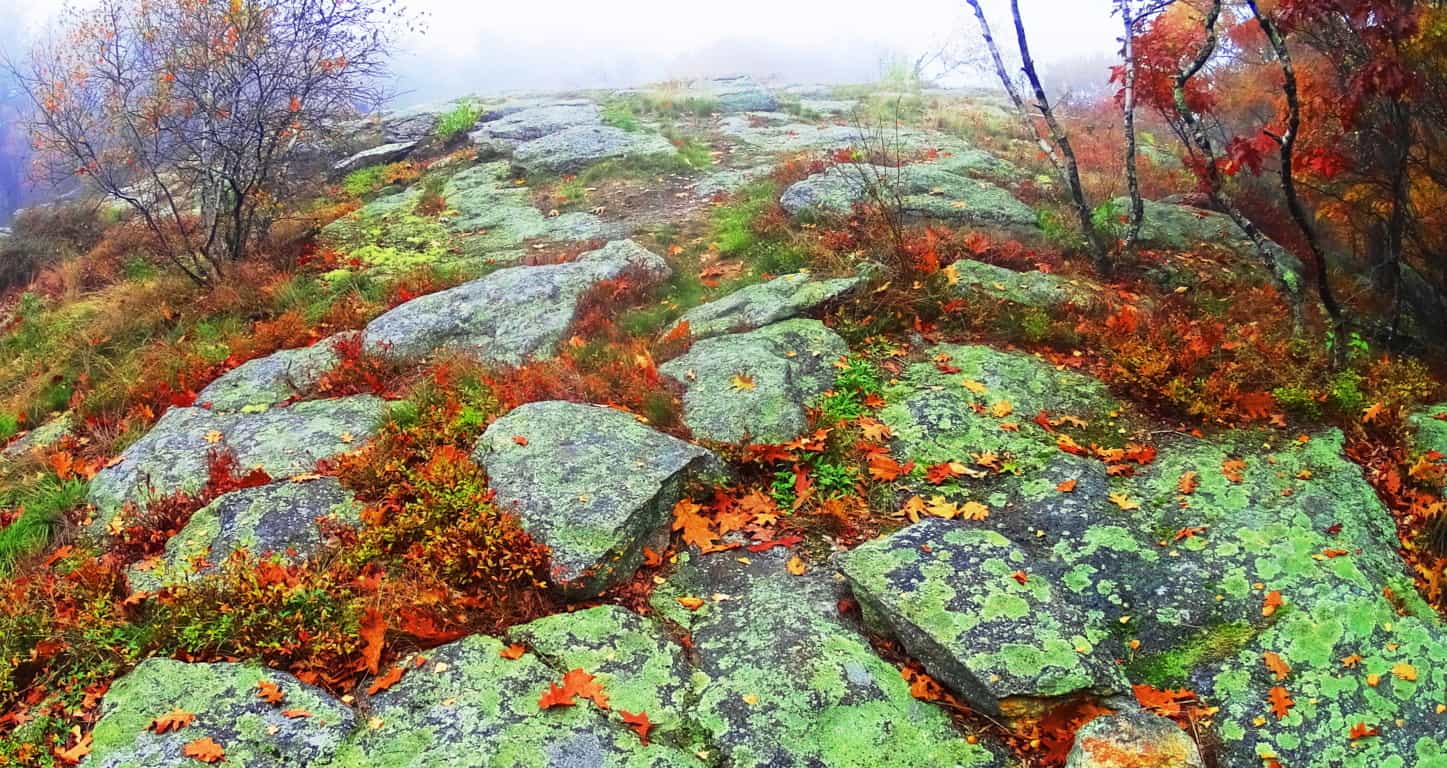
The giant slabs here seemed ‘custom fashioned’ to the hill; they are arched and fit perfectly to the rounded sides of the broad knoll while becoming more flat towards the flattened top. This fits an awesome pattern of higher elevations where ledges are carved-out and specifically rocky, while being surrounded by soil-rich old-growth forest. In short, it’s like a rocky island on an ocean of soil. I will not go so far as to say that these stones were crafted, but the surreality to the scene, the suddenness of these uniquely fitting stones along the rounded path, seems to have some kind of secret to it. To add to the mysterious situation, at the top of the rocky knoll, which is about two miles into the forest, a massive stone-lining of a style and consistency I had yet to see anywhere, even in Ireland, Wales, or Scotland, emerged rolling directly over the mound.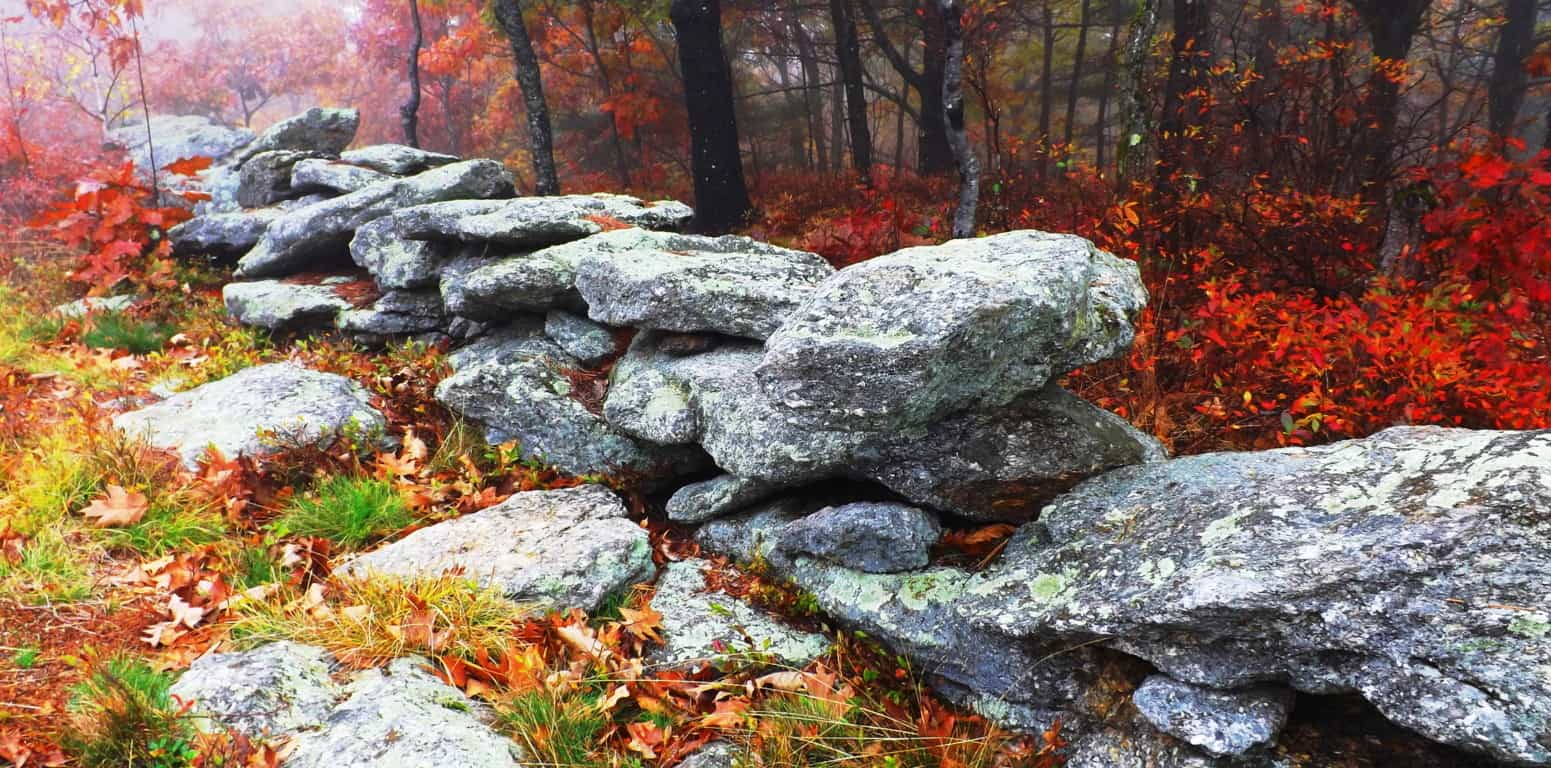 Each stone was proportionally equal, and at least five times bigger than the average stone used in the two types of other stone-linings already tracing the woods below. Each stone looked to be at least 300 to 400 pounds, and not a single alternate stone could be seen in its procession. Whoever engineered this lining had a puritanical streak, a stubborn need for crafted consistency, which is artistic step up from the craftwork of the designers below, literally and figuratively. In the elevated milky mist, with the burning red Maple leaves looming just at the edge of the hill, it looked otherworldly, like a train track running from hell to heaven.
Each stone was proportionally equal, and at least five times bigger than the average stone used in the two types of other stone-linings already tracing the woods below. Each stone looked to be at least 300 to 400 pounds, and not a single alternate stone could be seen in its procession. Whoever engineered this lining had a puritanical streak, a stubborn need for crafted consistency, which is artistic step up from the craftwork of the designers below, literally and figuratively. In the elevated milky mist, with the burning red Maple leaves looming just at the edge of the hill, it looked otherworldly, like a train track running from hell to heaven.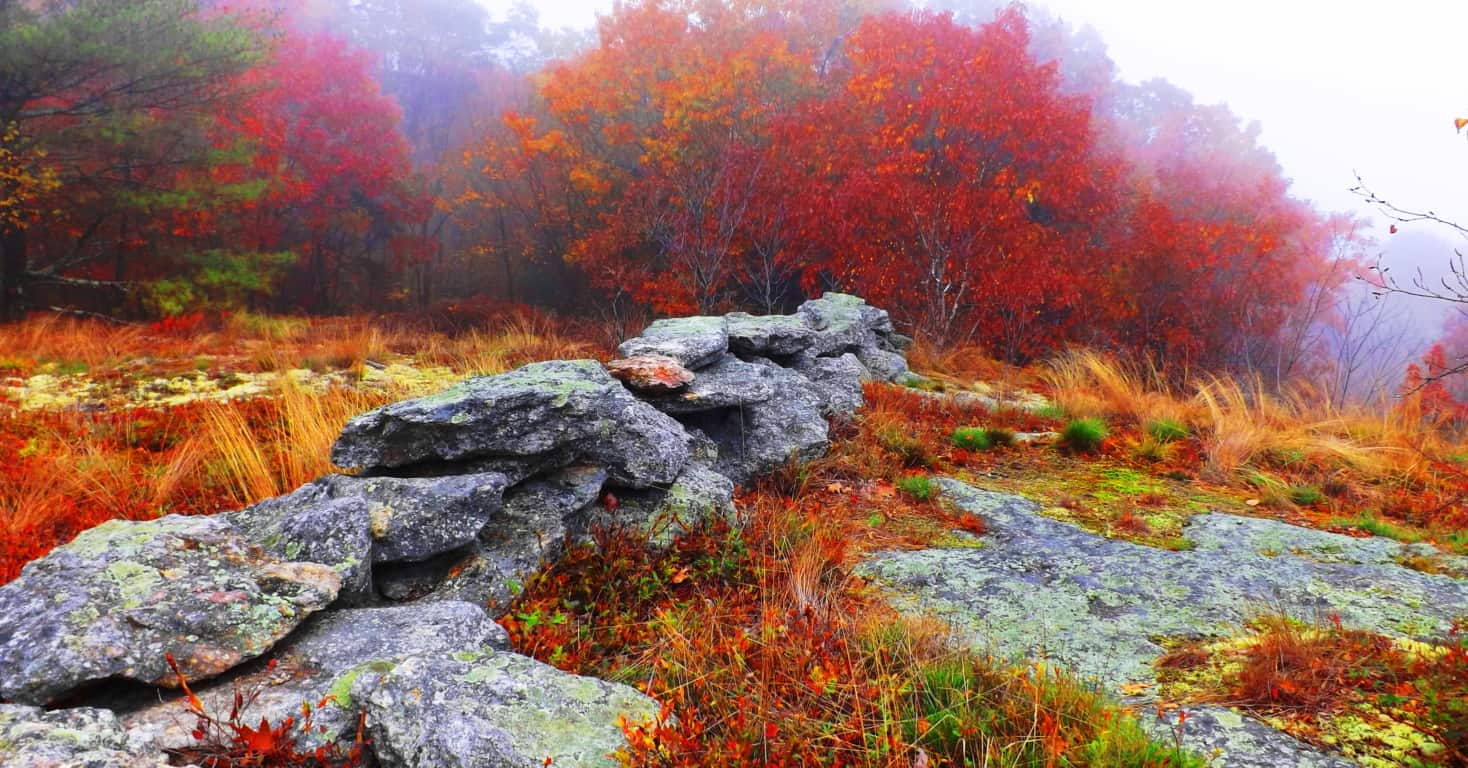 This is an undeniable trend in so many old-growth areas; impressive stone statements placed specifically at the higher elevations of forests. This is exactly what Natives called the “place of power” in their stories. One thing that is obvious about this scene is that on sunnier days the area will obviously absorb unobstructed light for a maximum amount of time, along the with the stone-linings running over them. This set up may very well serve to channel that collected energy from the Sun out into the forest beyond, into the other stone-linings, and the valley below. I have seen a set up just like this at Cavan Burren National Park in Northern Ireland, where the landscape is interconnected by Megaliths, and of course blatantly misunderstood by local “scientists”.
This is an undeniable trend in so many old-growth areas; impressive stone statements placed specifically at the higher elevations of forests. This is exactly what Natives called the “place of power” in their stories. One thing that is obvious about this scene is that on sunnier days the area will obviously absorb unobstructed light for a maximum amount of time, along the with the stone-linings running over them. This set up may very well serve to channel that collected energy from the Sun out into the forest beyond, into the other stone-linings, and the valley below. I have seen a set up just like this at Cavan Burren National Park in Northern Ireland, where the landscape is interconnected by Megaliths, and of course blatantly misunderstood by local “scientists”.
Coming down from this knoll Lincoln Pond Trail continues northwest, where fields and clearing are lined again with stones at the edge various and beautiful glades. These are perfect spots to sit down and appreciate everything you might have seen. The trail extends for several more miles before an optional loop back to the southern entrance, or an exit to the north.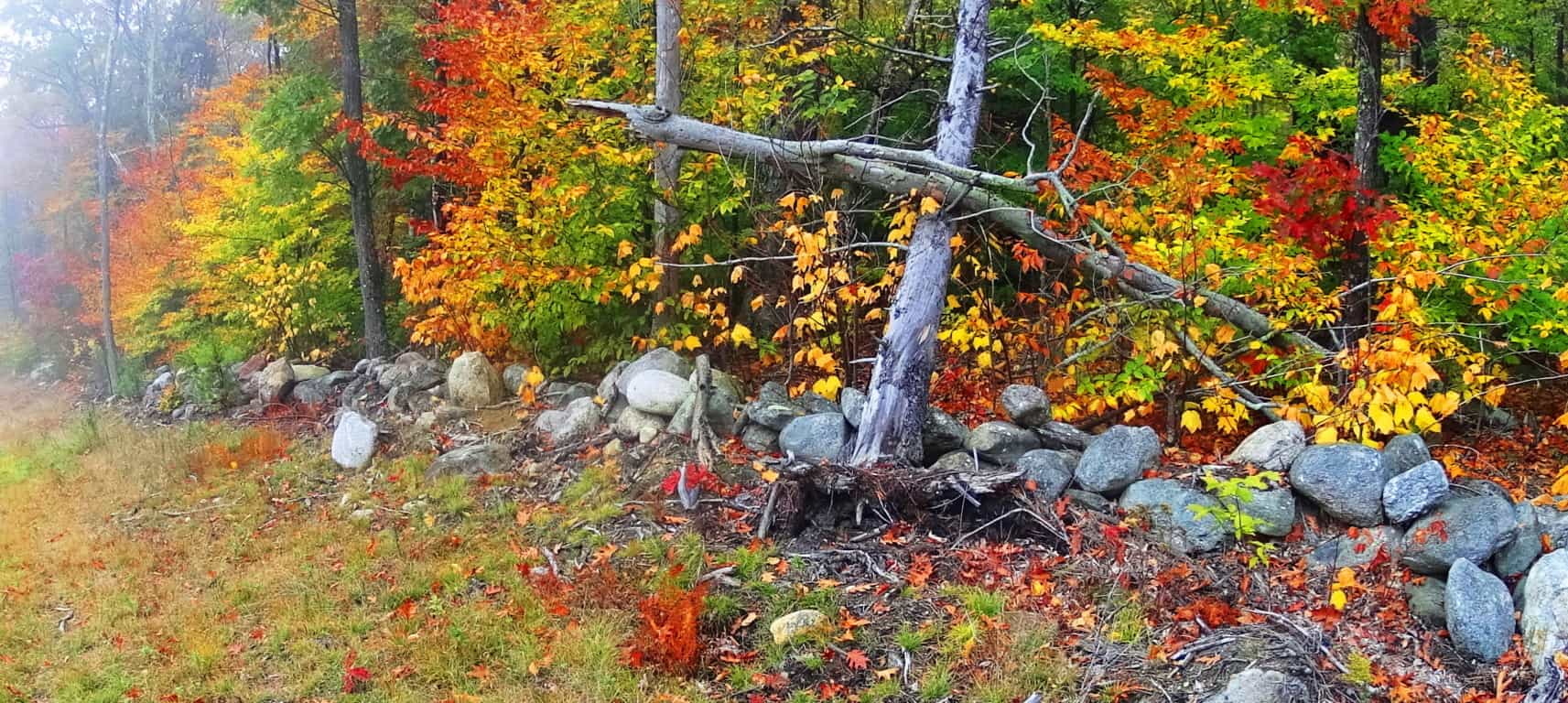 It is important to note that in several other locations in the woods, while exploring this area, there were amazing and mysterious things to see. I came upon a huge lining of stones with a symmetrical tint not far from the southern boarder. It was impressive, with the larger stones towards the top, which is another strange trend to be found in old-growth stoneworks in New England. Any mason putting the larger stones towards the top is making a bold statement, as if to say, “I can do whatever I want, despite the difficulty of crafting the structure this way.” This lining below is not far from the entrance of the trail, roughly 40 yard off to the right of the path. There may very well be something buried beneath this incredible mound. There was a great deal of effort and time put into stacking and leveling these 100 to 500 pound stones, the higher the heavier, which indicates the unique and unlimited mindset of whoever built it.
It is important to note that in several other locations in the woods, while exploring this area, there were amazing and mysterious things to see. I came upon a huge lining of stones with a symmetrical tint not far from the southern boarder. It was impressive, with the larger stones towards the top, which is another strange trend to be found in old-growth stoneworks in New England. Any mason putting the larger stones towards the top is making a bold statement, as if to say, “I can do whatever I want, despite the difficulty of crafting the structure this way.” This lining below is not far from the entrance of the trail, roughly 40 yard off to the right of the path. There may very well be something buried beneath this incredible mound. There was a great deal of effort and time put into stacking and leveling these 100 to 500 pound stones, the higher the heavier, which indicates the unique and unlimited mindset of whoever built it.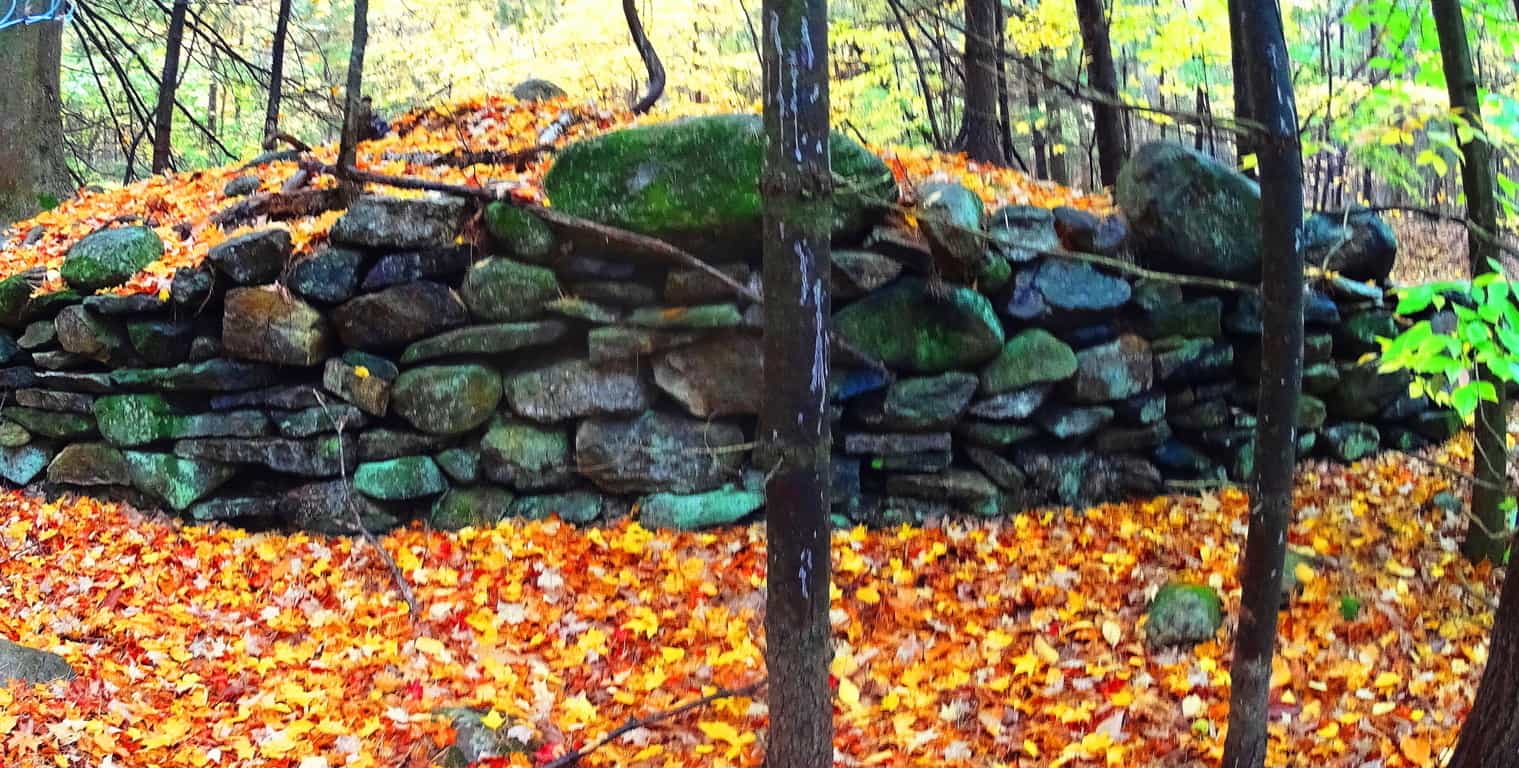
And finally, not far from this ‘lining’, is what I believe to be the remnants of a New England Dolmen, now in a dilapidated state. This rounded boulder was clearly supported and elevated by other stones beneath. It is now only partially supported, which has happened to several Celtic alters abroad. 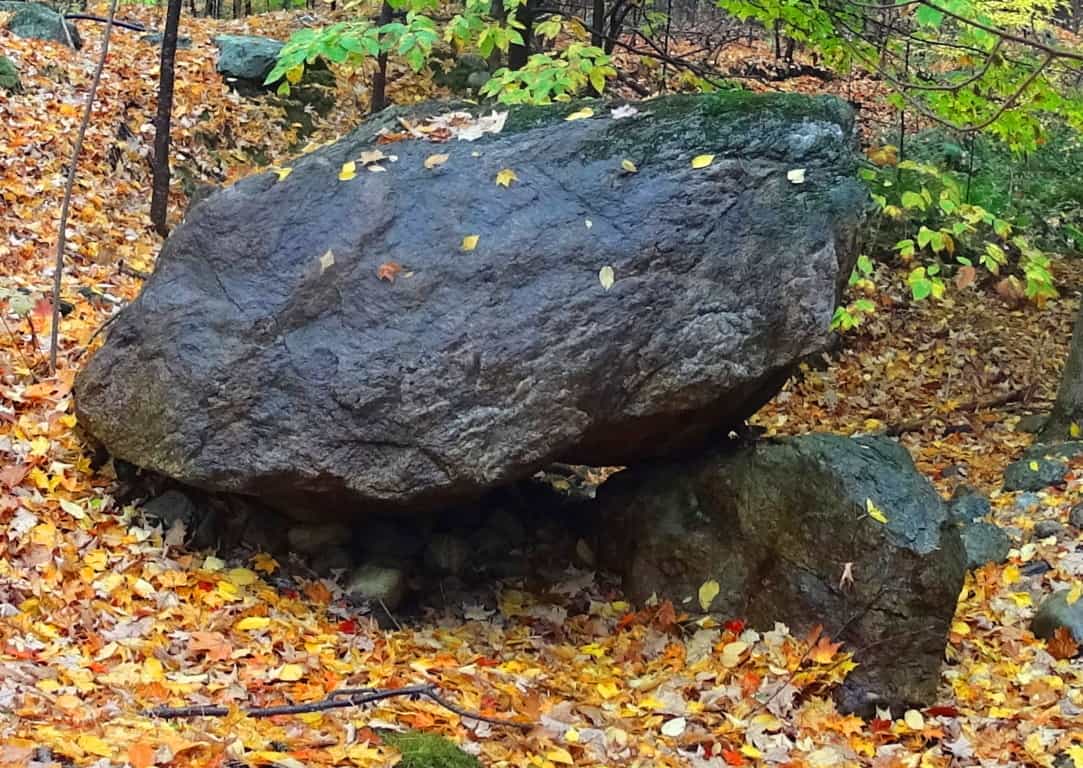 Whatever the truth is about this area, it is obviously an enchanted cultural center that the forest has grown over, and in a beautiful way. It’s time for anthropologists to get their heads around the idea that the stones were probably here first, and the forest, like a grafted grid, grew up around the Megaliths.
Whatever the truth is about this area, it is obviously an enchanted cultural center that the forest has grown over, and in a beautiful way. It’s time for anthropologists to get their heads around the idea that the stones were probably here first, and the forest, like a grafted grid, grew up around the Megaliths.
Ashburnham State Forest is the epitome of the enchanted New England hike. These woods are in a wonderful state of ‘spooky respiration’, augmented by a universe of color and decor along the trail. This place supports every magical fairytale that has ever been told, but more importantly, it supports a very real Megalithic cultural scene that increasingly emerges with each and every hike taken through these woods. Celtic places have a very similar feel, an it just becomes impossible to ignore the Megalithic foundation of these old-growth regions in New England. If you want to see something sacred, simply find your way to Ashbunrham State Forest; it won’t take long, but be sure to take your time.
Rattlesnake Mountain
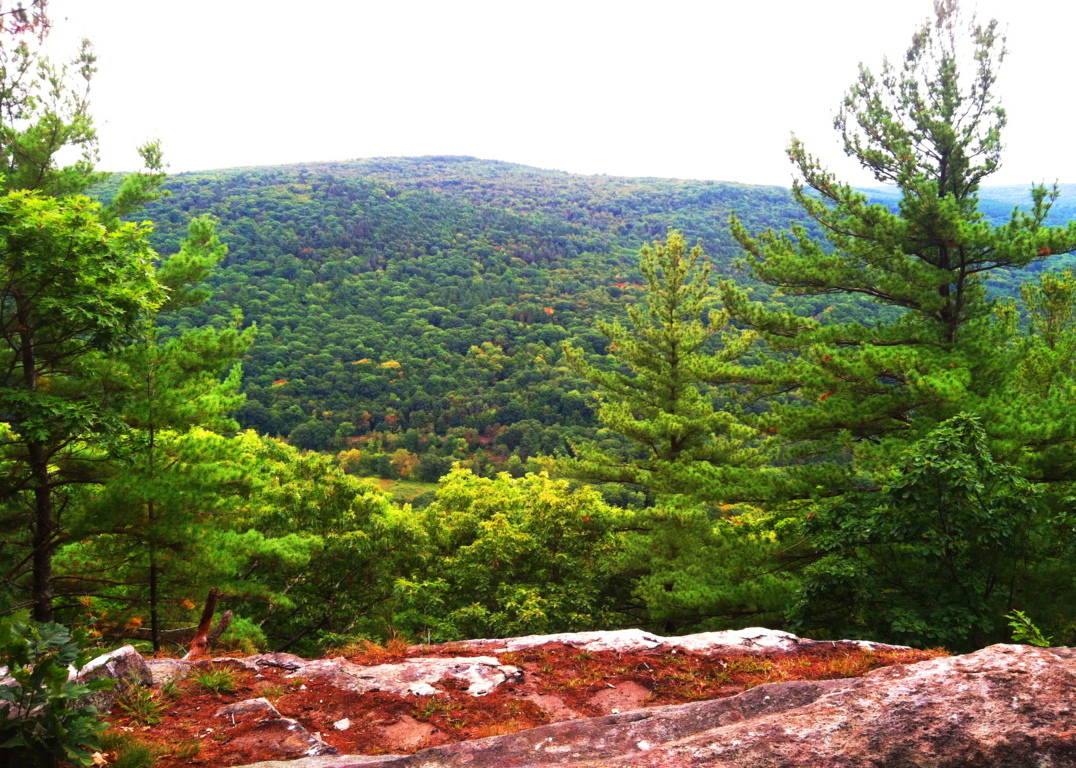
Location: Erving, Massachusetts
Elevation: 1,067 ft
Note: Running along the northern border of Massachusetts is a unique set of rolling “small-mountain” ranges. These elevations are too tall to be called mere hills, but too small to be known as full-fledged mountains. Rattlesnake Mountain sits in the heart of this range in the northwestern portion of the state, surrounded by similar small-mountain peaks in Monroe and Savoy to the west, with Watatic to the east. The woodsy entrance for the car park leading to the main trail at Rattlesnake Mountain is nearly hidden, just off Rt 2A, about 100 yards from Maple Ave, in the picturesque country-town of Erving.
The trail at Rattlesnake’ is essentially a 2.4 mile loop that broadly encircles a massive metamorphic rock ledge. Known as The Farley Ledges, this precipice is enveloped by trees, standing about 220 feet high, and about a mile-and-a-half wide, east to west (image below)…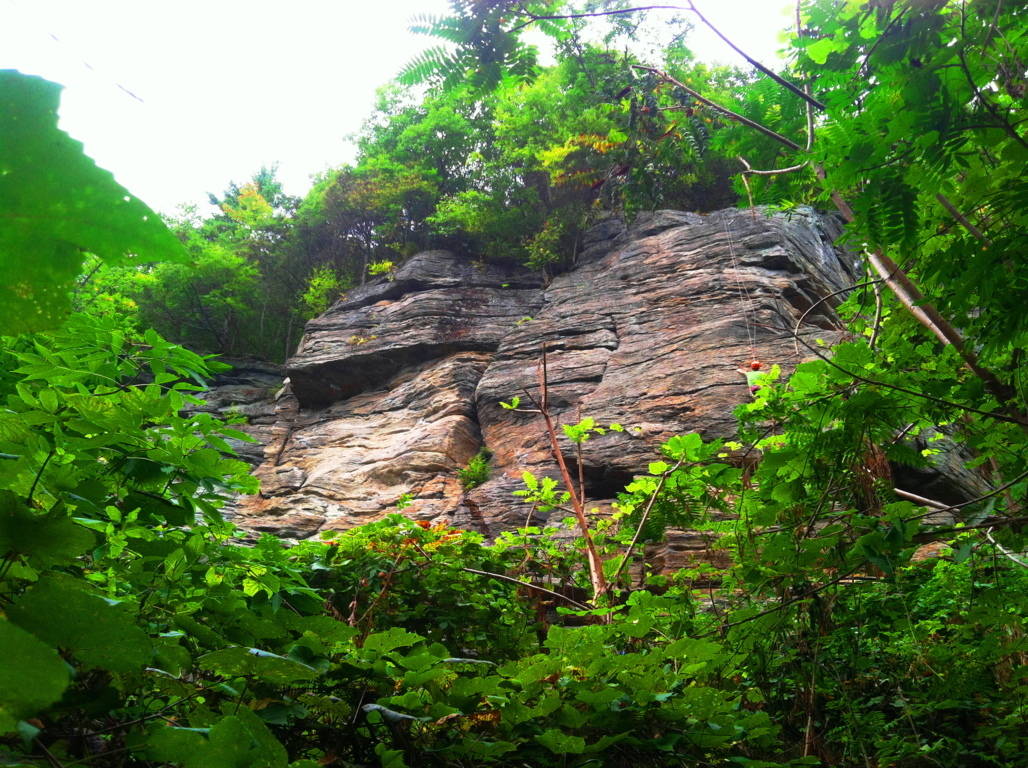 Rock climbers scale this ledge in a world all their own, paying very little attention to the boulders and stones that line the ground below. If they did pay attention, a closer look at these stones reveal something pretty amazing. Here at Rattlesnake’ there is a megalithic mystery that reaches deep into the heart of Massachusetts forests and mountains, a mystery that most often goes unspoken. Simply put, there are hundreds of gigantic cut stones which are measured and marked inundating the forest floor just beneath the ridge. There are pathways that run directly into this “stone playground” where various crafted stones sit (image below)…
Rock climbers scale this ledge in a world all their own, paying very little attention to the boulders and stones that line the ground below. If they did pay attention, a closer look at these stones reveal something pretty amazing. Here at Rattlesnake’ there is a megalithic mystery that reaches deep into the heart of Massachusetts forests and mountains, a mystery that most often goes unspoken. Simply put, there are hundreds of gigantic cut stones which are measured and marked inundating the forest floor just beneath the ridge. There are pathways that run directly into this “stone playground” where various crafted stones sit (image below)…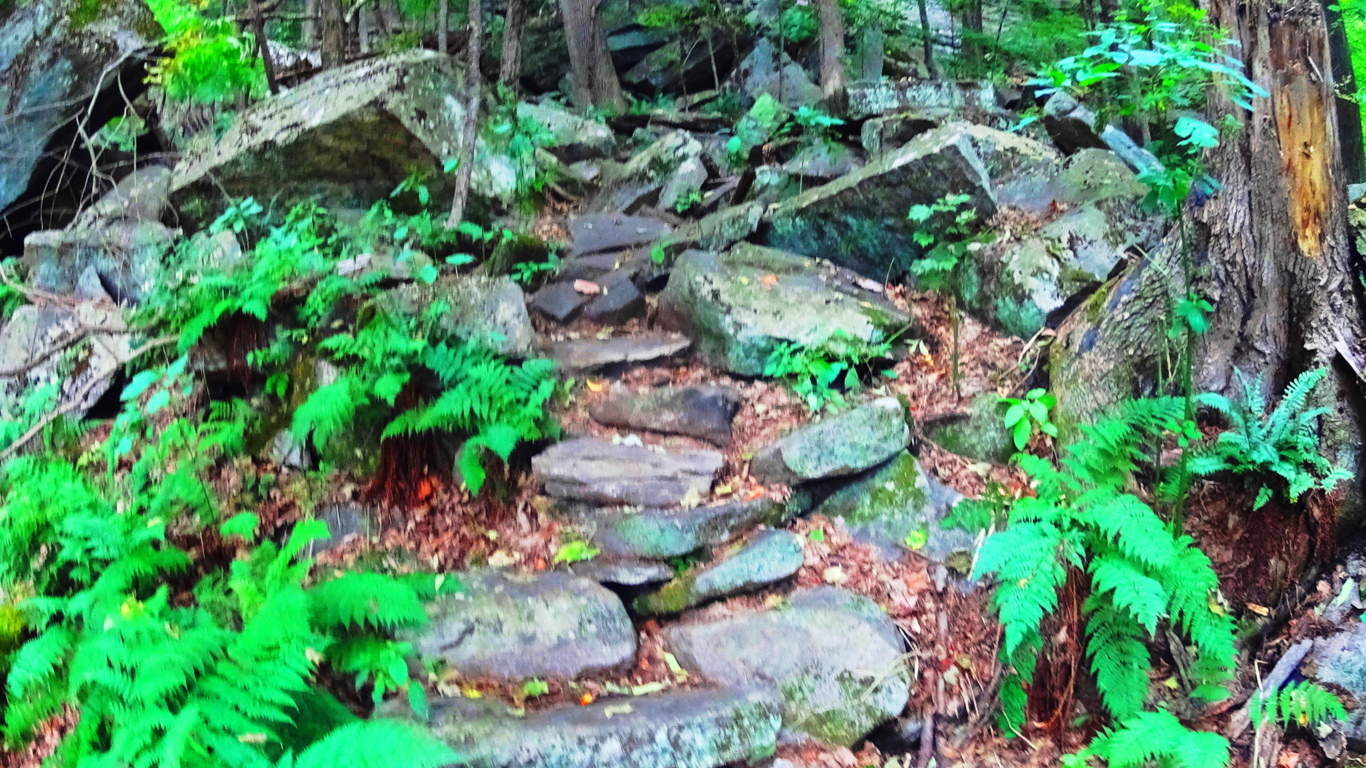 Other megaliths are fixed in some pretty curious positions in arrangements near the trail, winding like a display along the ledge (image below)…
Other megaliths are fixed in some pretty curious positions in arrangements near the trail, winding like a display along the ledge (image below)…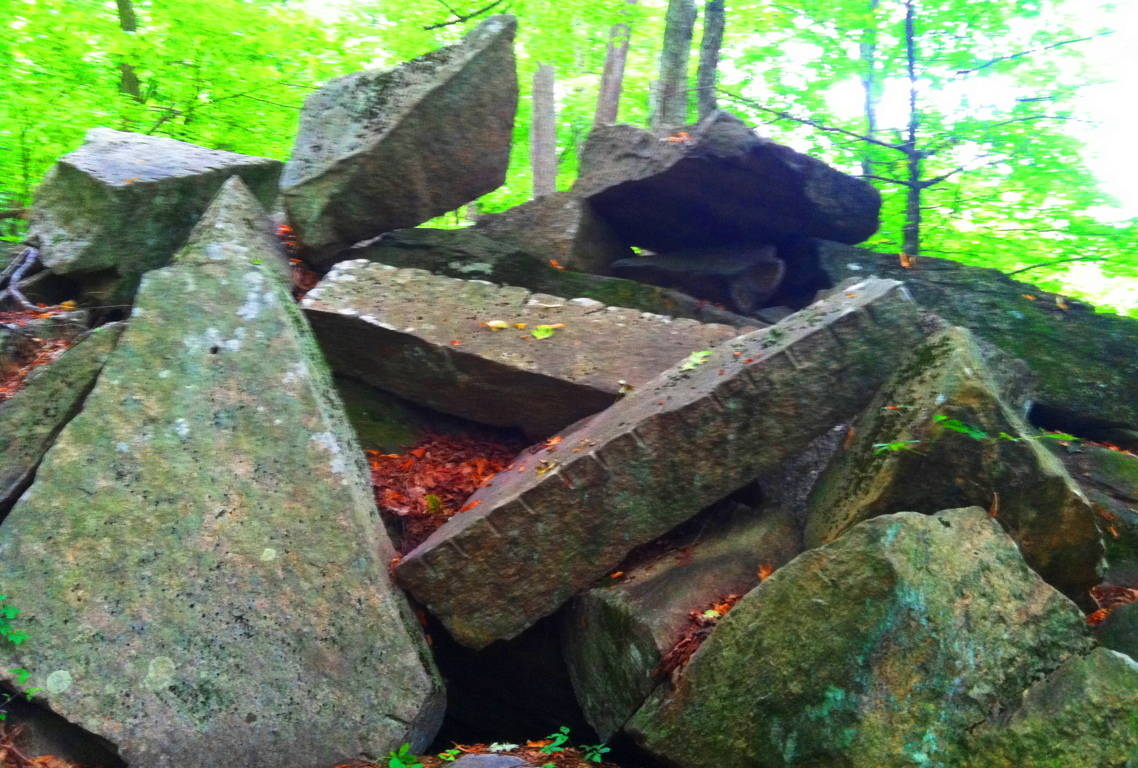 Some of the stones look to be placed in specific places, while others look to have been tossed about like giant toy blocks. The incrementation markings on the huge stones are not in inches or centimeters, they are some other form of measurement entirely. The image above is of two rather long rectangular pieces thrown into a pile at Rattlesnake’. Pieces exactly like this exist at the pass of Mount Bearnagh in Ireland (image below)…
Some of the stones look to be placed in specific places, while others look to have been tossed about like giant toy blocks. The incrementation markings on the huge stones are not in inches or centimeters, they are some other form of measurement entirely. The image above is of two rather long rectangular pieces thrown into a pile at Rattlesnake’. Pieces exactly like this exist at the pass of Mount Bearnagh in Ireland (image below)… They also exist at Lynn Woods Reserve in Lynn Massachusetts (image below)…
They also exist at Lynn Woods Reserve in Lynn Massachusetts (image below)…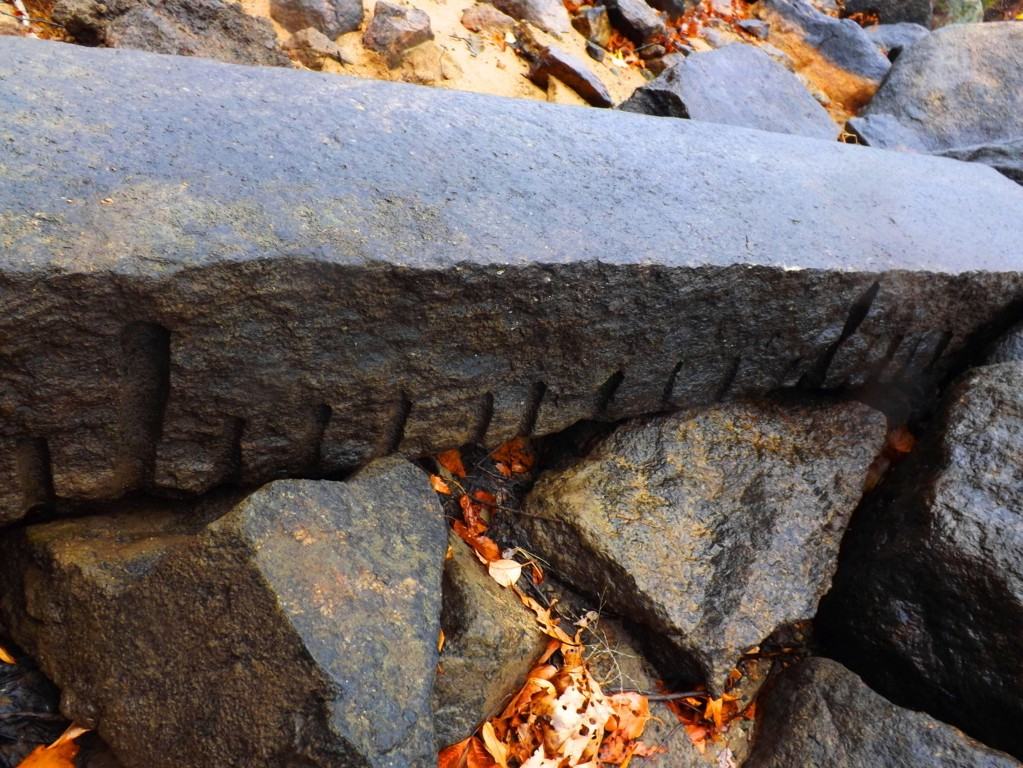 which is 40 miles east of here. Look at the incrementation on the stone in Lynn Woods; between the long marks are 9 short marks. What system of measurement uses increments of 9? And there are countless other places throughout New England where this specific type of rectangular piece can be found. As documented proof of these megalithic stones is slowly compiled, it becomes clear that our modern culture is built directly over what was once a megalithic culture. In old-growth forests and mountain ridges where houses have never been built the evidence for this culture still remains. And please remember, these stones are several tons each, if not more. Whoever cut and placed them, had the ability to do so, and without strain. Other stones beneath the ridge are smaller square pieces (image below)…
which is 40 miles east of here. Look at the incrementation on the stone in Lynn Woods; between the long marks are 9 short marks. What system of measurement uses increments of 9? And there are countless other places throughout New England where this specific type of rectangular piece can be found. As documented proof of these megalithic stones is slowly compiled, it becomes clear that our modern culture is built directly over what was once a megalithic culture. In old-growth forests and mountain ridges where houses have never been built the evidence for this culture still remains. And please remember, these stones are several tons each, if not more. Whoever cut and placed them, had the ability to do so, and without strain. Other stones beneath the ridge are smaller square pieces (image below)…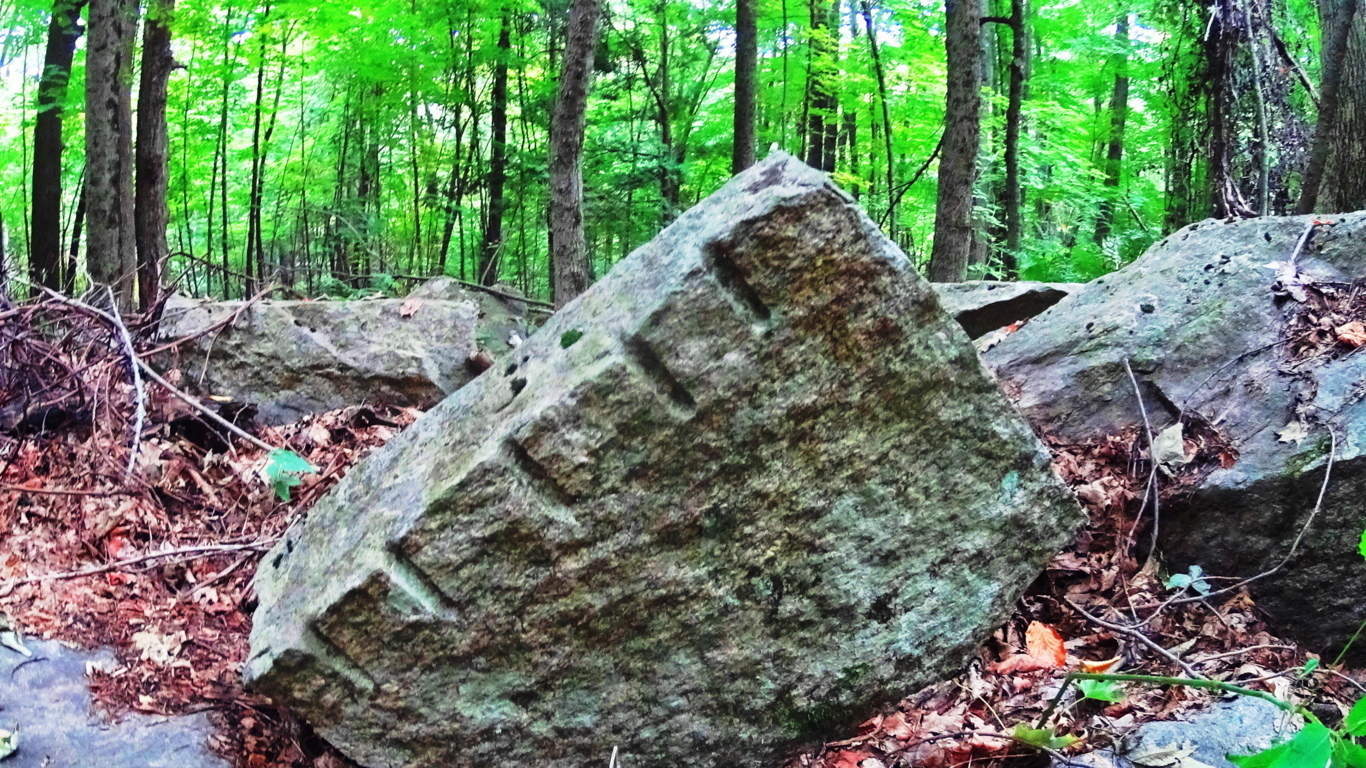
And more stones can be found here, some covered by countless seasons, or are partially entrenched in the earth. It becomes clear that someone literally went to work in this area, and was utilizing megalithic size stones the way a carpenter uses wood blocks (images below)…
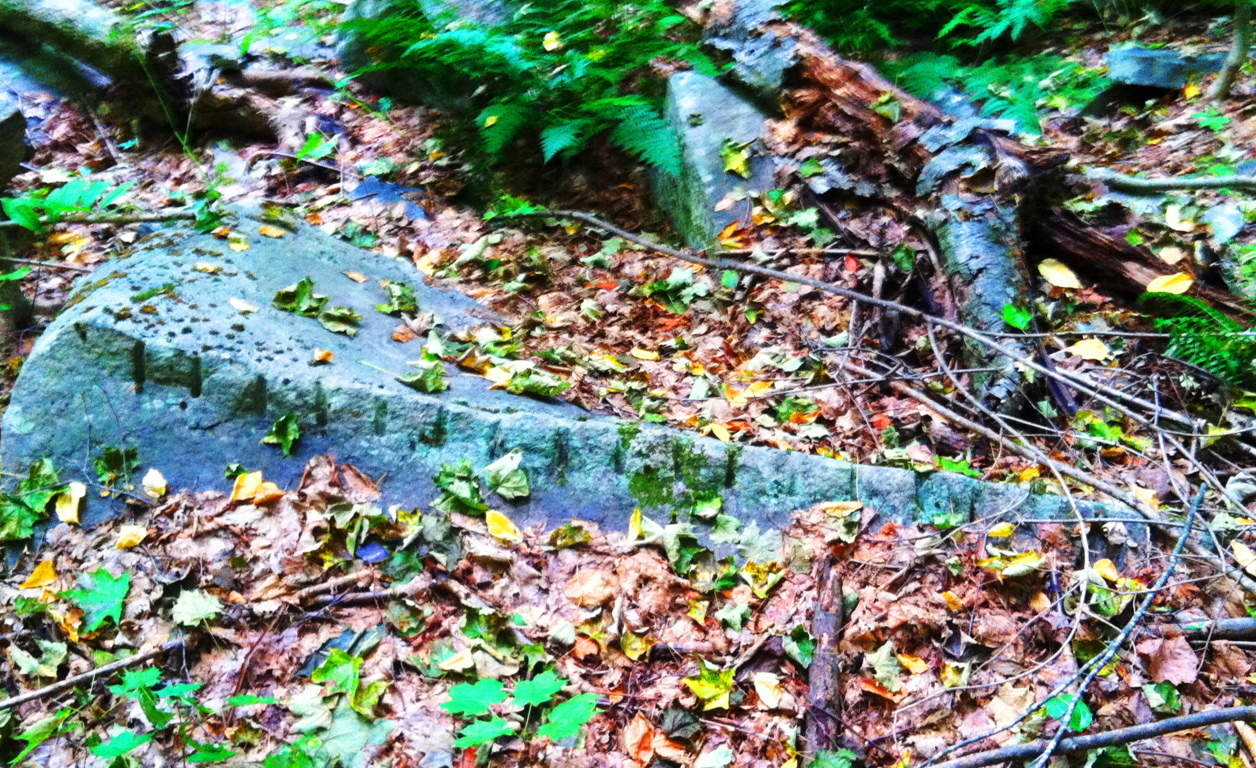
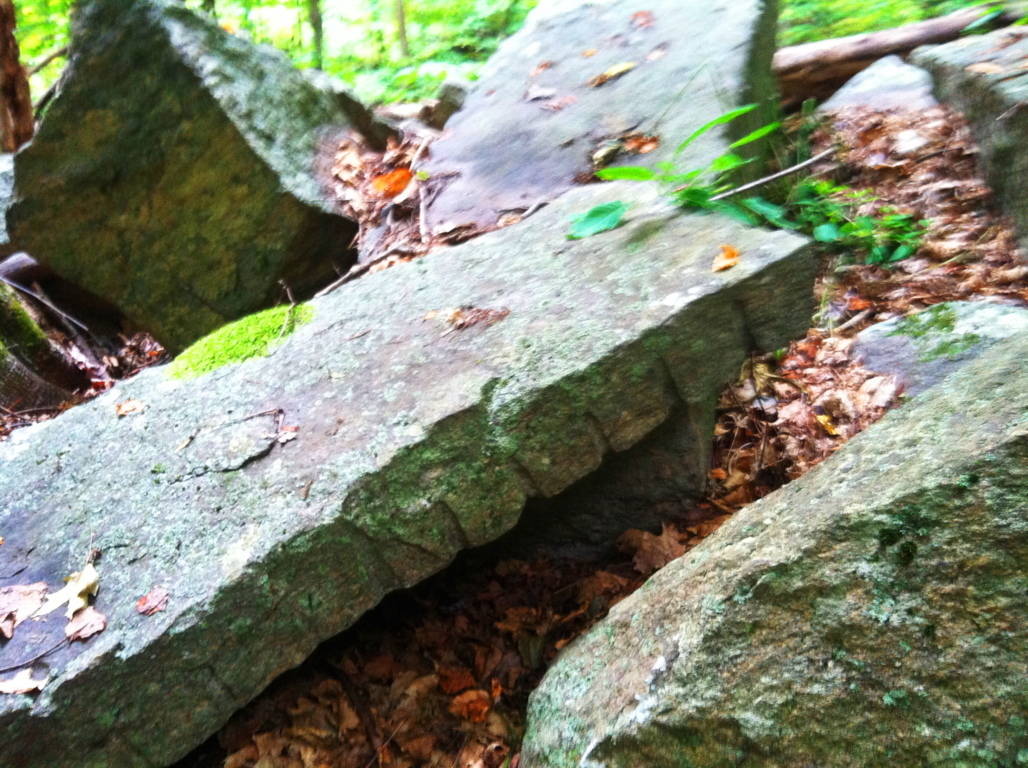
As you head east along the initial trail, passing by these monoliths and huge fixtures, there are other stones that emerge which are relevant to the patterns of megaliths in New England. The equilateral triangle has showed its face in stone in almost every deep woods hiking trail and reserve from northern Maine to western Massachusetts. Here, somehow fixed into a boulder, was a perfect equilateral triangle (image below)…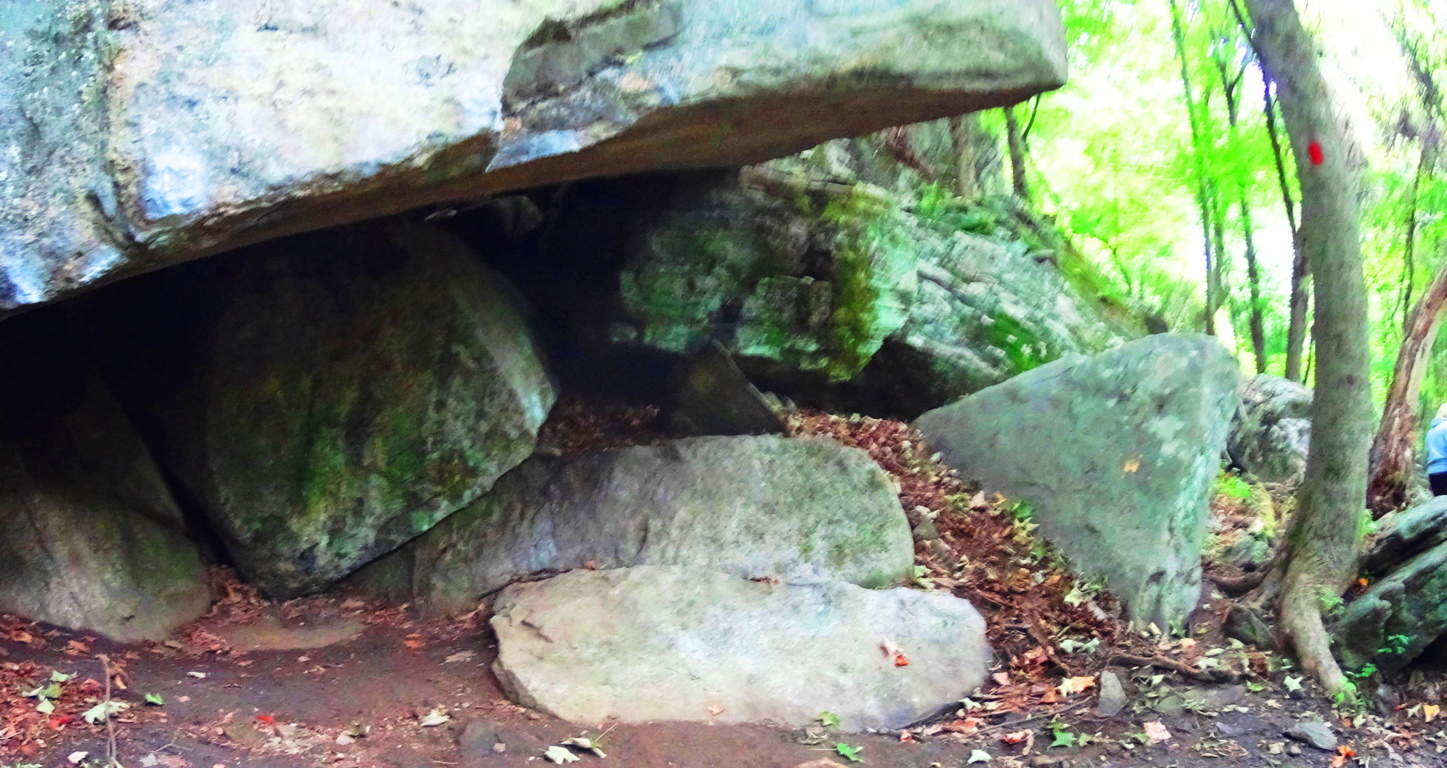 It is at the center of this massive fixture, with a cubicly cut stone to its left, and another perfect equilateral to its right. All of this is under a rock precipice serving as a roof which looks to weigh about 100 tons. The overall symmetrical setting is above (image above), with the central equilateral in the middle, sitting on a perfectly leveled shelf of stone. Please understand, this stone is part of the boulder beneath it; it was carved out to protrude specifically in this fashion. I could not move it. Here’s a closer look (image below)
It is at the center of this massive fixture, with a cubicly cut stone to its left, and another perfect equilateral to its right. All of this is under a rock precipice serving as a roof which looks to weigh about 100 tons. The overall symmetrical setting is above (image above), with the central equilateral in the middle, sitting on a perfectly leveled shelf of stone. Please understand, this stone is part of the boulder beneath it; it was carved out to protrude specifically in this fashion. I could not move it. Here’s a closer look (image below)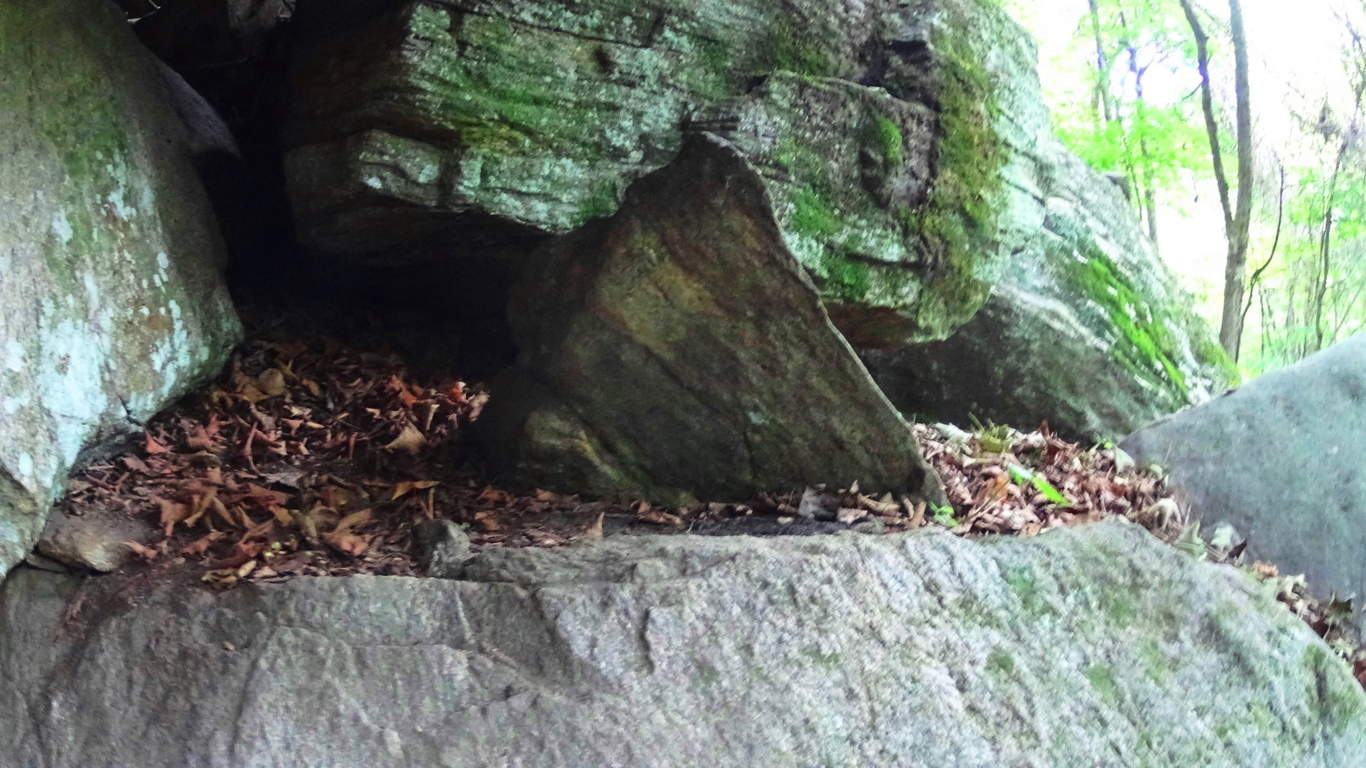 Just a few feet up the trail is another fixture with a equilateral triangle that is guarded by several massive stones. This stone is not only an equilateral, but is a three sided prism that is connected to the boulder beneath it. (image below)
Just a few feet up the trail is another fixture with a equilateral triangle that is guarded by several massive stones. This stone is not only an equilateral, but is a three sided prism that is connected to the boulder beneath it. (image below)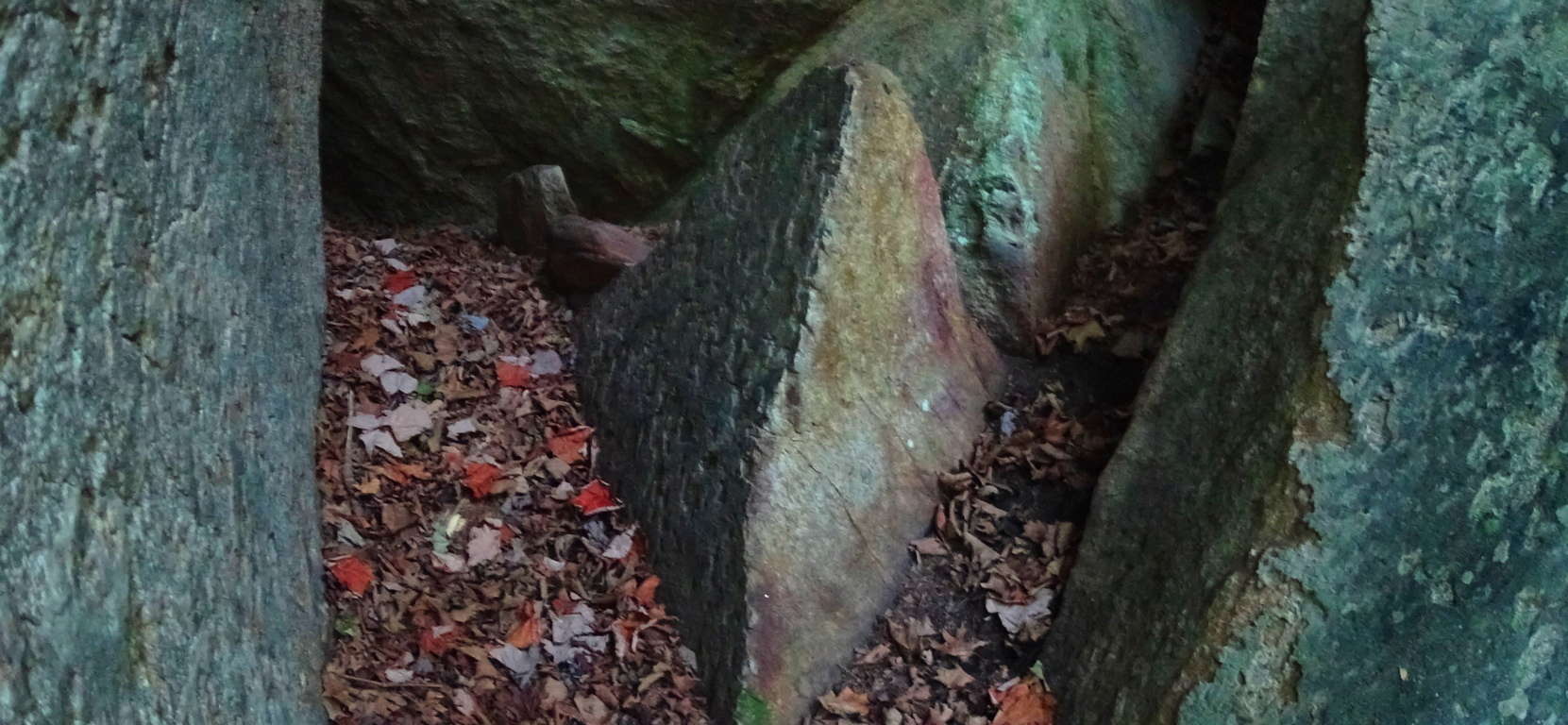 In the woods of Upton Massachusetts there are granite cut equilateral prisms attached to the boulders beneath them (image below), extremely similar to these stones found at Rattlesnake’.
In the woods of Upton Massachusetts there are granite cut equilateral prisms attached to the boulders beneath them (image below), extremely similar to these stones found at Rattlesnake’. I believe the Triangle is the megalithic “calling card” of the ancient culture that once dwelt in the hills of New England, just as the Spiral was the calling card of the megalithic culture that once dwelt once dwelt in Ireland. If you recognize this, then you will realize that New England, in its own way, is a landscape that is just as mythical and beautiful as those traditionally endeared in England, Ireland, Scotland, and Wales. When you hike through these small mountains, you’re hiking through zones of ancient mysteries yet to be solved, but can be seen right before your eyes. The trees of woods are spaced amicably, with small groves of baby pines and birches emerging in various areas. Enjoy these beautiful groves (image below )…
I believe the Triangle is the megalithic “calling card” of the ancient culture that once dwelt in the hills of New England, just as the Spiral was the calling card of the megalithic culture that once dwelt once dwelt in Ireland. If you recognize this, then you will realize that New England, in its own way, is a landscape that is just as mythical and beautiful as those traditionally endeared in England, Ireland, Scotland, and Wales. When you hike through these small mountains, you’re hiking through zones of ancient mysteries yet to be solved, but can be seen right before your eyes. The trees of woods are spaced amicably, with small groves of baby pines and birches emerging in various areas. Enjoy these beautiful groves (image below )… 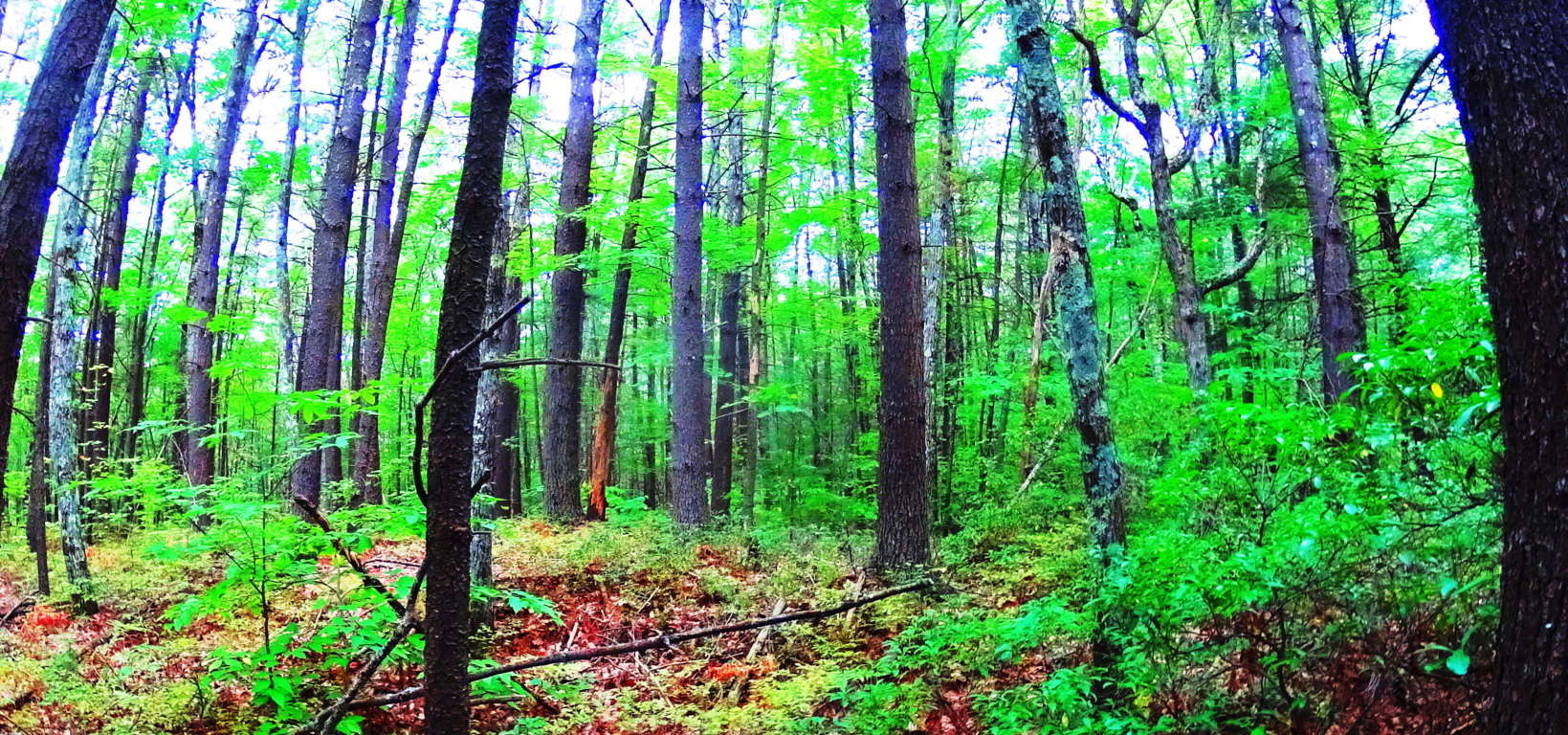 With all of this existing right infornt of you, it can be hard to get back to the natural beauty of the trail ahead, which is another wonderful aspect to hiking the forests of New England and Rattlesnake Mountain. As you step away from these mysterious alters beneath the grand ledge, continue east. After about 1/4 mile you will come to a stream rolling down the mountain from above (image below).
With all of this existing right infornt of you, it can be hard to get back to the natural beauty of the trail ahead, which is another wonderful aspect to hiking the forests of New England and Rattlesnake Mountain. As you step away from these mysterious alters beneath the grand ledge, continue east. After about 1/4 mile you will come to a stream rolling down the mountain from above (image below). Turn to follow this stream upward, as you are now on the eastern extremity of the trail (image below).
Turn to follow this stream upward, as you are now on the eastern extremity of the trail (image below).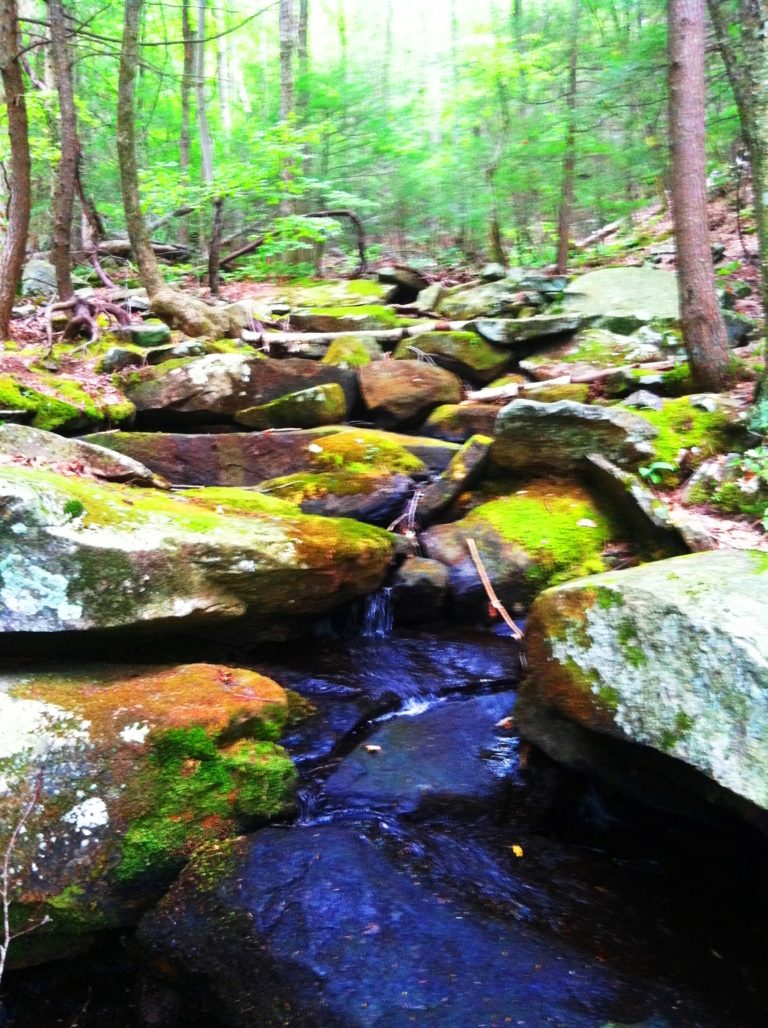
This waterway is so similar to Celtic scenes that you might find at Tollymore Forest in Ireland, or Killarney National Park. The rocks are strewn over the flowing water, with glowing moss beyond. Following the waterways clears the senses and improves your “sound palate” with the soft trickling and smooth rolling of water over stone. This consistency of sound eliminates the sensory overload we experience in our daily lives, which have become controlled blasts of commercial intrusions. One walk along these streams can clear your head for days. Continue up the incline which follows the stream until the trail crosses over the water, to left, at the top of the hillside. The trail continues into an elevated old-growth forest with a classic New England blend of Oak, Maple, Pine, Beech, and Birch trees. Looking northward this forest continues all the way into Vermont.(image below)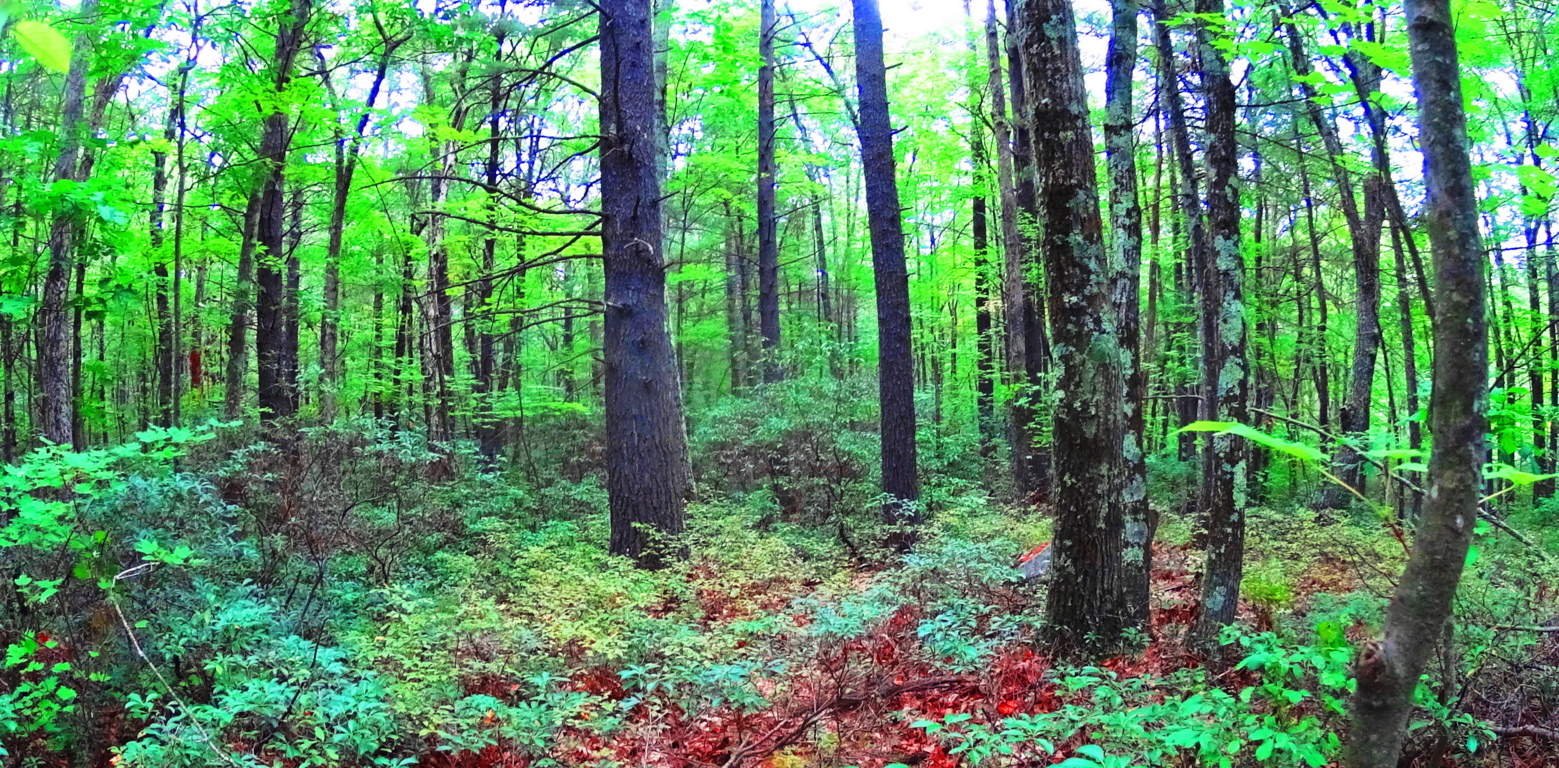 Continuing west on the elevated trail there are minature ledges with tiny pillars creating a tiny cavern on the underside of the precipice (image below)…
Continuing west on the elevated trail there are minature ledges with tiny pillars creating a tiny cavern on the underside of the precipice (image below)…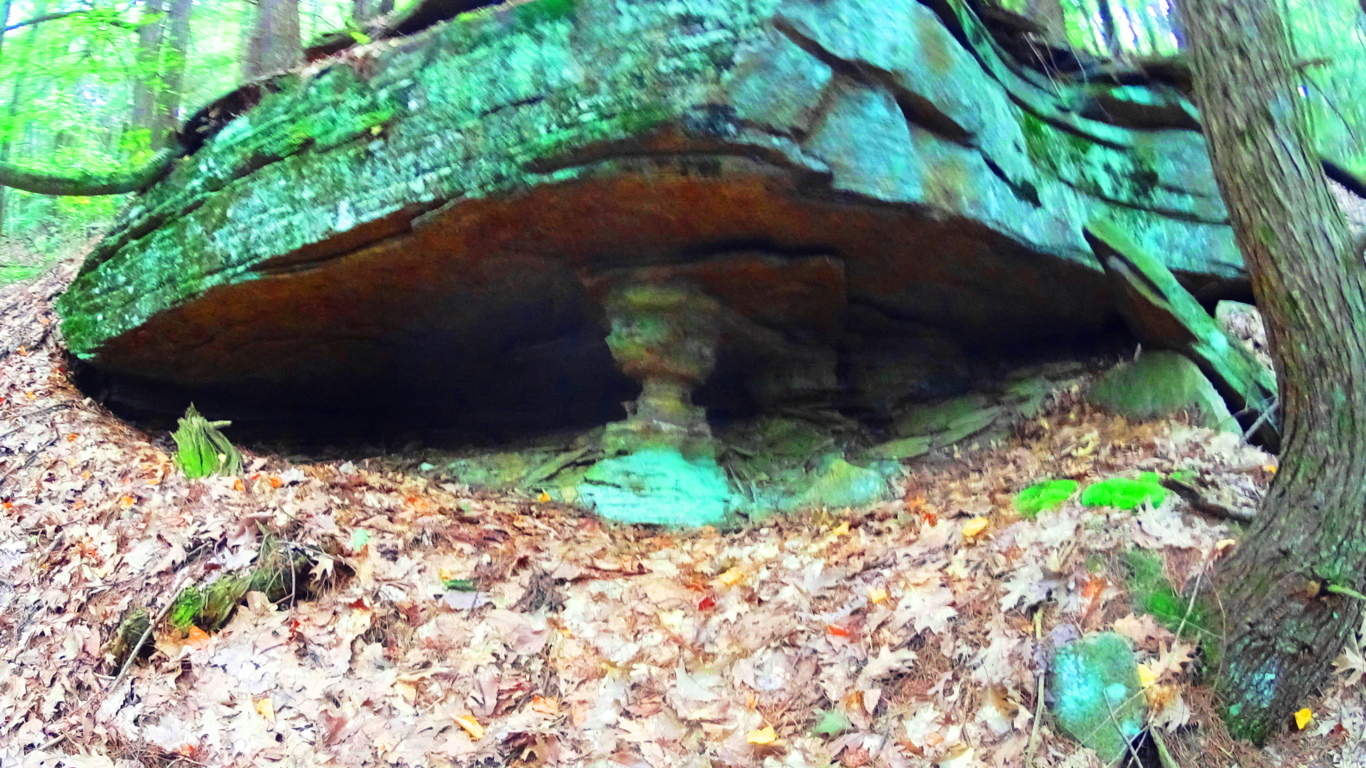 At Cavan Burren National Park in Ireland, where there are some of the most astounding Celtic megalithic monuments in the world, there are also notable stone ledges with the small pillars creating a cavern beneath the tiny granite ridge (image below)…
At Cavan Burren National Park in Ireland, where there are some of the most astounding Celtic megalithic monuments in the world, there are also notable stone ledges with the small pillars creating a cavern beneath the tiny granite ridge (image below)…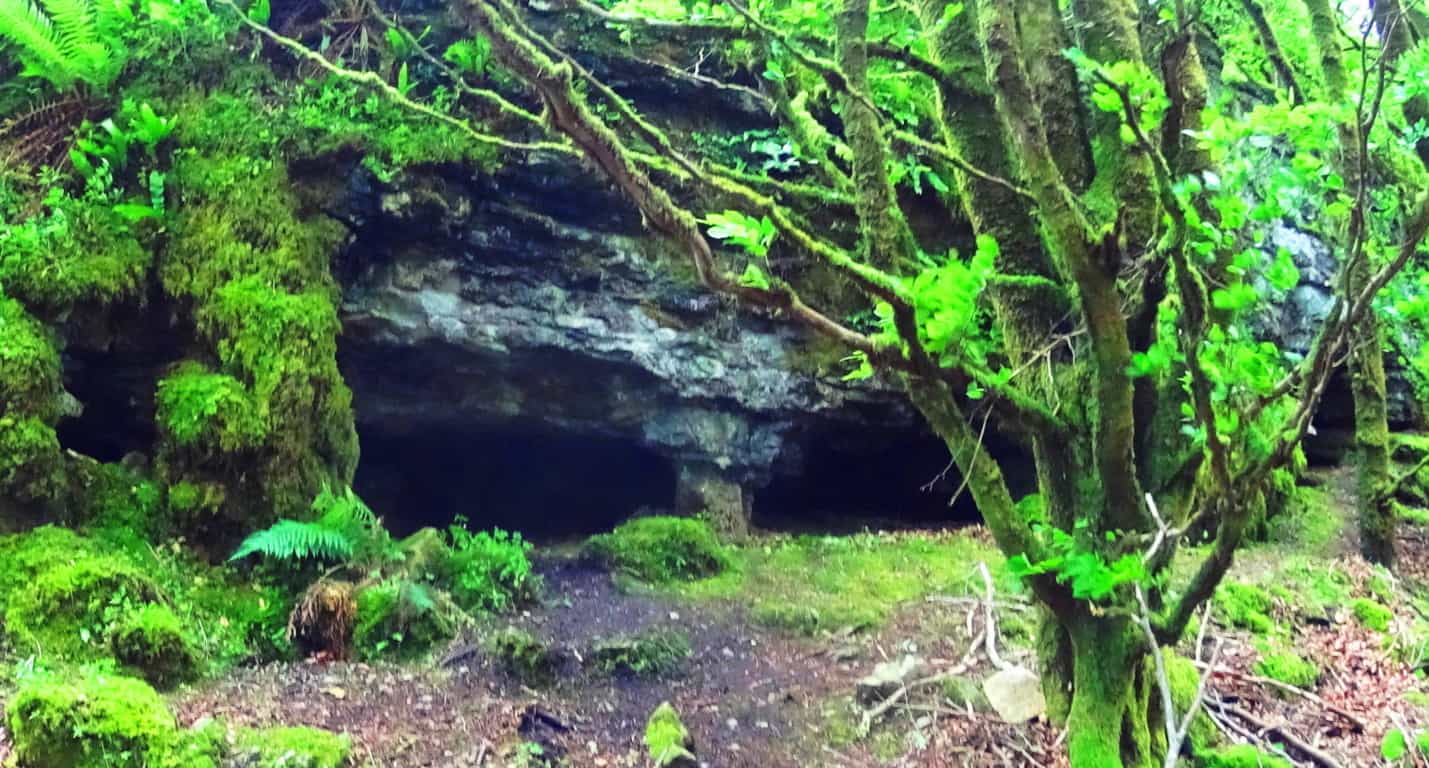 After passing these curious small pillars the trail continues west for about a mile, where other large flat cliffs emerge to the north. These gigantic shelves are layered in loose parallel shafts for 50 to 100 yards each, at about 45 feet in height. (image below)
After passing these curious small pillars the trail continues west for about a mile, where other large flat cliffs emerge to the north. These gigantic shelves are layered in loose parallel shafts for 50 to 100 yards each, at about 45 feet in height. (image below)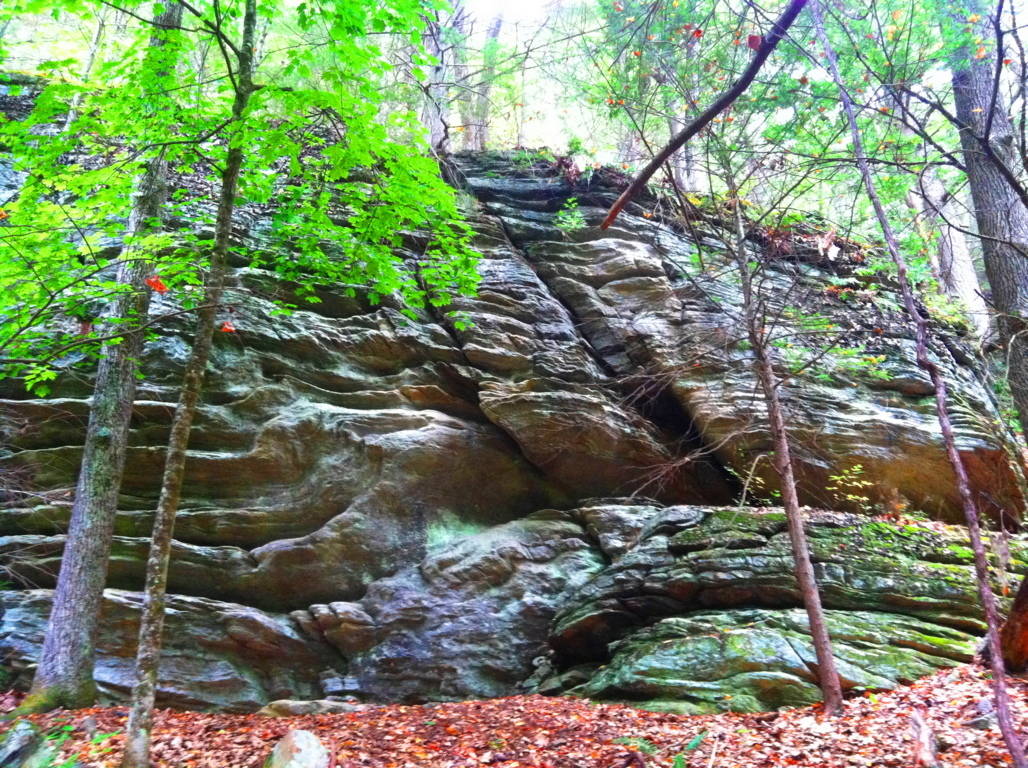
In some places there are small standing stones at the edges of these small cliffs (below)…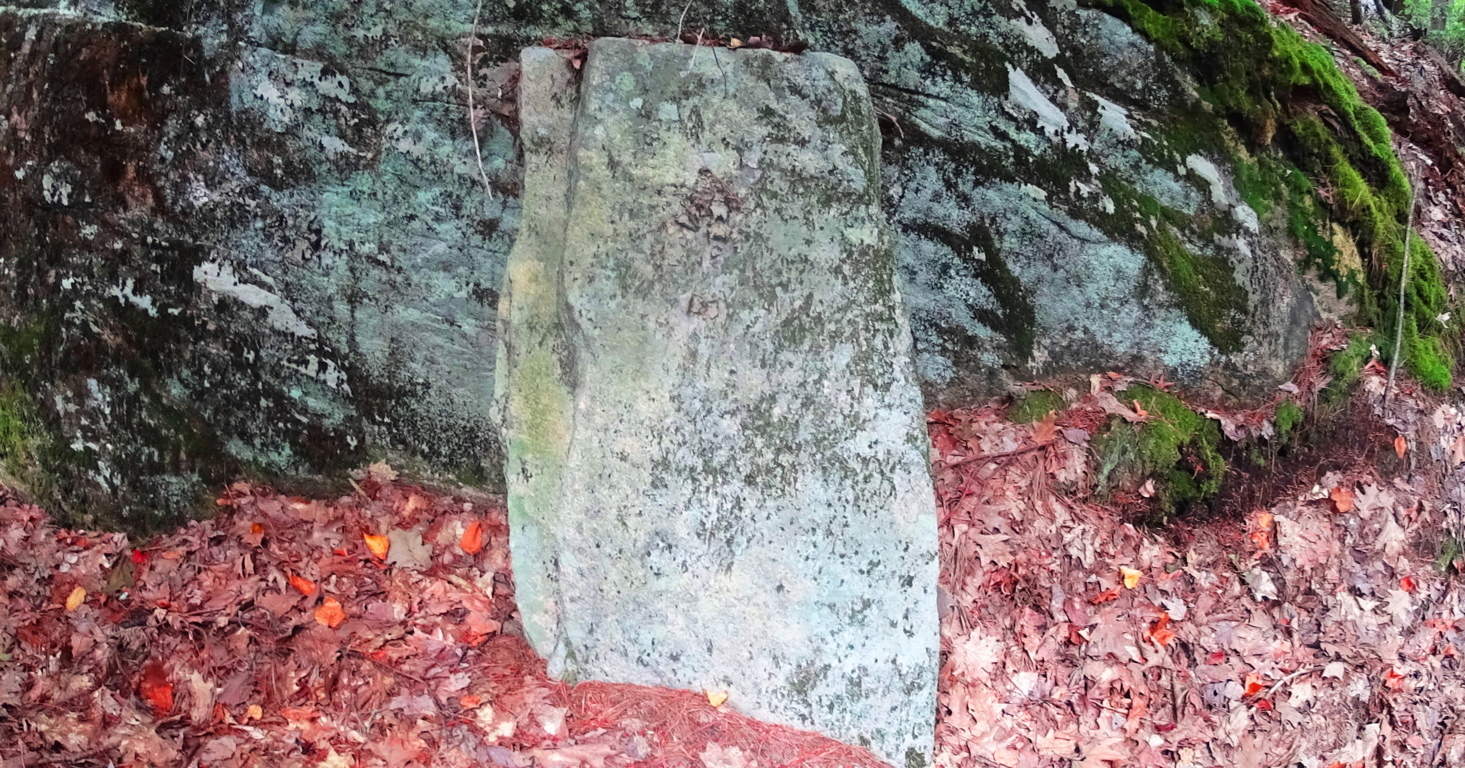
A similar stone in the historically megalithic town of Upton stands, just like this stone in Rattlesnake’, along a large stone-lining near the ancient Upton Chamber (below)…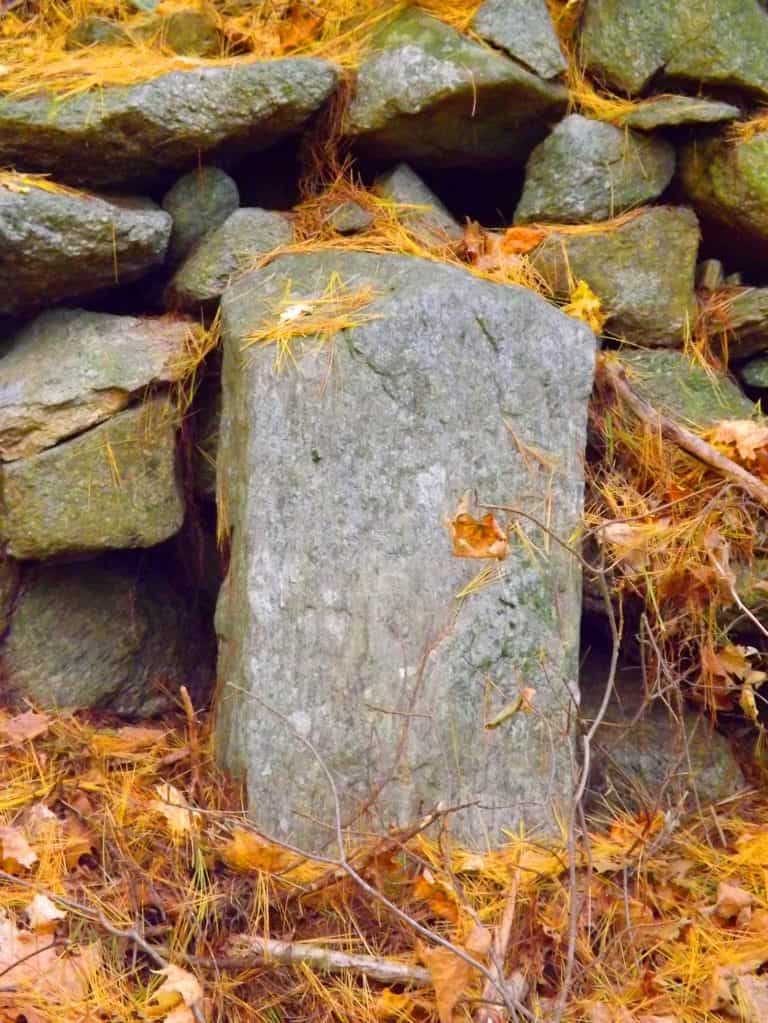
Keep in mind that these are not “small” stones, they are cut and crafted granite pieces that go as far into the ground as they are above; and they are perfectly squared. They are clearly a cultural marker of some kind created in antiquity. You will continue to follow the trail west until it turns left again, towards the western edge of the Farley Ledges, where the best lookout of the trail is found after about another 1/4 mile.  The woods on this western edge of the trail are massive shelves and boulders overgrown with classic New England Fauna (image below)…
The woods on this western edge of the trail are massive shelves and boulders overgrown with classic New England Fauna (image below)…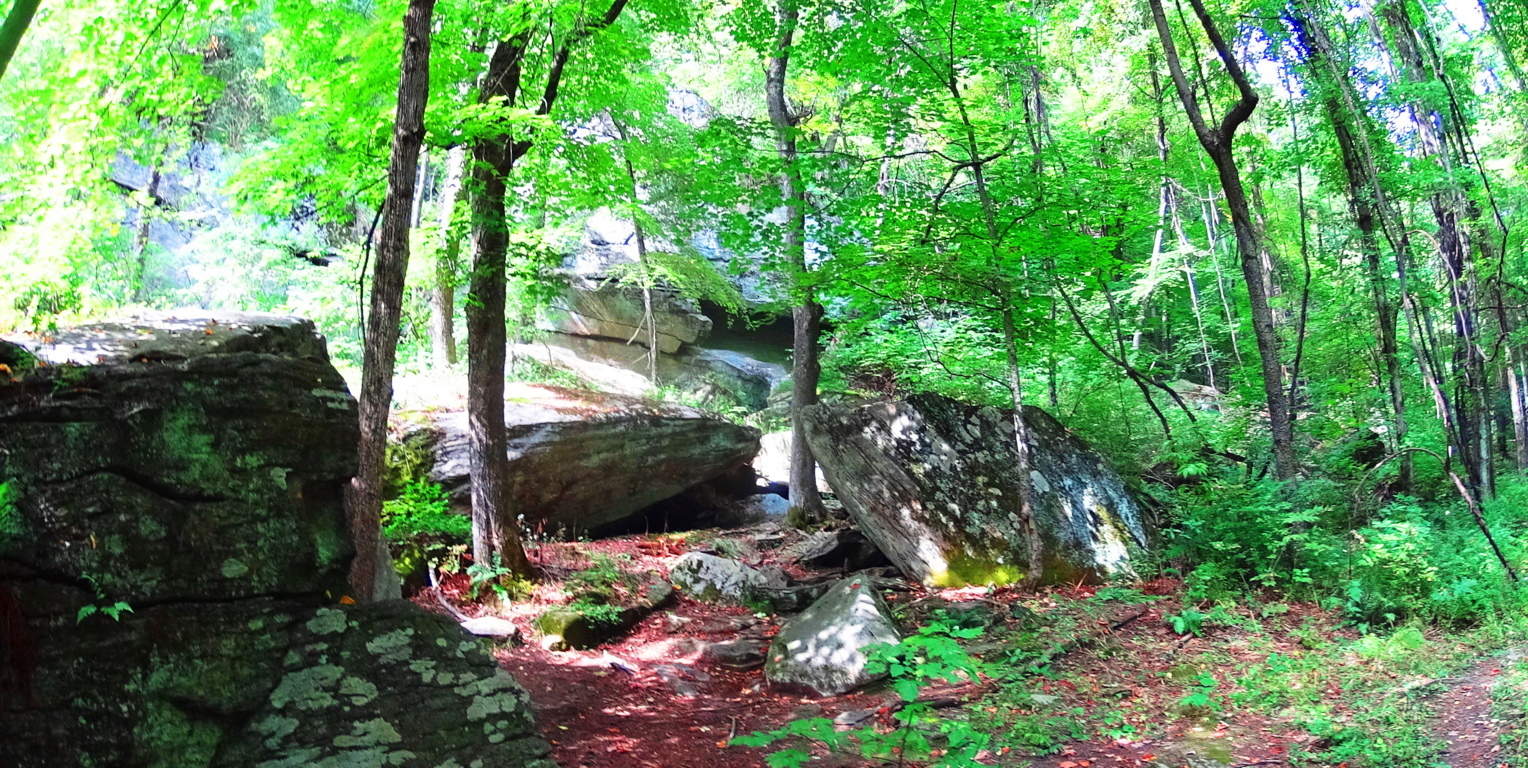 At the western extreme of the trail, over looking Route 2A, is the southerly view of the heart of Massachusetts (image below)…
At the western extreme of the trail, over looking Route 2A, is the southerly view of the heart of Massachusetts (image below)… 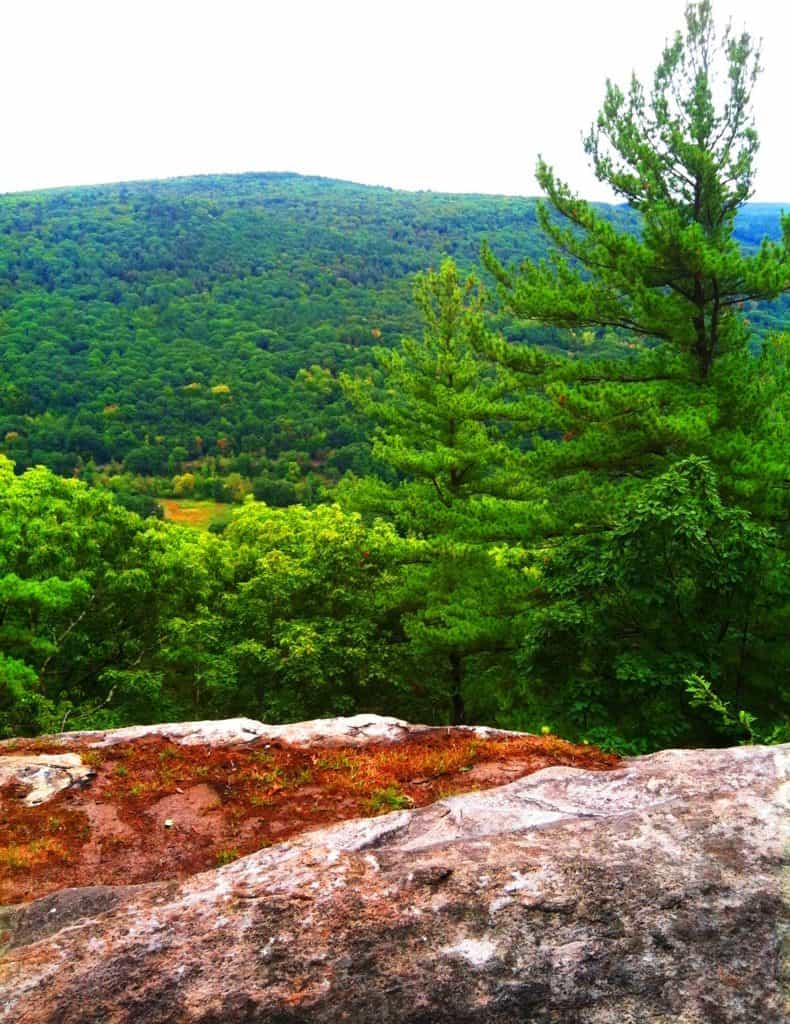
After taking in this view, the last portion of the loop descends back along Farley Ledge to the east. There are miniature canyons below, and gigantic granite walls slicing through the hills (image below)…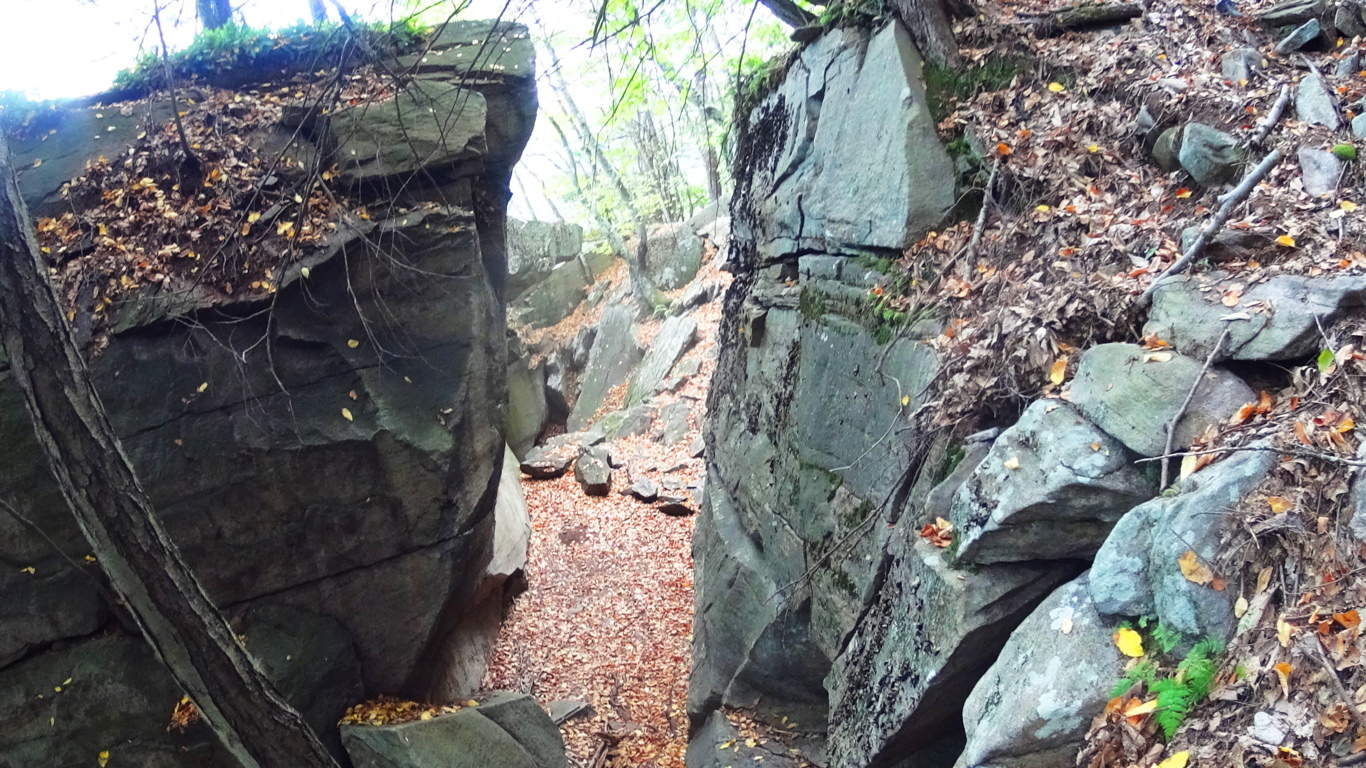 You will eventually come to a lower crossing of the stream at the eastern edge of the trail, then head back down to the megaliths below at Farley Ledge.
You will eventually come to a lower crossing of the stream at the eastern edge of the trail, then head back down to the megaliths below at Farley Ledge.
Rattlesnake Mountain is yet another example of classic New England hiking that combines practically magical megalithic statements in the forest and mountains with a pristine hiking experience. Time after time, forests and mountains of Celtic and New England places reveal a related megalithic mystery yet to be acknowledged by so many academics. Rattlesnake is clearly one of these sacred places, and it will grant the hiker a vision of something miraculous, something which is calling out to us from a culture that left its mark in a way that will never fade. You can touch these signature stones yourself, see the size and scope of them, walk the trails, and simply wander right into the hallowed wonder of it all.
The Blue Hills Wildlife Preserve
 Location Milton, Massachusetts
Location Milton, Massachusetts
Note: The Blue Hills is a quintessential New England hiking area, with the perfect combination of rocky pathways, quiet groves, elevated vistas, and mysterious stones. Trails include the Walcott Loop, the Skyline Trail, Rattlesnake Trail, Great Blue Hill, and dozens of minor trails to be discovered. Great Blue Hill is the highest elevation here at 695 feet. There is over 6000 acres to explore, with the option to mountain-bike, which thousands of people enjoy during the Spring season. There is preserved old-growth forest, inclusive of 100 foot Pines, small Birch groves, Hemlocks, and Oaks. Some of the trails are wide pathways lined with small cut stones, while others are staircases cut right out of the hills.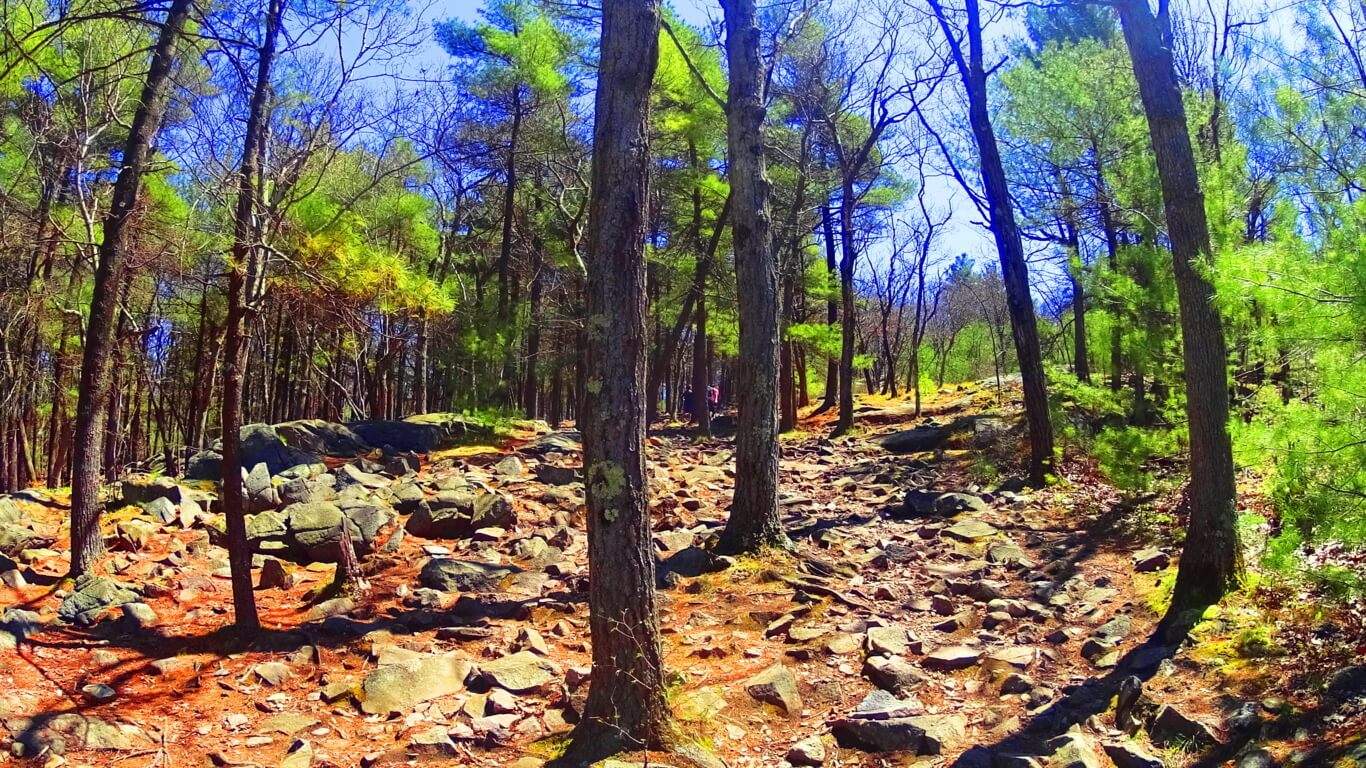 Blue Hills was a sacred place for the Native Americans for thousands of years before the Europeans arrived. We can certainly see why. The Colonials that arrived in the “New World” were fleeing what they considered to be a completely bought-out scene in England, Scotland, and Ireland. Lords and Men-of-property owned, and taxed, all the land, from the Medieval period into the Colonial. The 17th century in Europe was actually a “late’ period in terms of land ownership. Everything was owned. There was nothing left. Christian Puritans found the state of affairs in London, and elsewhere, intolerable. They decided to take their chances on getting their own land across the Atlantic Ocean. When these mostly poor pilgrims, explorers, trappers, and farmers arrived, and began to explore the forests and hills of this wilderness, what they found, in places like Blue Hills, would absolutely astonish them.
Blue Hills was a sacred place for the Native Americans for thousands of years before the Europeans arrived. We can certainly see why. The Colonials that arrived in the “New World” were fleeing what they considered to be a completely bought-out scene in England, Scotland, and Ireland. Lords and Men-of-property owned, and taxed, all the land, from the Medieval period into the Colonial. The 17th century in Europe was actually a “late’ period in terms of land ownership. Everything was owned. There was nothing left. Christian Puritans found the state of affairs in London, and elsewhere, intolerable. They decided to take their chances on getting their own land across the Atlantic Ocean. When these mostly poor pilgrims, explorers, trappers, and farmers arrived, and began to explore the forests and hills of this wilderness, what they found, in places like Blue Hills, would absolutely astonish them. 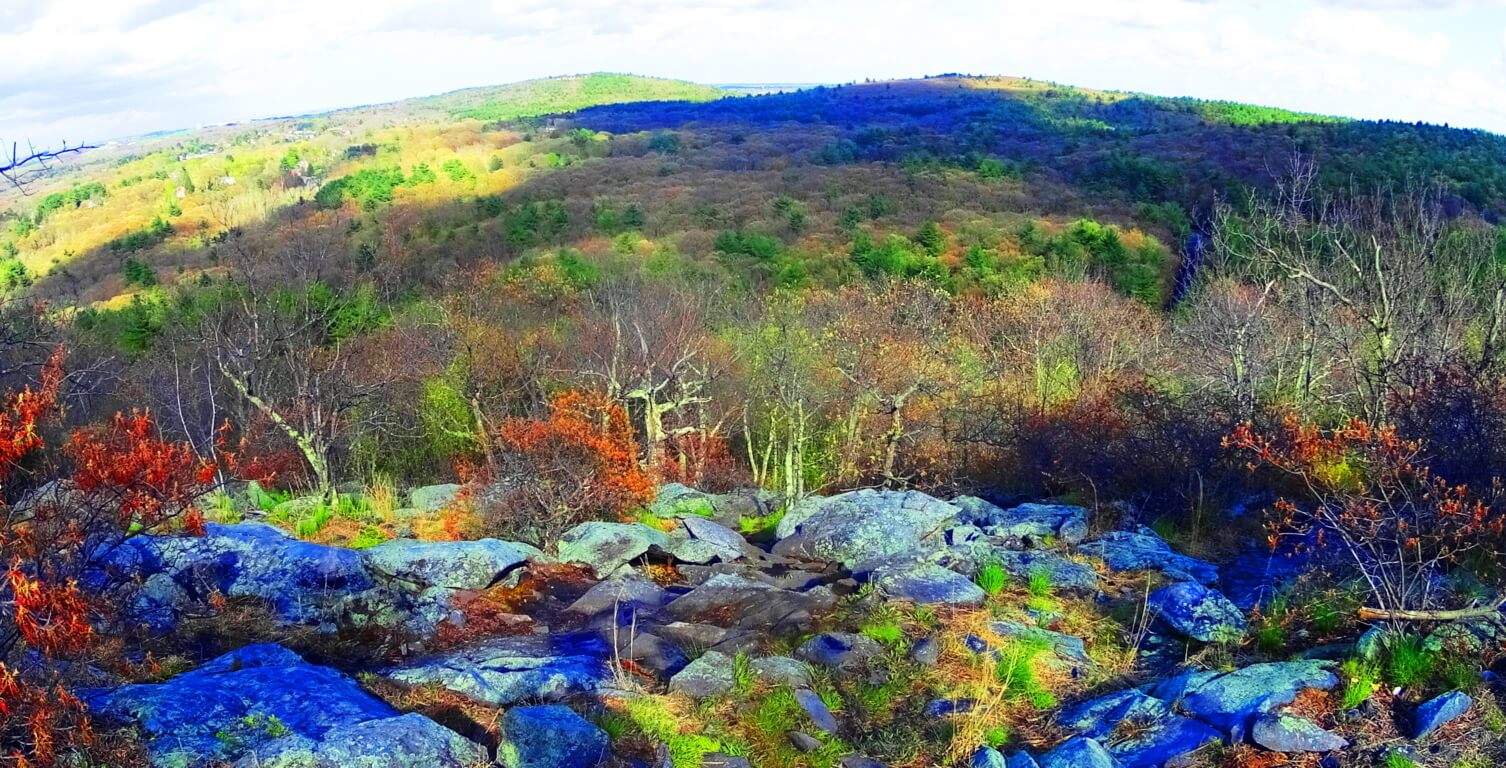 Secret History: The image above is a look at the countryside southwest of the beautiful city of Boston in April 2016. It was in this exact season in 1775 that King George of England issued a mandate to General Thomas Gage for the disarmament of the resistant colonials living in this beautiful region. It was yet another attempt to expand England, and possess these abundantly fertile hills. I have to believe, looking at this picture, that the colonials felt this was a place, if ever there was one, that was absolutely worth fighting for. There is something even deeper about the landscape that colonial farmers must have noticed in their appreciation of the terrain.
Secret History: The image above is a look at the countryside southwest of the beautiful city of Boston in April 2016. It was in this exact season in 1775 that King George of England issued a mandate to General Thomas Gage for the disarmament of the resistant colonials living in this beautiful region. It was yet another attempt to expand England, and possess these abundantly fertile hills. I have to believe, looking at this picture, that the colonials felt this was a place, if ever there was one, that was absolutely worth fighting for. There is something even deeper about the landscape that colonial farmers must have noticed in their appreciation of the terrain.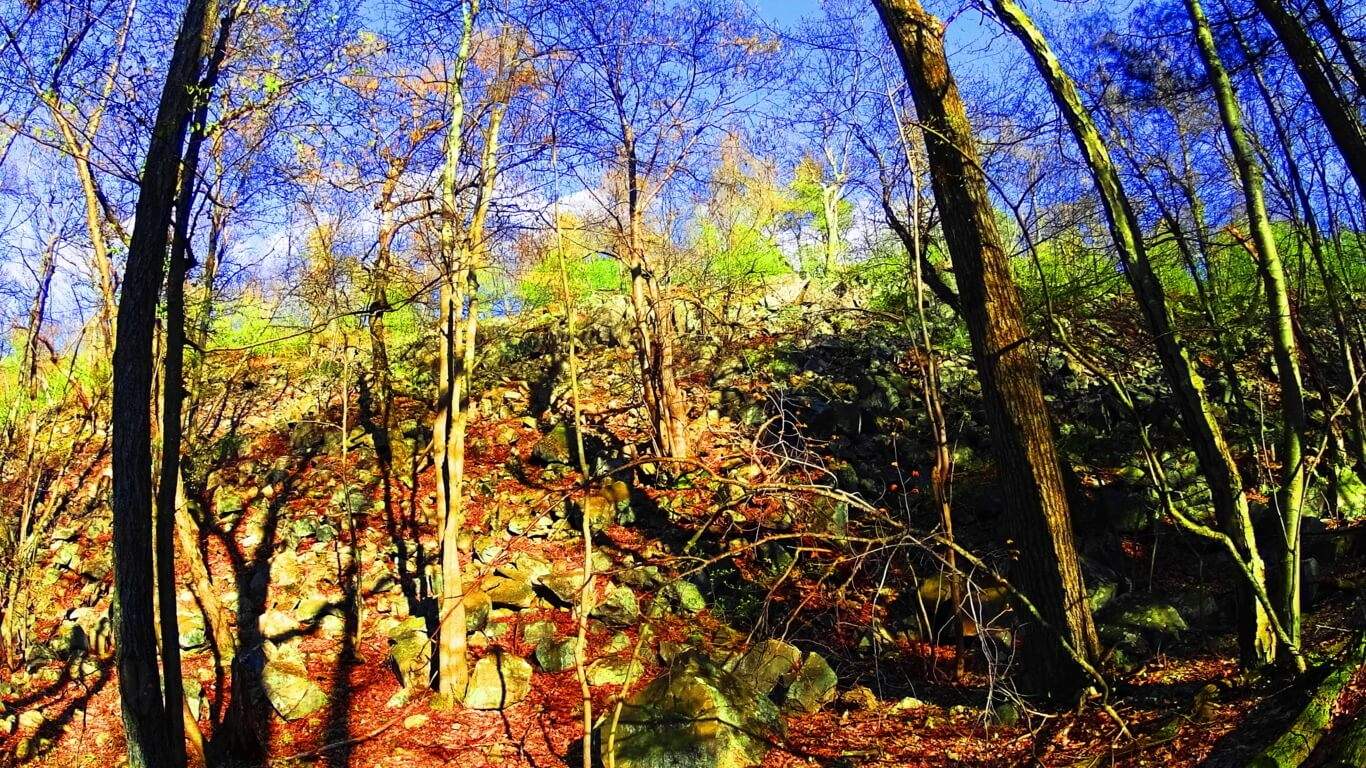 Colonial frontiersmen would have looked for advantageous areas to live, strategically smart elevations close to running streams, with crop potential and forestry for building. Celtic homesteads had been established for almost 1400 years already under the Medieval system back in Ireland and Scotland. Lords possessed the lands with Titles, the best of which long maintained crops, and were often inclusive of megalithic stonewalls that followed riversides to Cairns and Dolmens built in the Celtic era. Men-of-property certainly made the connection that Cairns and Dolmens were a sign of ideal land, almost always placed near resources and advantageous elevations. So it must have seemed miraculous to Colonial frontiersmen when they wandered into the forests and mountains of the “New World” only to discover megalithic stone ‘walls’ already running along the riversides, leading to the most advantageous plots, near streams, peaks, and good soil. Imagine their amazement when they found stone Cairns in these lush areas, with corbel craftsmanship, identical to that of Celtic Cairns in Ireland and England. Native Americans did not claim the stonework. Natives were seasonally nomadic, and were in no way inclined to build stone cities. This is not dismissive of Native American anthropological development. Wooden ‘villages’ expanded into the hundreds of thousands in population in many areas, and were highly sophisticated, but they simply did not work with megalithic stones.
Colonial frontiersmen would have looked for advantageous areas to live, strategically smart elevations close to running streams, with crop potential and forestry for building. Celtic homesteads had been established for almost 1400 years already under the Medieval system back in Ireland and Scotland. Lords possessed the lands with Titles, the best of which long maintained crops, and were often inclusive of megalithic stonewalls that followed riversides to Cairns and Dolmens built in the Celtic era. Men-of-property certainly made the connection that Cairns and Dolmens were a sign of ideal land, almost always placed near resources and advantageous elevations. So it must have seemed miraculous to Colonial frontiersmen when they wandered into the forests and mountains of the “New World” only to discover megalithic stone ‘walls’ already running along the riversides, leading to the most advantageous plots, near streams, peaks, and good soil. Imagine their amazement when they found stone Cairns in these lush areas, with corbel craftsmanship, identical to that of Celtic Cairns in Ireland and England. Native Americans did not claim the stonework. Natives were seasonally nomadic, and were in no way inclined to build stone cities. This is not dismissive of Native American anthropological development. Wooden ‘villages’ expanded into the hundreds of thousands in population in many areas, and were highly sophisticated, but they simply did not work with megalithic stones.
The Unspoken Thing: The unspoken thing about New England, the secret that has gone to the graves of almost every Native American tribe and Colonial woodsmen, is that America was once occupied by a megalithic culture, just like Ireland and England. Imagine if you were a Colonial farmer and you discovered this secret, that the soil and stonework of the ‘New World’ was of the same mystical sanctity of the lands Lords and Title holders had been possessing in domineering fashion throughout European history. Not only was the land giving you the essential signs of quality you were hoping for, but it went a step further, and somehow was revealing Celtic features that you could not in your wildest dreams have imagined existed in this part of the world. It was so completely familiar, but in an entirely new place. They absolutely would’ve taken this as a sign from God, and therefor fought with everything they had to keep it. I truly believe that this was a significant part of the reason why Colonial militiamen met the British on the field of Battle on July 4th of 1776. Colonial farmers must have had in-depth conversations about what they were finding in the woods, Celtic style stone-works that British Lords coveted and valued on their estates for centuries. It would’ve been the ultimate incentive to fight. The Blue Hills Reservation is one of the most beloved remaining testaments to these wonders of the old growth forests, filled with Celtic stonework running along streams, small mountains, and rocky elevations. They are still there today, as the builders obviously intended.
Connections to Ireland: The image below is a stone staircase at one of the main trails at Blue Hills. Notice how this first step is positioned, displaying the markings like an invitation, shown on the top frontal face, rather than tucking it out of sight as masons are trained to do. Whoever built this staircase wanted us to notice the craftsmanship. Everything about it says “notice me”. 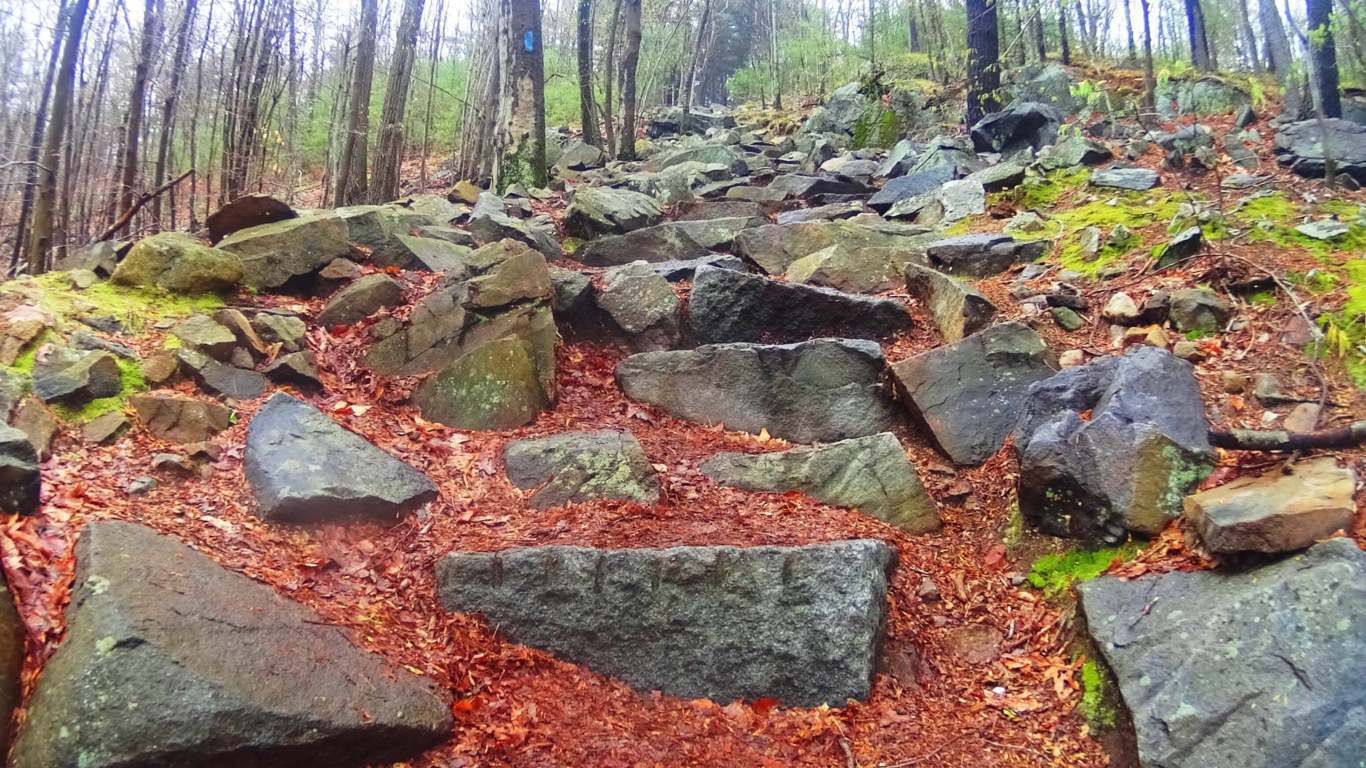 The style of incremented cuts on this blue granite stone is in the exact same style as cuts made to white granite on high elevation staircases at Mount Bearnagh, in the beautiful Mourn Mountain Range of northeast Ireland. Here is a look at one of those stones below, quarried in the heights by stone stairs leading up the mountain, but was never placed in the ground for some reason. The styles are identical
The style of incremented cuts on this blue granite stone is in the exact same style as cuts made to white granite on high elevation staircases at Mount Bearnagh, in the beautiful Mourn Mountain Range of northeast Ireland. Here is a look at one of those stones below, quarried in the heights by stone stairs leading up the mountain, but was never placed in the ground for some reason. The styles are identical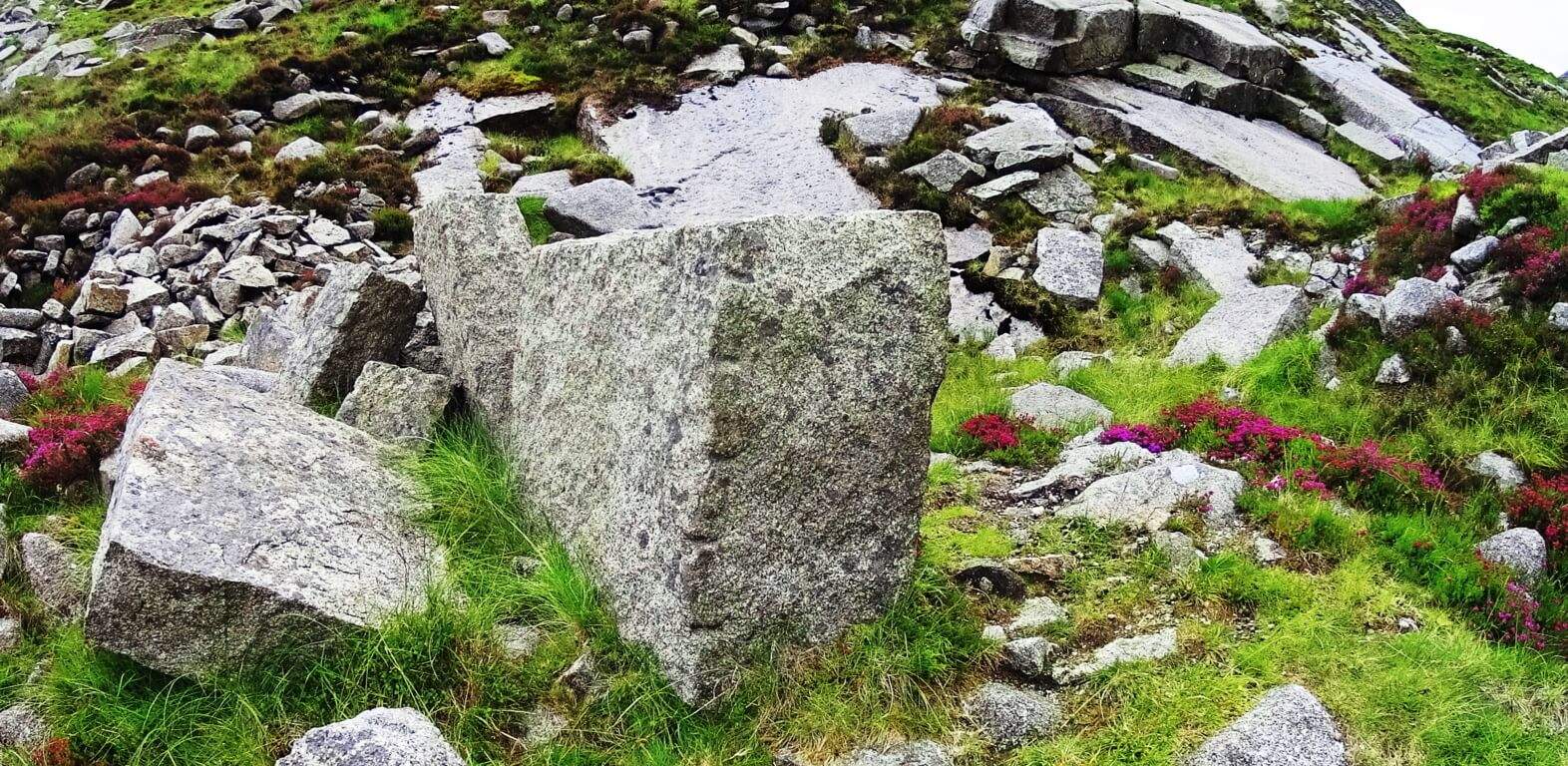 . And just like at Blue Hills, Mount Bearnagh is inundated with other stones all around, that have incremented markings, smoothed surfaces, and right angles.
. And just like at Blue Hills, Mount Bearnagh is inundated with other stones all around, that have incremented markings, smoothed surfaces, and right angles.
Features of Blue Hills: Take a look at this amazing granite standing-stone that rests in a beautiful old growth Pine-glade at Blue Hills. It looks like something out of Game of Thrones. It stands at about 7 feet high, and 3 feet in width. There is no other stone comparable to it within the vicinity.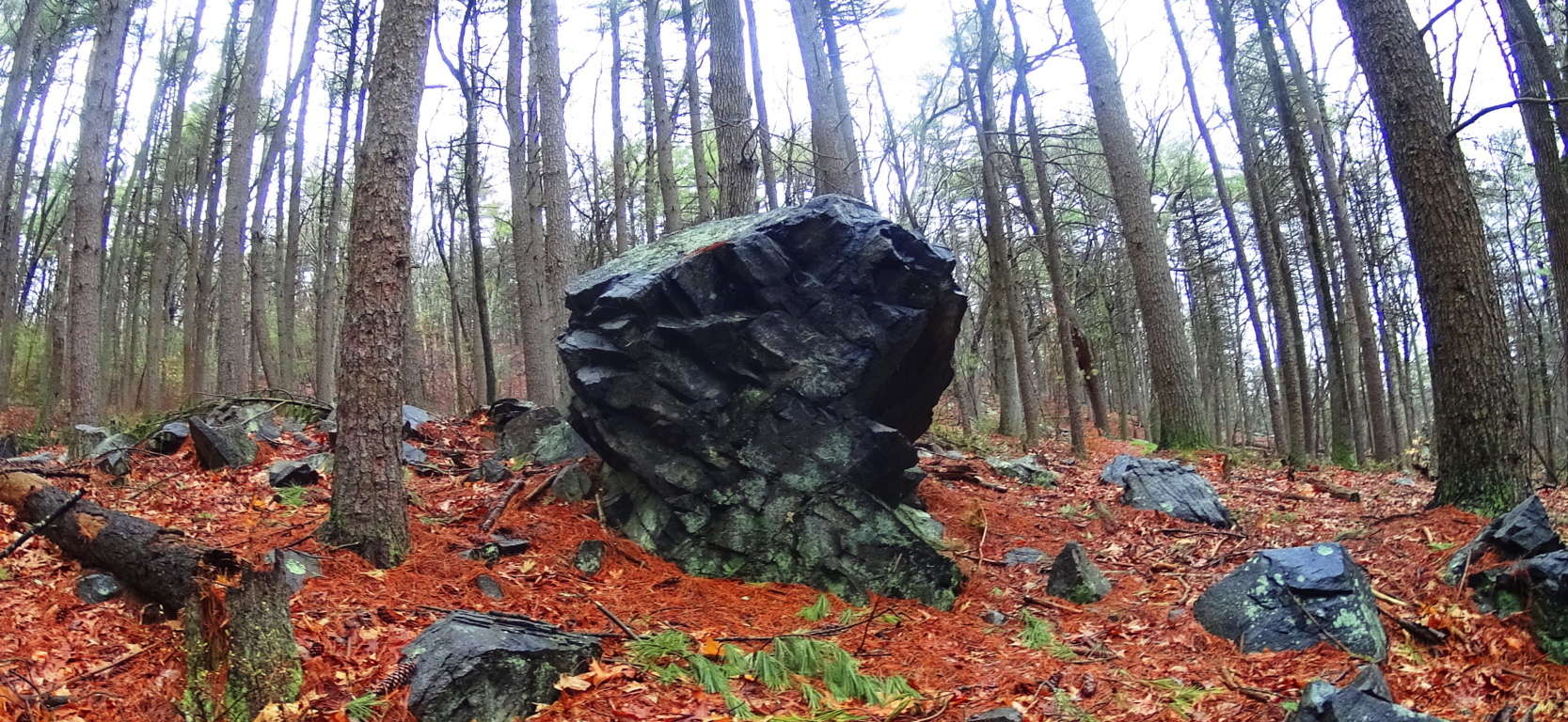 There are angles specifically cut into its sides. It has clearly been worked on. Not only are the angles obvious, but the stones that were cut away are placed all around the area. It looks to be some kind of expression. There are hundreds of thousands of granite pieces that have been worked on all throughout the forests here. Of course, the next question from that statement will be: “What could they do with such a massive amount of cut stones if this happened all over the forests?”
There are angles specifically cut into its sides. It has clearly been worked on. Not only are the angles obvious, but the stones that were cut away are placed all around the area. It looks to be some kind of expression. There are hundreds of thousands of granite pieces that have been worked on all throughout the forests here. Of course, the next question from that statement will be: “What could they do with such a massive amount of cut stones if this happened all over the forests?”
More Irish Connections/Stone-linings: The answer to the question is literally all around the woods: the Stone-linings. What modern anthropologists have mistakingly (and lazily) called “walls”, are more accurately understood to be ‘Stone-linings’ that run, like connecting cables, from peak to peak, and even zig-zag up entire hillsides in some areas. Who builds stone walls that zig zag up a mountain? No one. This Stone-lining phenomenon is also found at Mount Bearnagh in Ireland. Here is a spot in Ireland that illustrates my point clearly; Please take a look at this image of two separate stone projects at the Pass in the heights of Mount Bearnagh; It clearly distinguishes the two structures as absolutely different.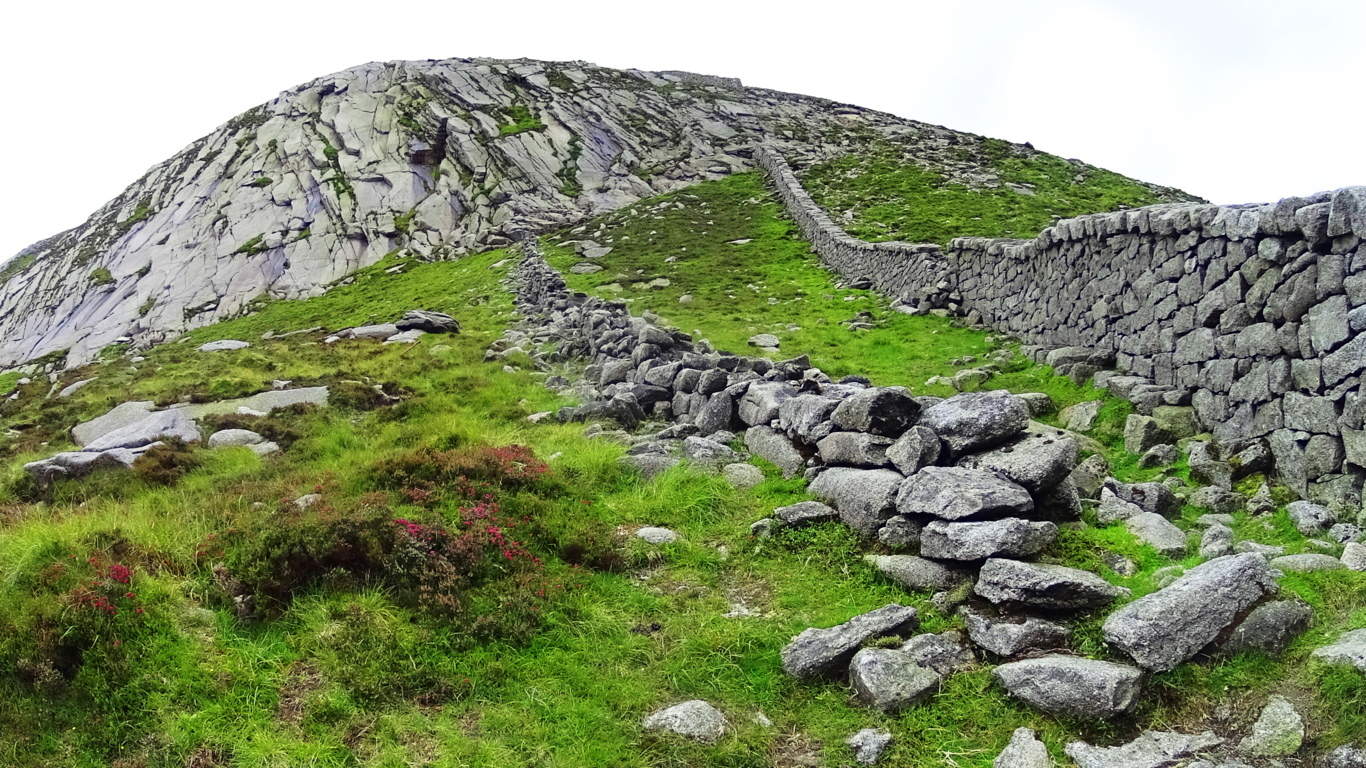
The stones on the far right of this image are clearly crafted as a wall, meant to contain flocks and cattle from drifting into the next valley. It was built by Irish masons in the 17th, or late 18th century. Notice how the stones of this wall are not aligned with the direct center of the mountain beyond, but is right-of-center of the peak, simply stopping once it reaches the cliff side. Since domesticated Cows and Sheep don’t climb vertical cliffs, the purpose of the structure is obviously complete, as a wall. The project on the left in the image, however, is a Stone-lining. It obviously cannot stop the movement of anything. I believe this ‘Lining’ was built by the very first culture in Ireland. As you can see, the stones specifically align towards the center of the mountain beyond, and actually continues up the mountain in massive stacked shelves (if you look close), all the way to the center. What this image doesn’t show us is that in the other direction, the Lining continues towards the center of the opposite peak in the same way. It is evident that this megalithic period structure was intended to connect the peaks, like cables connecting power sources. I have found this same phenomenon at Glenveagh National Park, Ireland, Mount Chocorua New Hampshire, and Mount Monadnock, New Hampshire, as well as dozens of other places. (Noted here on Stonetstrider.com.) One more important thing to consider is that the Irish did not take stones from the Linings to build the wall; Why not? It’s right there, why not use it? The answer is, the Lining is ancient, and sacred, and the Irish know it. They would not touch it. If we now understand that Linings are sacred, and the Blue Hills is literally covered in massive megalithic Linings, that makes the entire Blue Hills Reserve sacred.
Stone-linings (Linings) at Blue Hills: The Blue Hills is a Stone-lining universe. Colonials would’ve seen these stones and been absolutely stunned. Some of them connect the peaks, others zig-zag up the hills as i mentioned before, and some “crown” the massive stone ledges around the peaks, like at Mount Watatic, Massachusetts, (also featured here on Stonestrider.com.) The image below is an example of a fine Lining found on one of the elevated porches at Blue Hills.
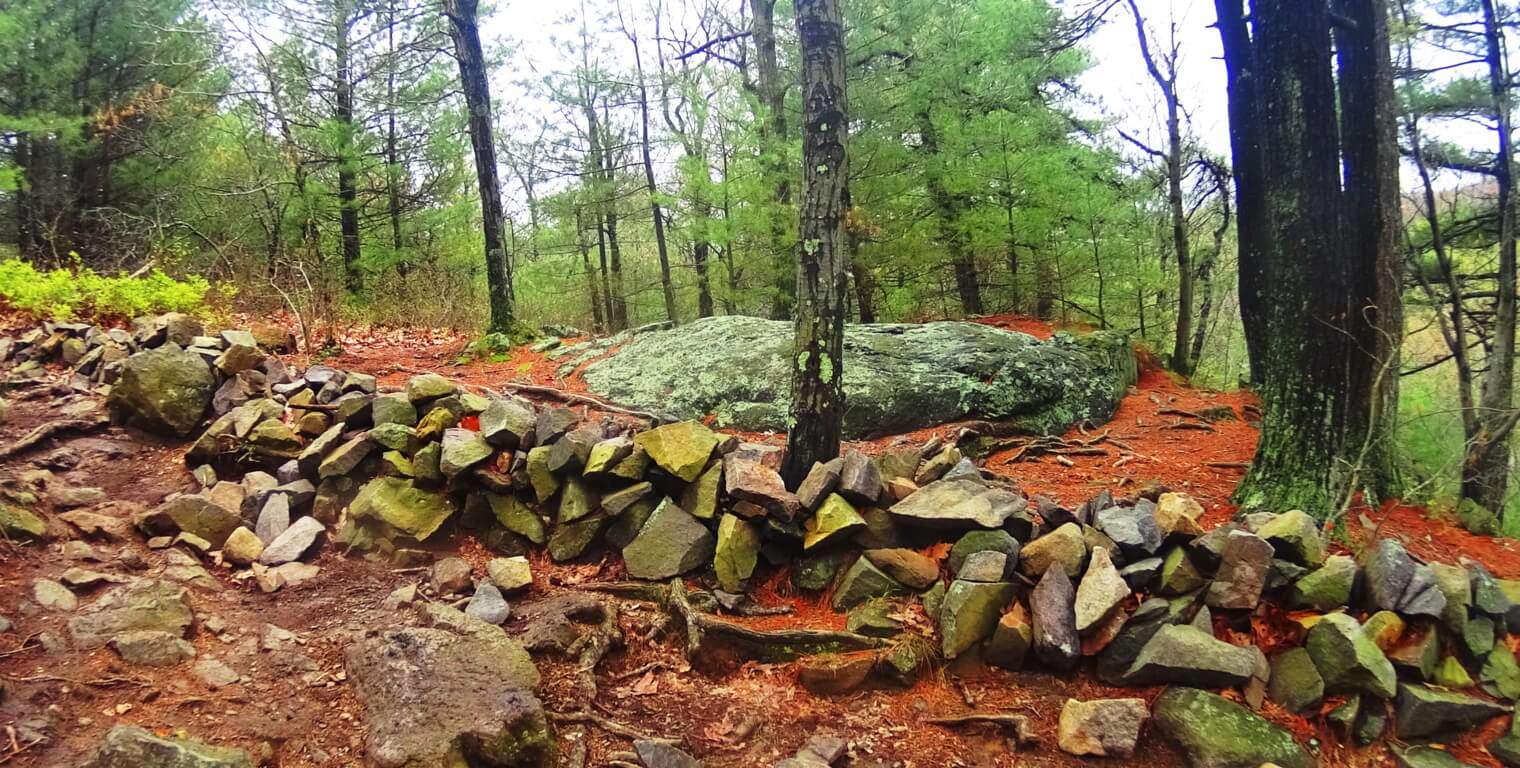 The next Lining is much more substantial, and running straight up the side of one of the small mountains at Blue Hills. There are literally hundreds of these Linings, requiring more work and tools than any team of New England craftsman could ever in ten lifetimes complete. And where are the tools that quarried and crafted these stones? No signs of them, anywhere.
The next Lining is much more substantial, and running straight up the side of one of the small mountains at Blue Hills. There are literally hundreds of these Linings, requiring more work and tools than any team of New England craftsman could ever in ten lifetimes complete. And where are the tools that quarried and crafted these stones? No signs of them, anywhere.
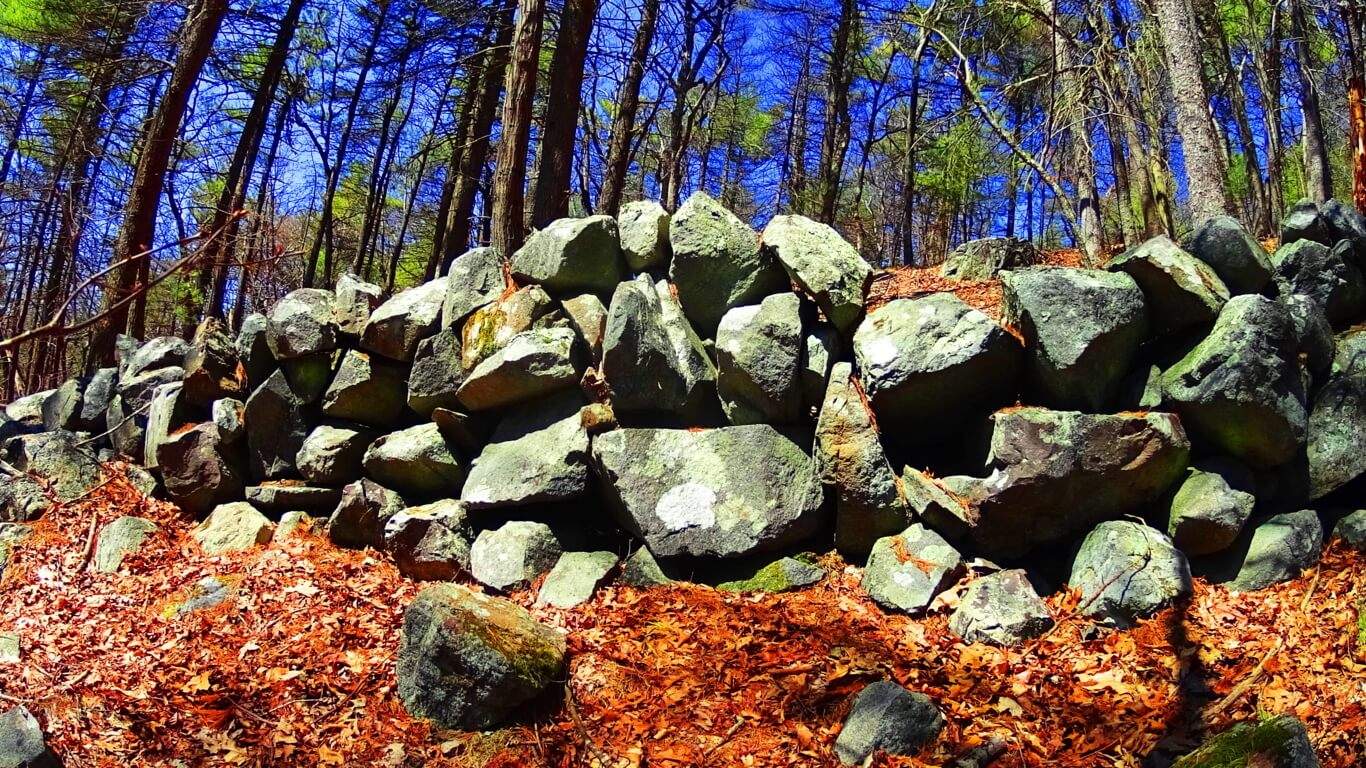 Here is a dizzying look at several Linings zig-zagging up the mountain side just off one of the trails at Blue Hills. I believe that the stones were part of this scene long before the trees were there. At one time, this hillside looked a lot more like Celtic hills, unobstructed visually. It is harder to see megalithic patterns in New England with countless layers of leaves and trees, but there is some kind of pattern here. Its almost as if the entire hillside is a megalithic statement. The picture below is a hill about 100 yards high, with Linings of 100 to 1000 pound stones everywhere. Unreal. A glacier ripping this hillside would’ve discombobulated any pattern in the stones, not stacked them into Linings that looked to modern eyes like dilapidated walls. Ice did not do this.
Here is a dizzying look at several Linings zig-zagging up the mountain side just off one of the trails at Blue Hills. I believe that the stones were part of this scene long before the trees were there. At one time, this hillside looked a lot more like Celtic hills, unobstructed visually. It is harder to see megalithic patterns in New England with countless layers of leaves and trees, but there is some kind of pattern here. Its almost as if the entire hillside is a megalithic statement. The picture below is a hill about 100 yards high, with Linings of 100 to 1000 pound stones everywhere. Unreal. A glacier ripping this hillside would’ve discombobulated any pattern in the stones, not stacked them into Linings that looked to modern eyes like dilapidated walls. Ice did not do this. If you follow the Linings through the woods at Blue Hills you will often come across what look to be megalithic size markers, Standing-stone scale slates or boulders that seem almost decorative, or for marking the territory. Take a look at this 7 foot long, 1 foot thick, slab placed along the Lining by one of the lower trails. It looks to be at least 1 ton in weight (2000 pounds). There are cuts on the lower right side of this slab rendering some kind of meaning. It was clearly placed there. It may mark a certain point of the Sun or Moon along the mountainside, or be indicating a direction to follow, all of which are possibilities that the Megalith builders were absolutely concerned with.
If you follow the Linings through the woods at Blue Hills you will often come across what look to be megalithic size markers, Standing-stone scale slates or boulders that seem almost decorative, or for marking the territory. Take a look at this 7 foot long, 1 foot thick, slab placed along the Lining by one of the lower trails. It looks to be at least 1 ton in weight (2000 pounds). There are cuts on the lower right side of this slab rendering some kind of meaning. It was clearly placed there. It may mark a certain point of the Sun or Moon along the mountainside, or be indicating a direction to follow, all of which are possibilities that the Megalith builders were absolutely concerned with.
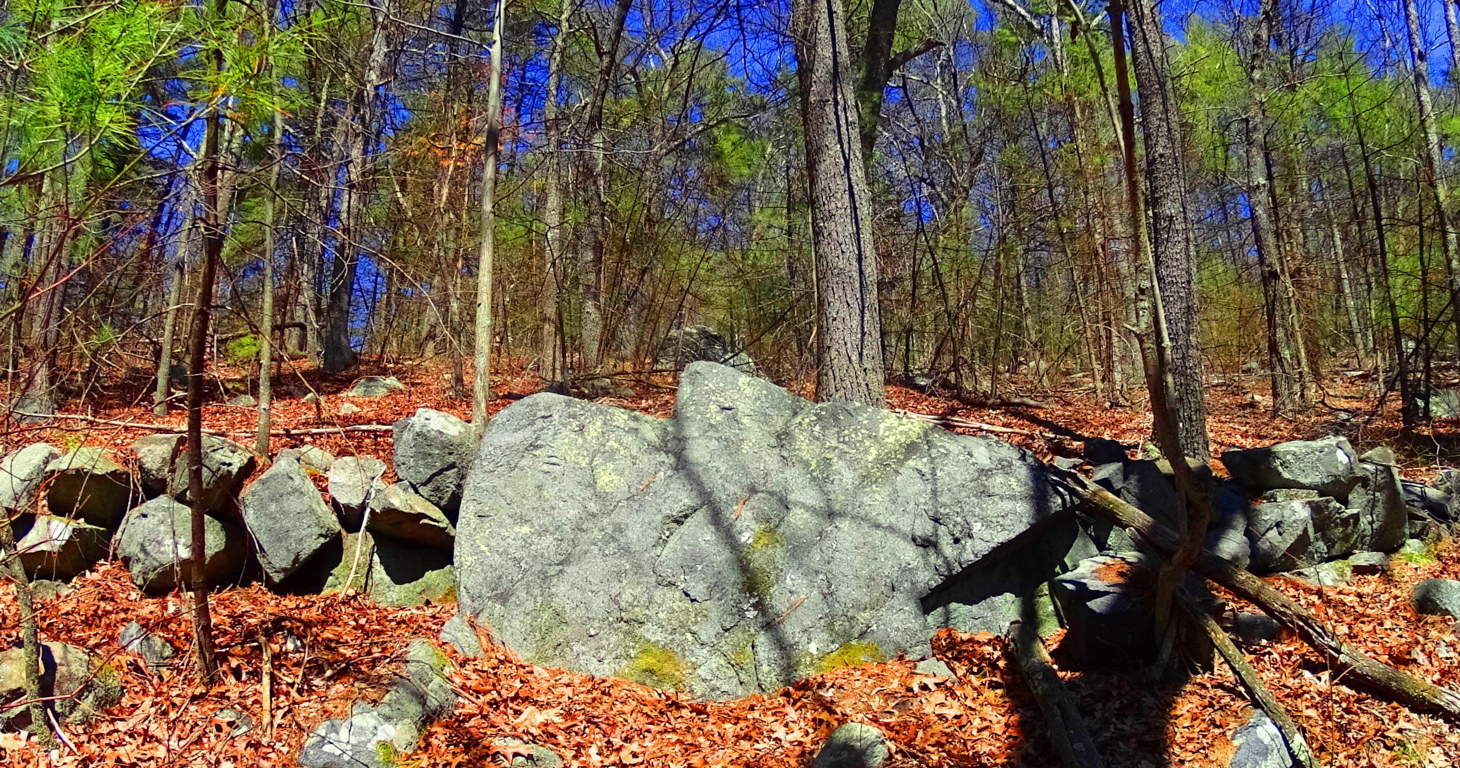 Elevated Trails at Blue Hills: People from this area of New England love hiking here. With all the stonework taking place beneath the trees, it is impossible for a hiker not to be curious what might be taking place at the hilltops, under the Sun. There are trails that loop in a lengthy approach to the smooth stone porches above, but there are also very direct trails with serious inclines that will take you to the best peaks within 15 intense minutes. One peak has a direct view of Boston twenty miles away, with beautiful, Celtic looking, old growth fauna along the ledges (Image below). You can just make out Boston in the distance.
Elevated Trails at Blue Hills: People from this area of New England love hiking here. With all the stonework taking place beneath the trees, it is impossible for a hiker not to be curious what might be taking place at the hilltops, under the Sun. There are trails that loop in a lengthy approach to the smooth stone porches above, but there are also very direct trails with serious inclines that will take you to the best peaks within 15 intense minutes. One peak has a direct view of Boston twenty miles away, with beautiful, Celtic looking, old growth fauna along the ledges (Image below). You can just make out Boston in the distance.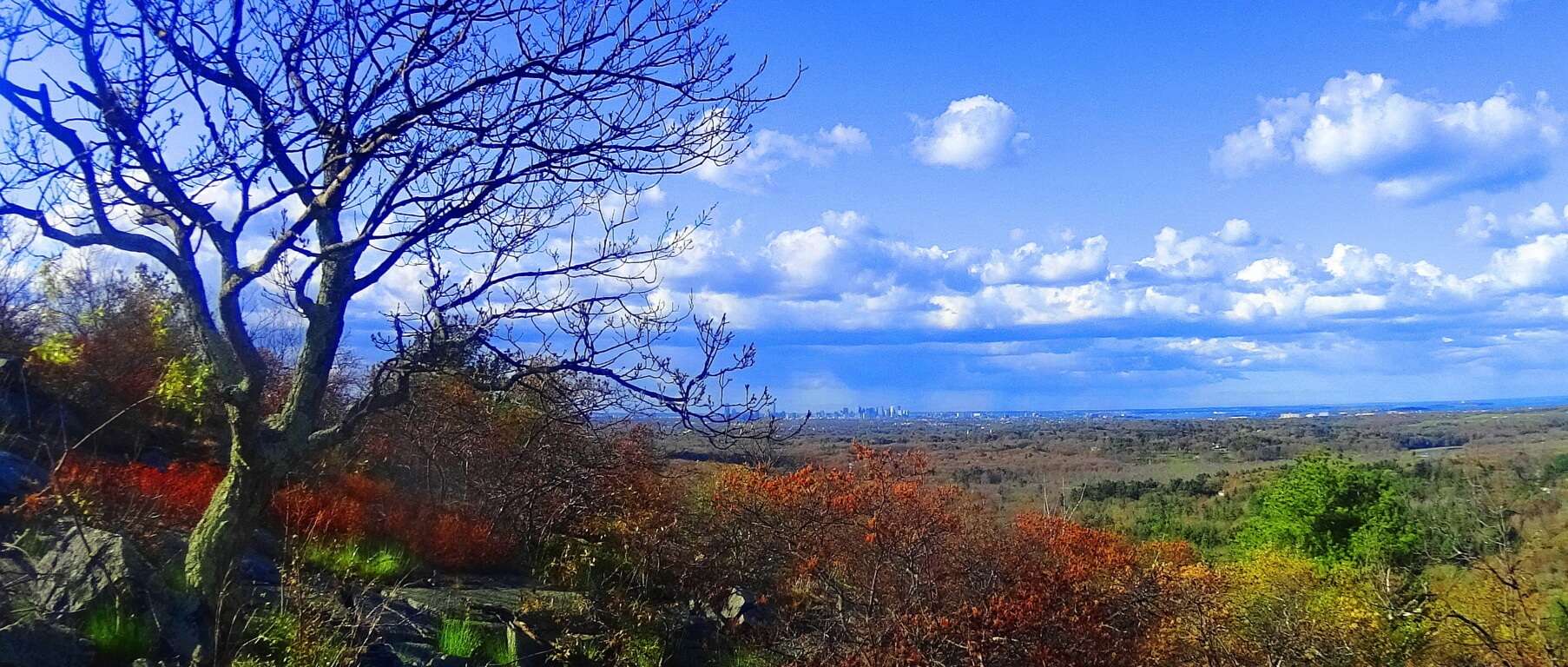 Along these smooth rock porches are stones that are obviously crafted, and serving as markers of some kind. Take a look at these stones on the upper path of “Skyline Trail”, the most popular trail at Blue Hills:
Along these smooth rock porches are stones that are obviously crafted, and serving as markers of some kind. Take a look at these stones on the upper path of “Skyline Trail”, the most popular trail at Blue Hills: 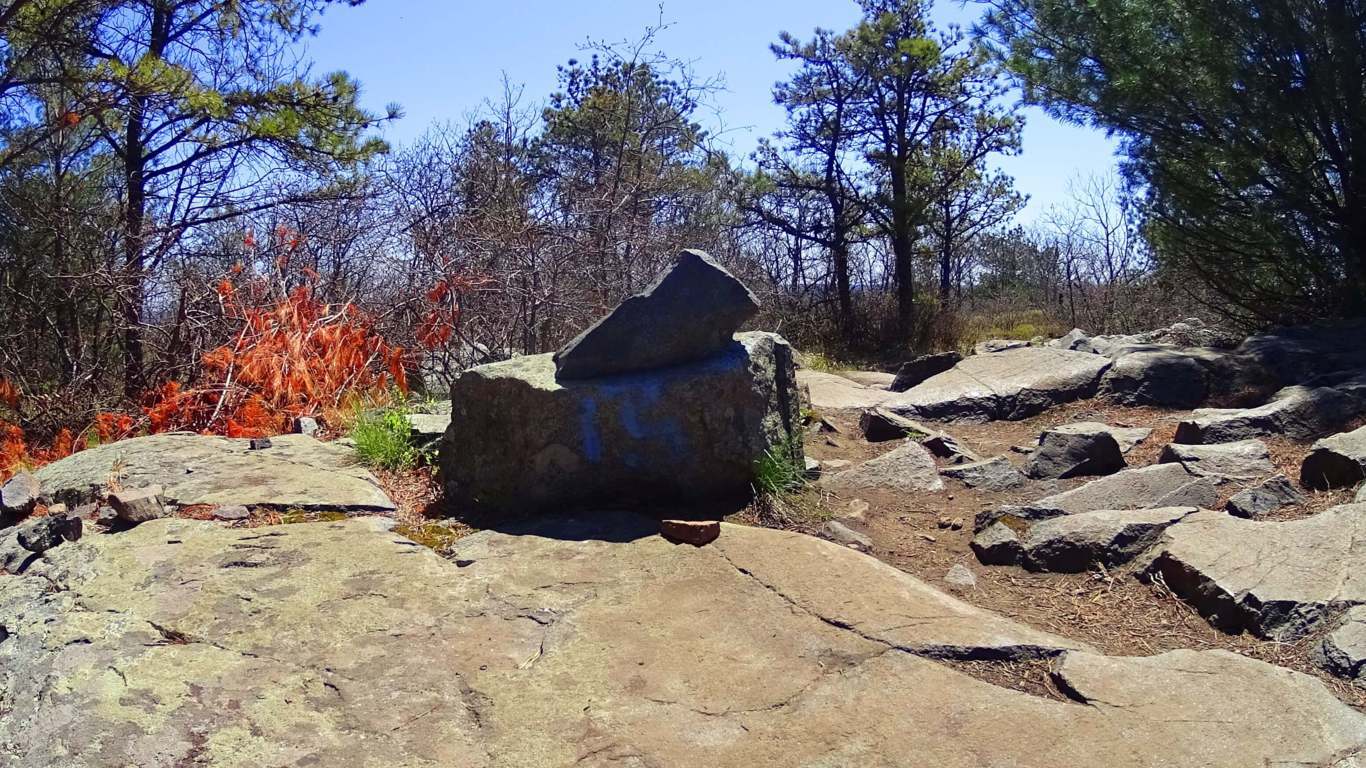 This stone is clearly crafted. Furthermore, looking from this exact stone down the direct path of the trail, are two more crafted, free sitting boulders, perfectly aligned like 1,2,3.
This stone is clearly crafted. Furthermore, looking from this exact stone down the direct path of the trail, are two more crafted, free sitting boulders, perfectly aligned like 1,2,3.
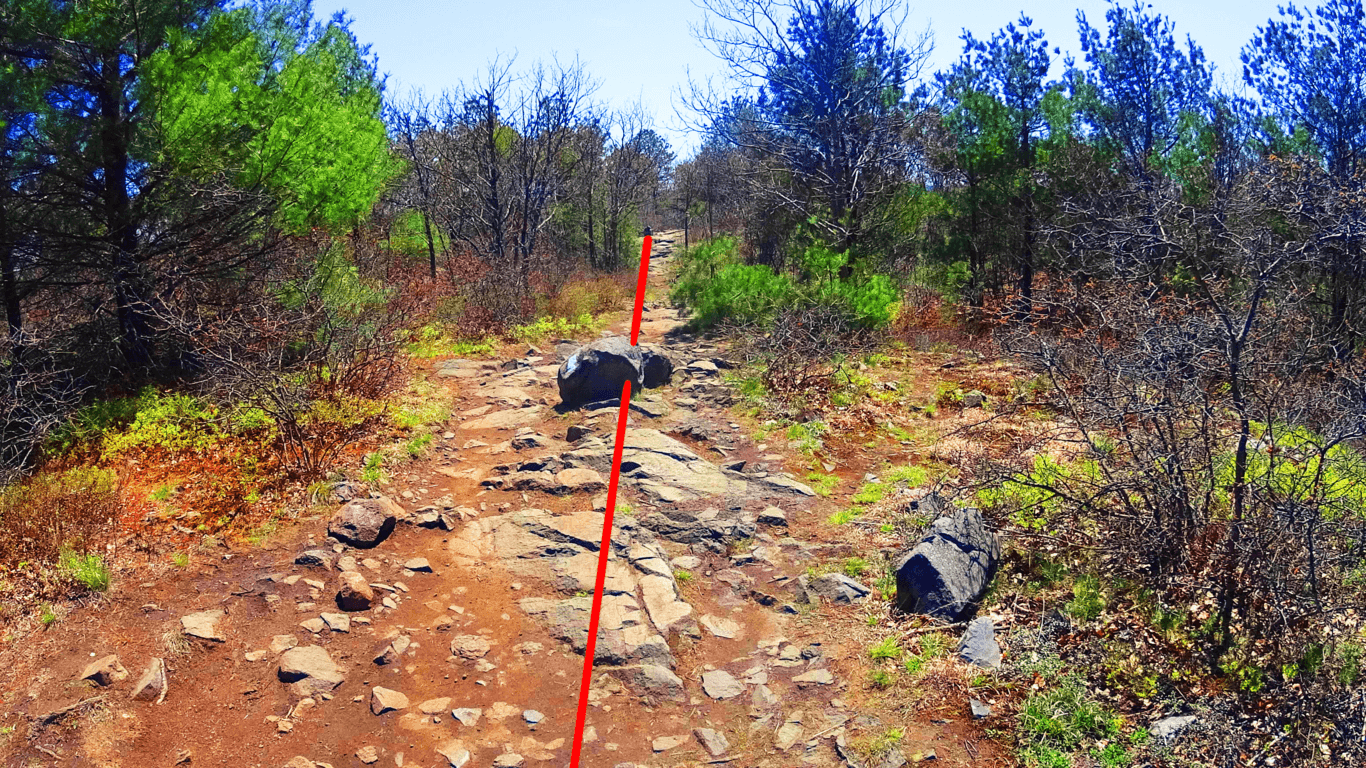 Around this area are also stones that have clearly been cut away from cliff faces. Take a look at these triangular stones, still standing near the exact indents from which they were cut away from.
Around this area are also stones that have clearly been cut away from cliff faces. Take a look at these triangular stones, still standing near the exact indents from which they were cut away from. 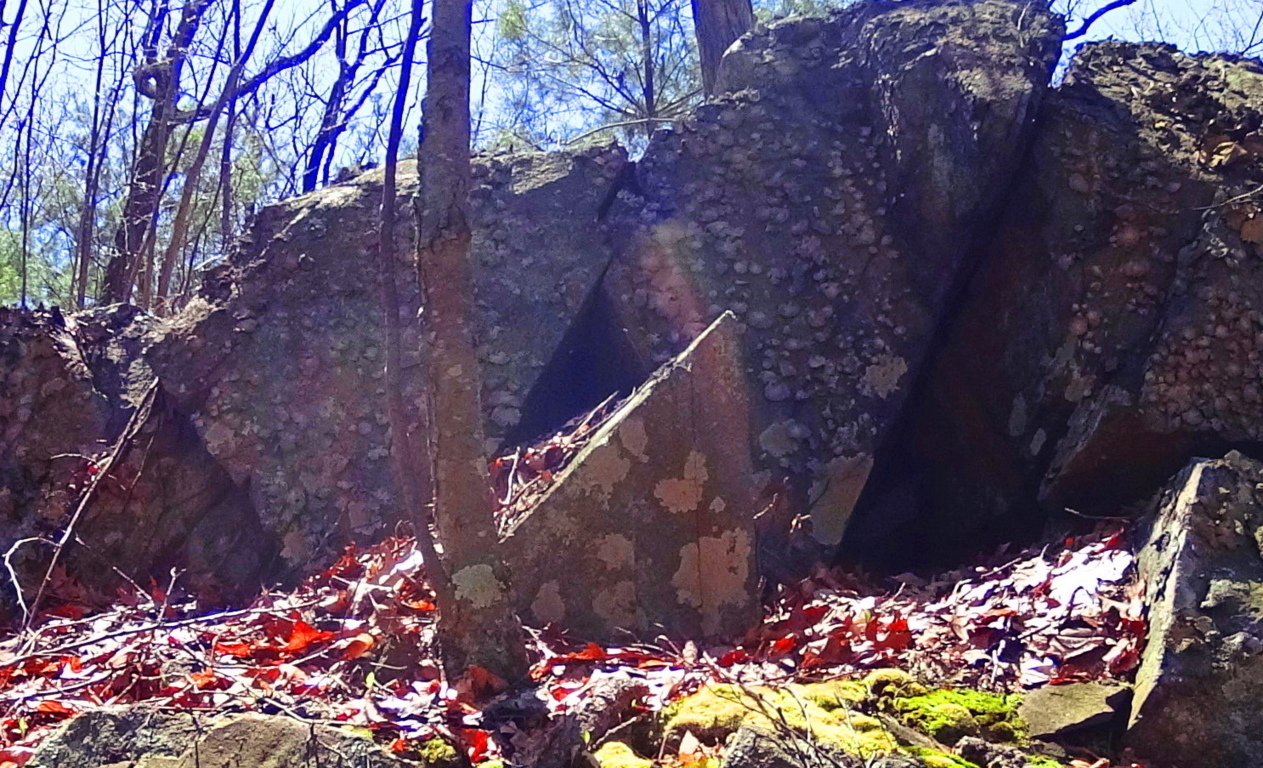 Just for clarity, I highlighted this image so you could see the exact spaces of the cutting, and the right angled triangle stone.
Just for clarity, I highlighted this image so you could see the exact spaces of the cutting, and the right angled triangle stone.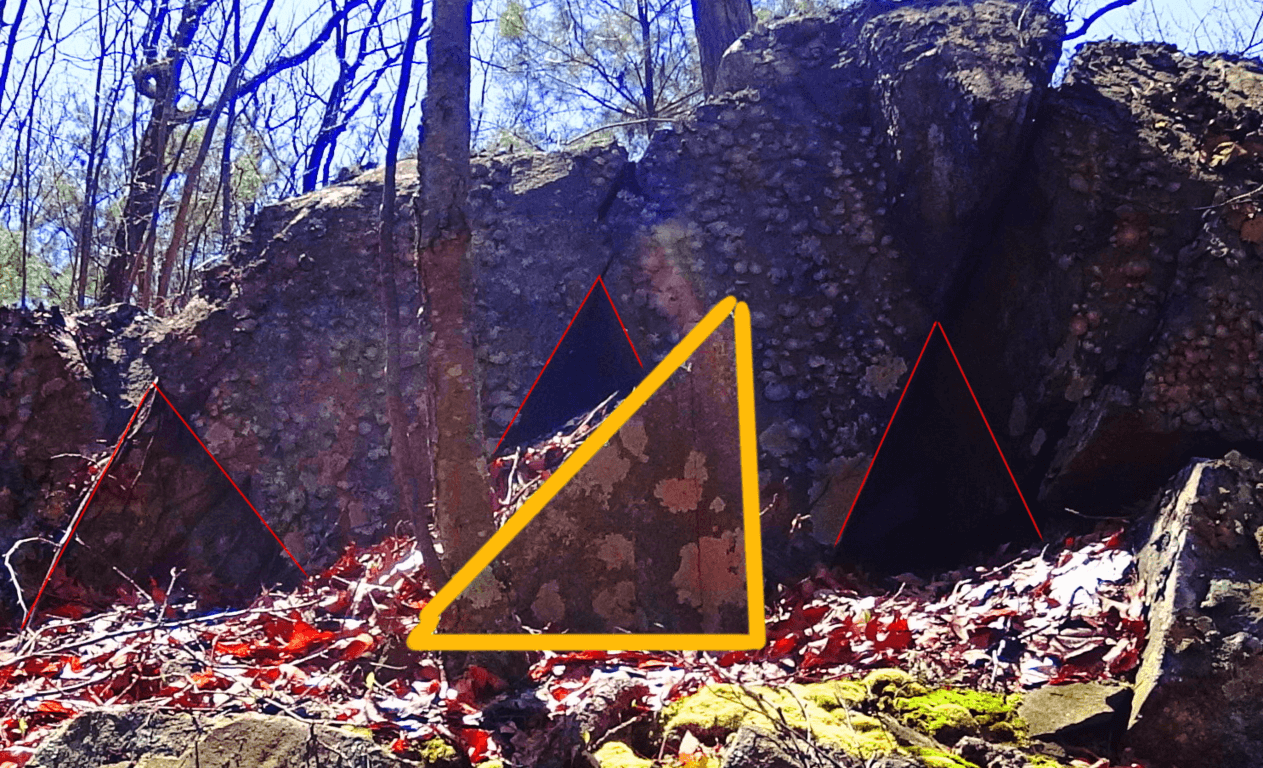 This is evidence of extremely intelligent craftsmanship, conscious of geometric principles. There are also more minor cuts in the stones along the trails, with triangular features. Below is just one example of thousands. They seem directional.
This is evidence of extremely intelligent craftsmanship, conscious of geometric principles. There are also more minor cuts in the stones along the trails, with triangular features. Below is just one example of thousands. They seem directional. 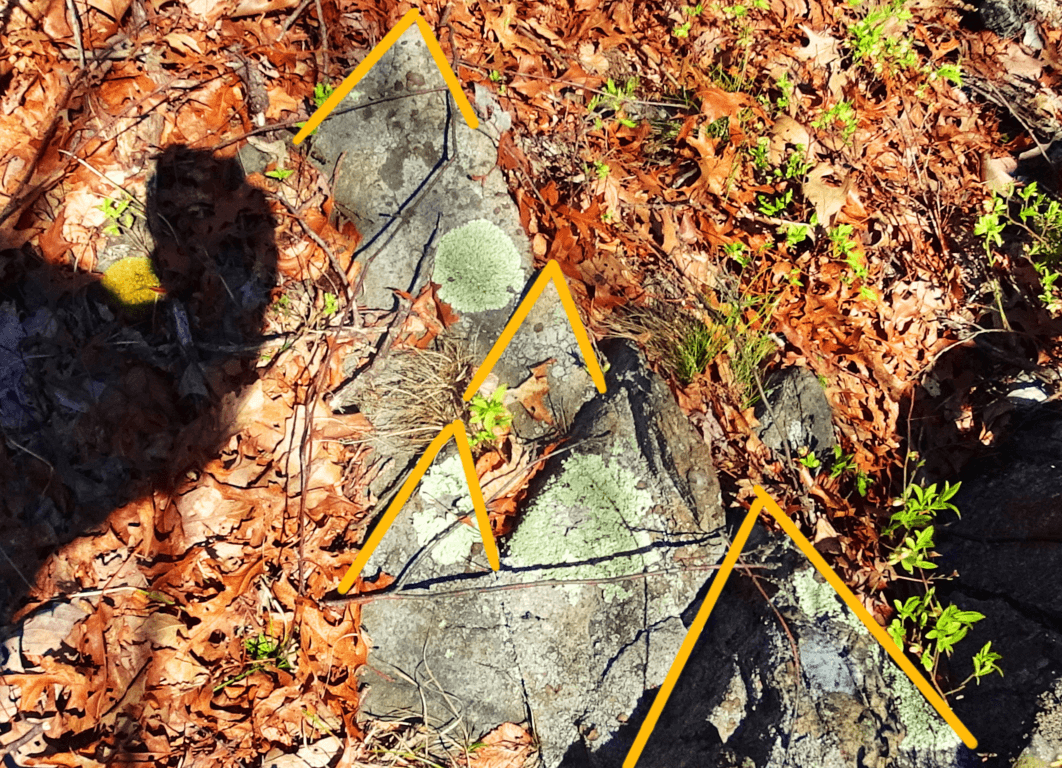 Amazing. The view from the top of Skyline Trail is a classic New England picture. The shadows on the dark granite ledges give a bluish hue to the stones, most likely where the name for this beautiful place derives (top images). We should remember also, that these trails were used by the Native American tribes for thousands of years, before it became “New England”. For the most part, they have taken their sacred knowledge with them into history. Take a hike through the Blue Hills, and see for yourself the unspoken reasons why a community of poor colonial farmers risked their lives against the greatest empire the world had ever known. They knew what we are quickly forgetting, that something entirely mystical took place on this sacred land. Find it, if you can, and go strong.
Amazing. The view from the top of Skyline Trail is a classic New England picture. The shadows on the dark granite ledges give a bluish hue to the stones, most likely where the name for this beautiful place derives (top images). We should remember also, that these trails were used by the Native American tribes for thousands of years, before it became “New England”. For the most part, they have taken their sacred knowledge with them into history. Take a hike through the Blue Hills, and see for yourself the unspoken reasons why a community of poor colonial farmers risked their lives against the greatest empire the world had ever known. They knew what we are quickly forgetting, that something entirely mystical took place on this sacred land. Find it, if you can, and go strong.
Sculptured Rocks Reserve/Groton, New Hampshire/U.S.A
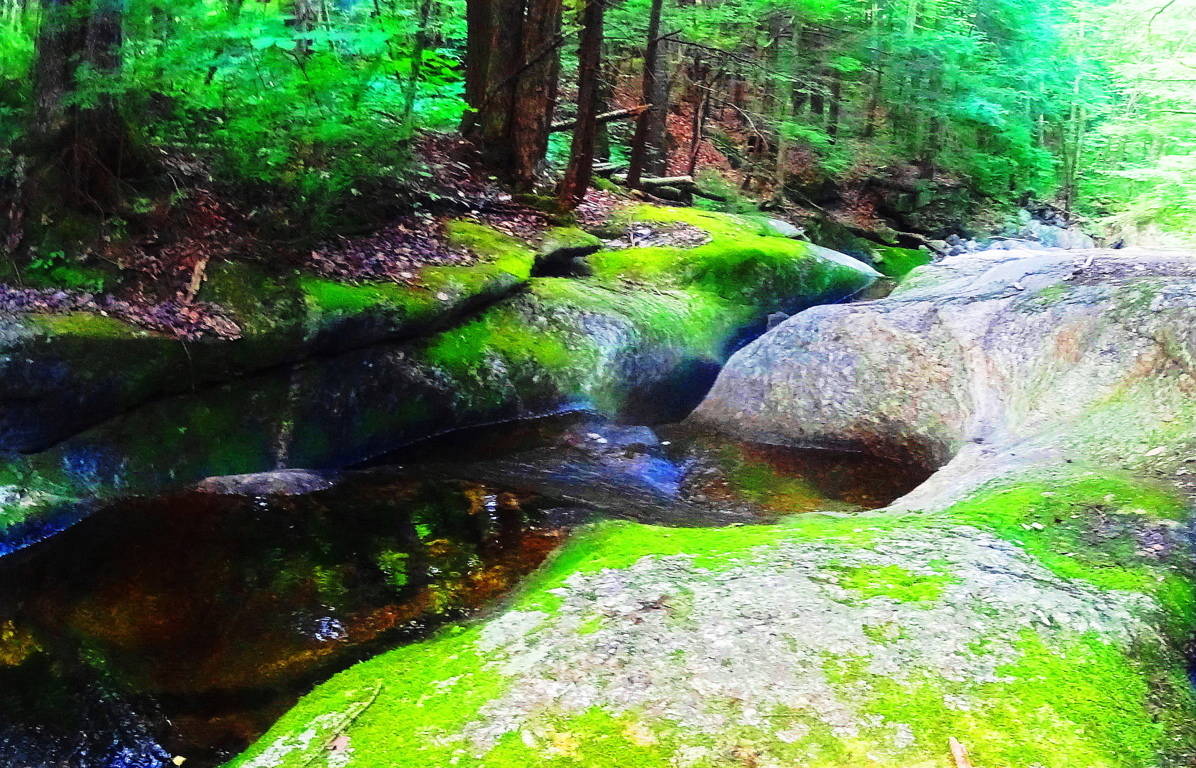 Location: Cockermouth River, Groton New Hampshire
Location: Cockermouth River, Groton New Hampshire
Note: Sculptured Rock Natural Reserve is a watery wonderland of falls rushing within the forests and small mountains of Groton New Hampshire. A hiker has the option of following the falls as far as they wish by hopping from stone to stone, or perhaps stopping to splash around in the amazing still pools created by the rocks.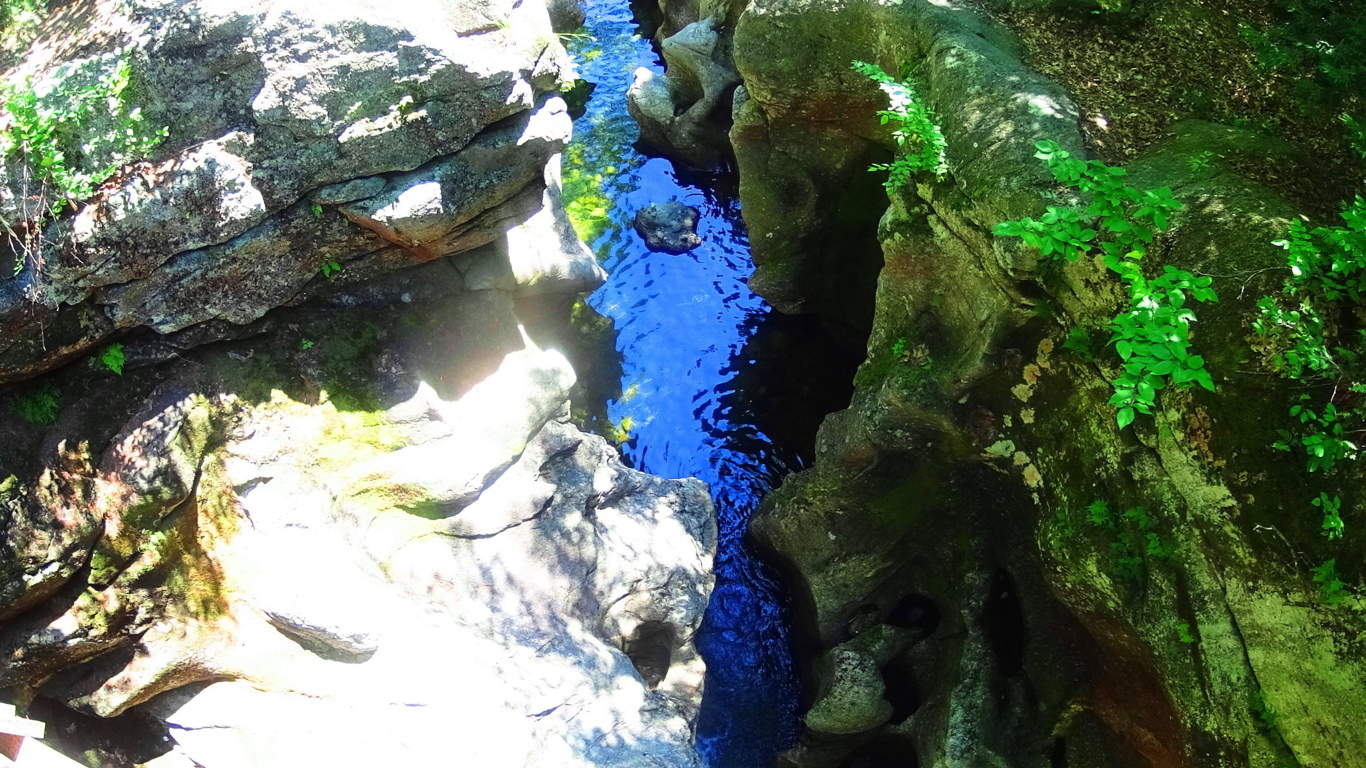 Trails also run away from the fall into the forest, where other works of ancient stone and crafting can be found, such as Cairns, and ‘directional stones’ from another epoch. The area is a notable anthropological site, with an authentic ancient stone dwelling nestled close to the designated forest trail, and several massive stone enclosures of megalithic scale further down the fall to the south.
Trails also run away from the fall into the forest, where other works of ancient stone and crafting can be found, such as Cairns, and ‘directional stones’ from another epoch. The area is a notable anthropological site, with an authentic ancient stone dwelling nestled close to the designated forest trail, and several massive stone enclosures of megalithic scale further down the fall to the south. 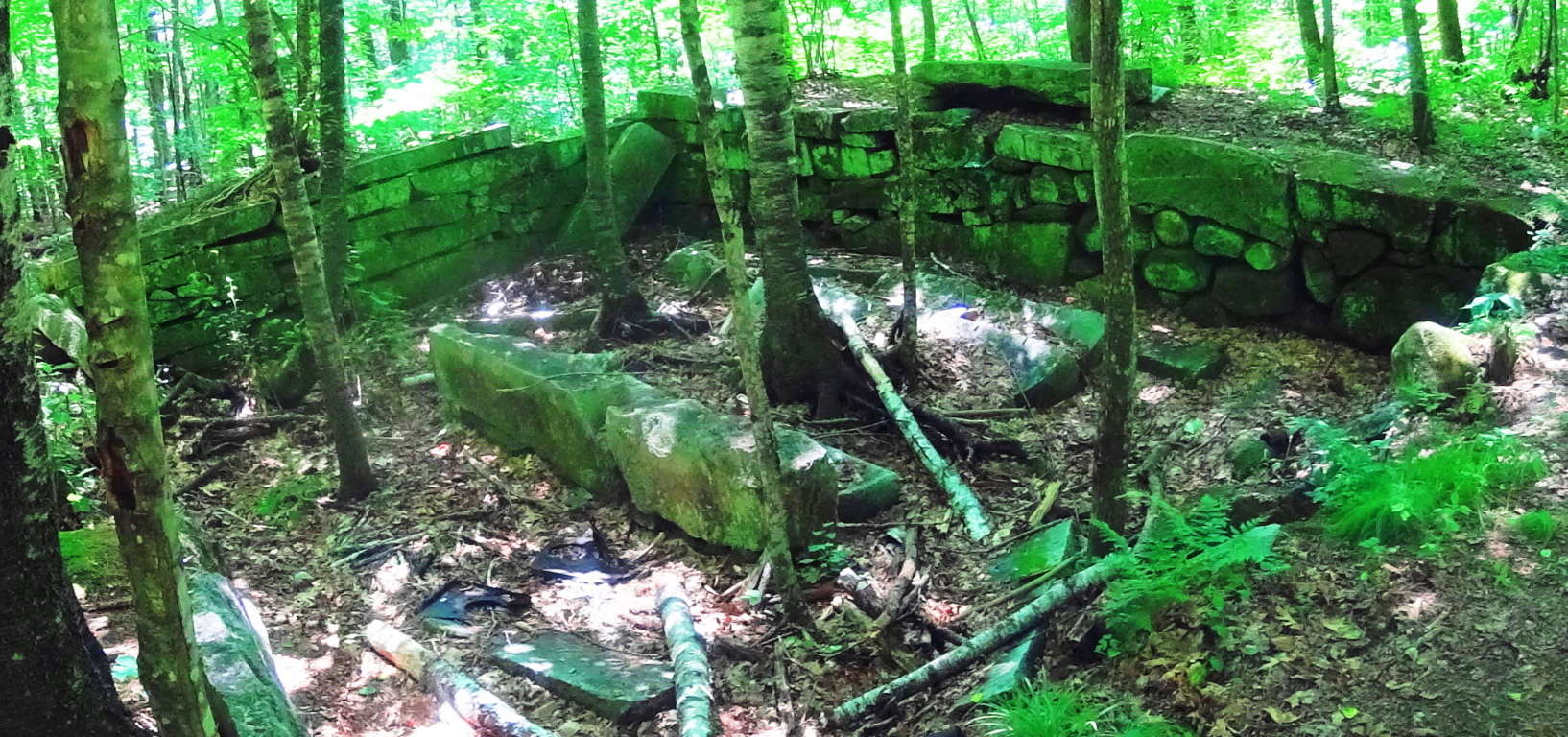 I believe these works, due to their scale and placement, to be PRE Native American, built by a culture yet to be acknowledged by current anthropological historians.
I believe these works, due to their scale and placement, to be PRE Native American, built by a culture yet to be acknowledged by current anthropological historians.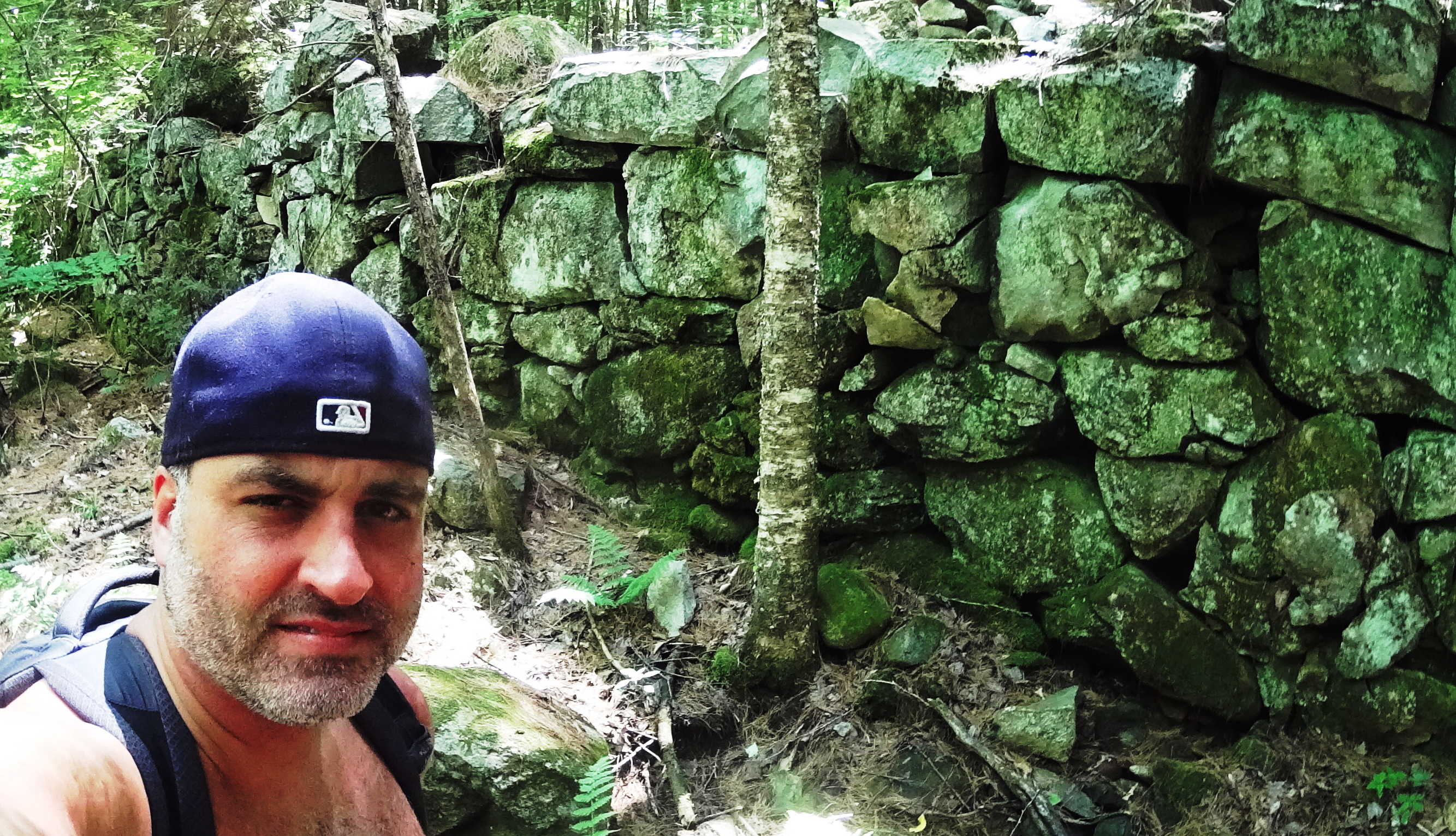 The main water artery, the Cockermouth River, is filled with free standing boulders that sit in an incredibly smooth stone tunnel of what looks to be sculpted rocks. This is very similar to the style of many free standing boulders in Northern Ireland’s rivers, but on a much larger scale. There are literally thousands of these free standing boulders. Away from the Cockermouth River, further north, are several wild rivers without trails running up small mountains enclosing the area.
The main water artery, the Cockermouth River, is filled with free standing boulders that sit in an incredibly smooth stone tunnel of what looks to be sculpted rocks. This is very similar to the style of many free standing boulders in Northern Ireland’s rivers, but on a much larger scale. There are literally thousands of these free standing boulders. Away from the Cockermouth River, further north, are several wild rivers without trails running up small mountains enclosing the area.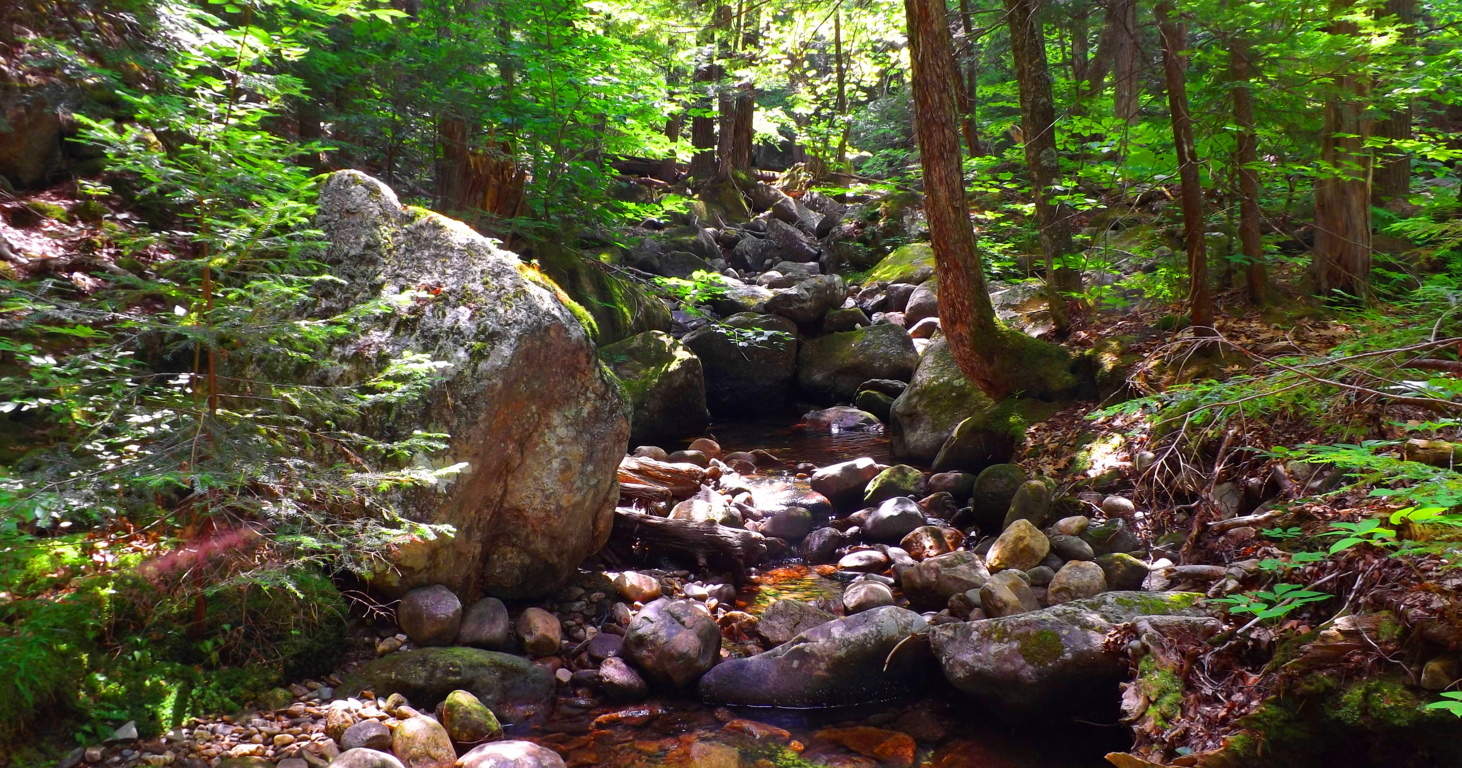 For an experienced and prepared hiker, I recommend the very real adventure of following a waterfall up the mountain by stepping on its stones. Following small mountain falls is an amazing experience due to the fact that the features of the fall become increasingly impressive the higher up you go. Wide stone porches and steps that look to be carved right out of the mountain support fully flowing falls that dance down the stones. Somehow these features leave plenty of dry space along the way, allowing for great footing beside stone porches and pools while ascending the fall.
For an experienced and prepared hiker, I recommend the very real adventure of following a waterfall up the mountain by stepping on its stones. Following small mountain falls is an amazing experience due to the fact that the features of the fall become increasingly impressive the higher up you go. Wide stone porches and steps that look to be carved right out of the mountain support fully flowing falls that dance down the stones. Somehow these features leave plenty of dry space along the way, allowing for great footing beside stone porches and pools while ascending the fall.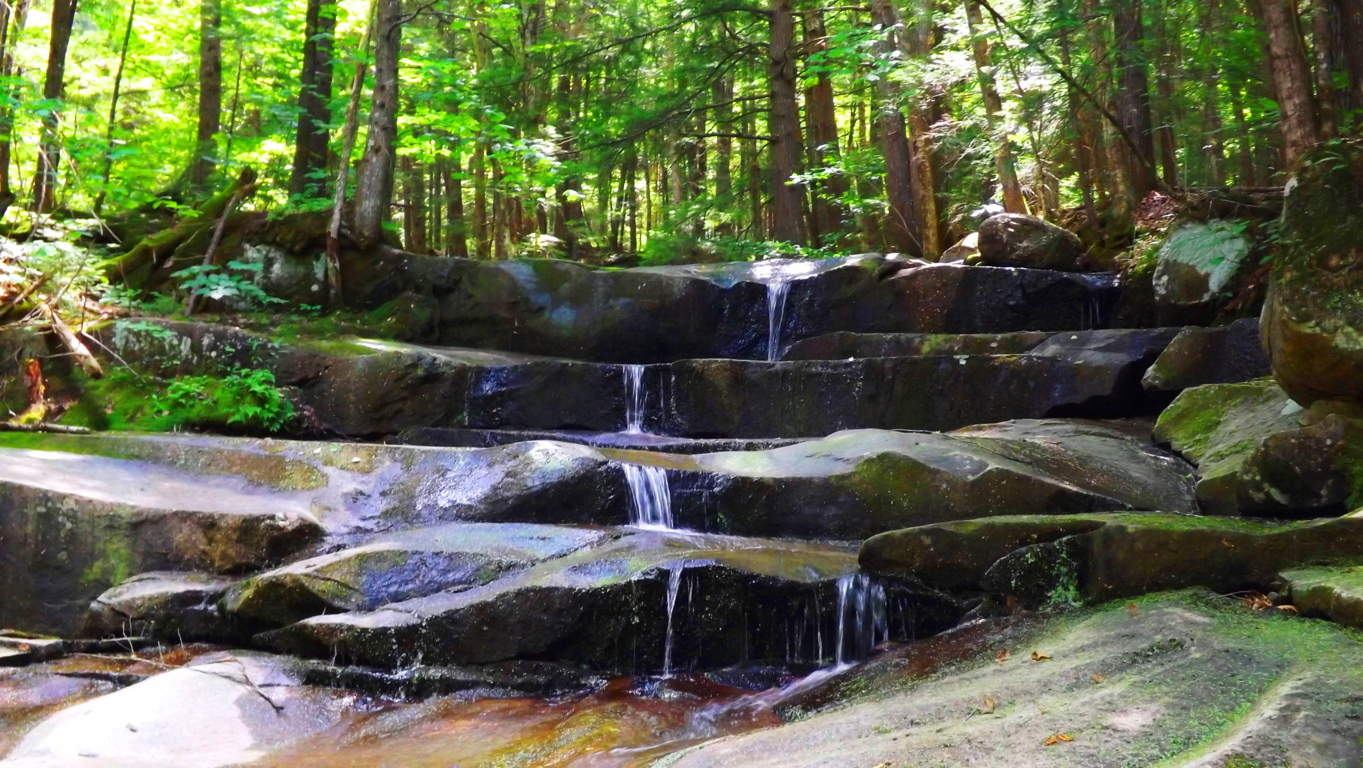 One of the best parts of following a wild fall in New Hampshire is the option to jump in, or plop down in the middle of water-slide like tube of water-flow, and cool down along the way.
One of the best parts of following a wild fall in New Hampshire is the option to jump in, or plop down in the middle of water-slide like tube of water-flow, and cool down along the way.  The beautiful combination of sculpted waterways, dynamic waterfalls, ancient forestry/ stonework, literally from the beginning of time, make Sculptured Rock Reserve one of the best kept secrets for outdoor enthusiasts. It is one part water-filled canyon, another part Celtic rock haven, with waterfalls that truly spark the imagination. Sculptured Rock has a sacred feel. Seek it out.
The beautiful combination of sculpted waterways, dynamic waterfalls, ancient forestry/ stonework, literally from the beginning of time, make Sculptured Rock Reserve one of the best kept secrets for outdoor enthusiasts. It is one part water-filled canyon, another part Celtic rock haven, with waterfalls that truly spark the imagination. Sculptured Rock has a sacred feel. Seek it out.
